
HARARE, ZIMBABWE, 24 JUNE 2018: Pangolin caregivers at an anonymous farm care for rescued pangolins, helping them to find ants and termites to eat and keeping them safe from predators and poachers. The Tiki Hywood trust undertakes public awareness campaigns on Pangolins, trains law enforcement and judiciary personnel, conducts research, and rehabilitates pangolins that have been confiscated from the illegal trade. They are based in Zimbabwe but operate with partners across Africa and advise in Asia. Founder Lisa Hywood is seen as a global expert on how to care for Pangolins in captivity. The trust also engages with other organisations and governments throughout Africa to highlight the plight of pangolins, raising awareness of their conservation status and educating them as to the need for conserving pangolins, as well as implementing conservation actions. Many of their activities are not covered by research grants and they rely on sponsors and donations to continue their work. Donations are used to train law enforcement and judiciary personnel, rehabilitate confiscated pangolins, raise public awareness and further engage with African role-players to increase the conservation status of pangolins across Africa.The Pangolin is a solitary, primarily nocturnal animal, they are easily recognized by their full armour of large, plate-like scales. A startled pangolin will cover its head with its front legs, exposing its scales to any potential predator. If touched or grabbed it will roll up completely into a ball, while the sharp scales on the tail can be used to lash out.Pangolins are also mammals just like humans, giving birth to live offspring and feeding them milk. The Pangolin uses its powerful front claws to dig open termite mounds and uses its long sticky tong to catch ants and termites which it feeds on, although they supplement this diet with other invertebrates. There are eight species of pangolins in the world, four of these are found on the African continent, na
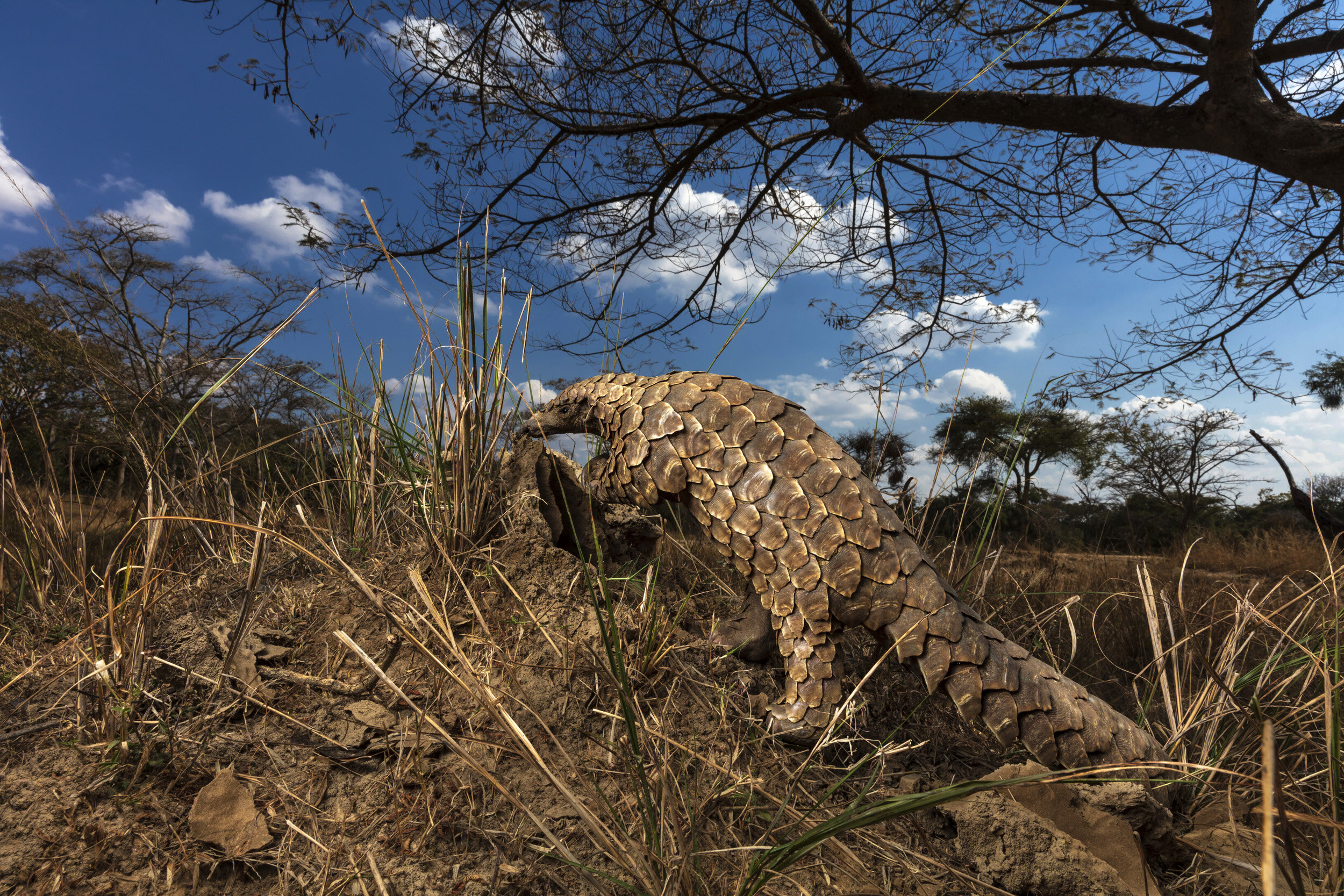
HARARE, ZIMBABWE, 24 JUNE 2018: Pangolin caregivers at an anonymous farm care for rescued pangolins, helping them to find ants and termites to eat and keeping them safe from predators and poachers. The Tiki Hywood trust undertakes public awareness campaigns on Pangolins, trains law enforcement and judiciary personnel, conducts research, and rehabilitates pangolins that have been confiscated from the illegal trade. They are based in Zimbabwe but operate with partners across Africa and advise in Asia. Founder Lisa Hywood is seen as a global expert on how to care for Pangolins in captivity. The trust also engages with other organisations and governments throughout Africa to highlight the plight of pangolins, raising awareness of their conservation status and educating them as to the need for conserving pangolins, as well as implementing conservation actions. Many of their activities are not covered by research grants and they rely on sponsors and donations to continue their work. Donations are used to train law enforcement and judiciary personnel, rehabilitate confiscated pangolins, raise public awareness and further engage with African role-players to increase the conservation status of pangolins across Africa.The Pangolin is a solitary, primarily nocturnal animal, they are easily recognized by their full armour of large, plate-like scales. A startled pangolin will cover its head with its front legs, exposing its scales to any potential predator. If touched or grabbed it will roll up completely into a ball, while the sharp scales on the tail can be used to lash out.Pangolins are also mammals just like humans, giving birth to live offspring and feeding them milk. The Pangolin uses its powerful front claws to dig open termite mounds and uses its long sticky tong to catch ants and termites which it feeds on, although they supplement this diet with other invertebrates. There are eight species of pangolins in the world, four of these are found on the African continent, na
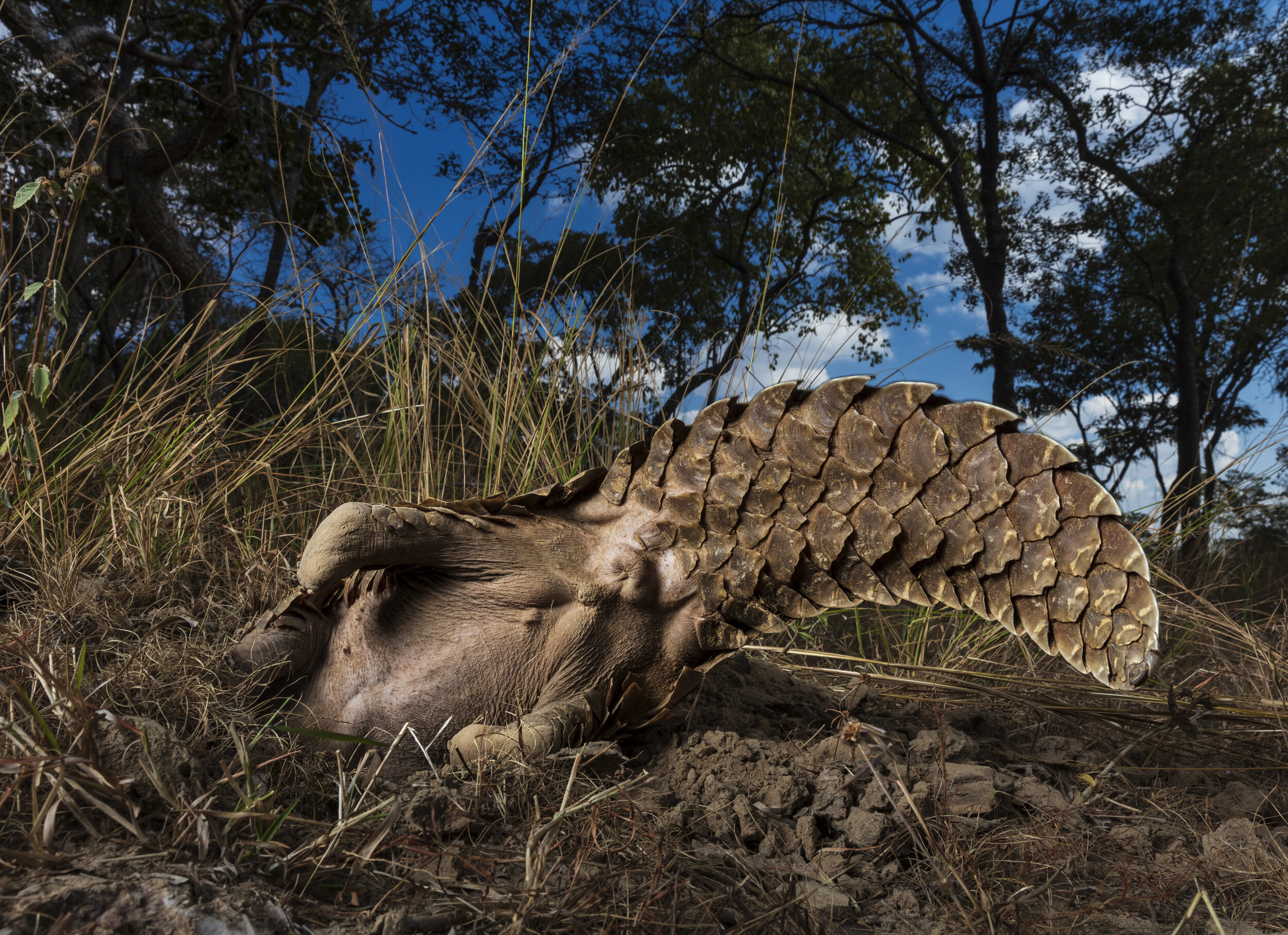
HARARE, ZIMBABWE, 24 JUNE 2018: Pangolin caregivers at an anonymous farm care for rescued pangolins, helping them to find ants and termites to eat and keeping them safe from predators and poachers. The Tiki Hywood trust undertakes public awareness campaigns on Pangolins, trains law enforcement and judiciary personnel, conducts research, and rehabilitates pangolins that have been confiscated from the illegal trade. They are based in Zimbabwe but operate with partners across Africa and advise in Asia. Founder Lisa Hywood is seen as a global expert on how to care for Pangolins in captivity. The trust also engages with other organisations and governments throughout Africa to highlight the plight of pangolins, raising awareness of their conservation status and educating them as to the need for conserving pangolins, as well as implementing conservation actions. Many of their activities are not covered by research grants and they rely on sponsors and donations to continue their work. Donations are used to train law enforcement and judiciary personnel, rehabilitate confiscated pangolins, raise public awareness and further engage with African role-players to increase the conservation status of pangolins across Africa.The Pangolin is a solitary, primarily nocturnal animal, they are easily recognized by their full armour of large, plate-like scales. A startled pangolin will cover its head with its front legs, exposing its scales to any potential predator. If touched or grabbed it will roll up completely into a ball, while the sharp scales on the tail can be used to lash out.Pangolins are also mammals just like humans, giving birth to live offspring and feeding them milk. The Pangolin uses its powerful front claws to dig open termite mounds and uses its long sticky tong to catch ants and termites which it feeds on, although they supplement this diet with other invertebrates. There are eight species of pangolins in the world, four of these are found on the African continent, na
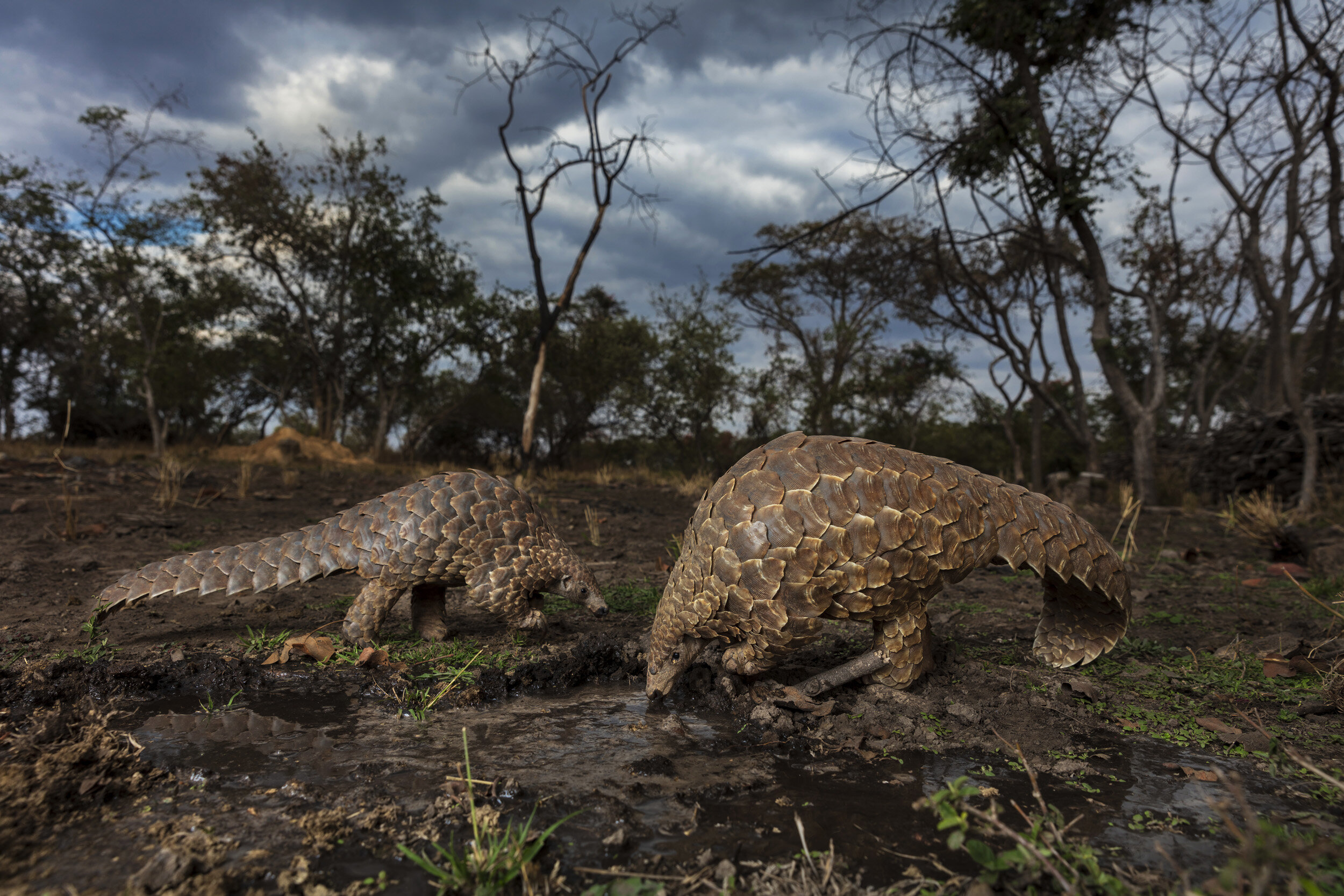
HARARE, ZIMBABWE, 24 JUNE 2018: Pangolin caregivers at an anonymous farm care for rescued pangolins, helping them to find ants and termites to eat and keeping them safe from predators and poachers. The Tiki Hywood trust undertakes public awareness campaigns on Pangolins, trains law enforcement and judiciary personnel, conducts research, and rehabilitates pangolins that have been confiscated from the illegal trade. They are based in Zimbabwe but operate with partners across Africa and advise in Asia. Founder Lisa Hywood is seen as a global expert on how to care for Pangolins in captivity. The trust also engages with other organisations and governments throughout Africa to highlight the plight of pangolins, raising awareness of their conservation status and educating them as to the need for conserving pangolins, as well as implementing conservation actions. Many of their activities are not covered by research grants and they rely on sponsors and donations to continue their work. Donations are used to train law enforcement and judiciary personnel, rehabilitate confiscated pangolins, raise public awareness and further engage with African role-players to increase the conservation status of pangolins across Africa.The Pangolin is a solitary, primarily nocturnal animal, they are easily recognized by their full armour of large, plate-like scales. A startled pangolin will cover its head with its front legs, exposing its scales to any potential predator. If touched or grabbed it will roll up completely into a ball, while the sharp scales on the tail can be used to lash out.Pangolins are also mammals just like humans, giving birth to live offspring and feeding them milk. The Pangolin uses its powerful front claws to dig open termite mounds and uses its long sticky tong to catch ants and termites which it feeds on, although they supplement this diet with other invertebrates. There are eight species of pangolins in the world, four of these are found on the African continent, na
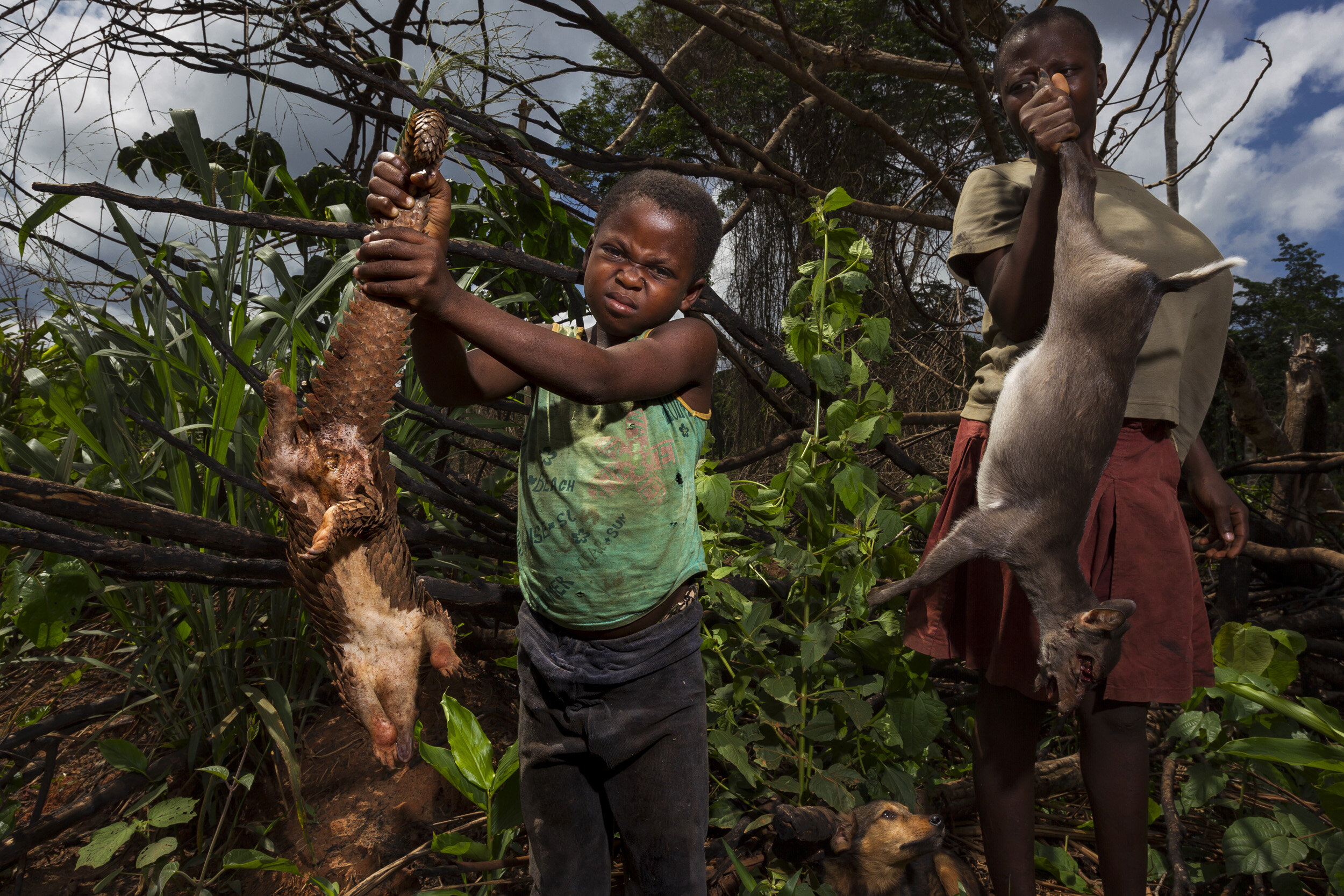
Cameroon, June 4 2010: A young Baka pygmy boy and a women stand by the roadside selling a pangolin and duiker antelope for bushmeat. Pangolin is a common bushmeat species in Cameroon and is the most traded animal in the illegal wildlife trade space. (Photo by Brent Stirton/Getty Images for National Geographic Magazine.)
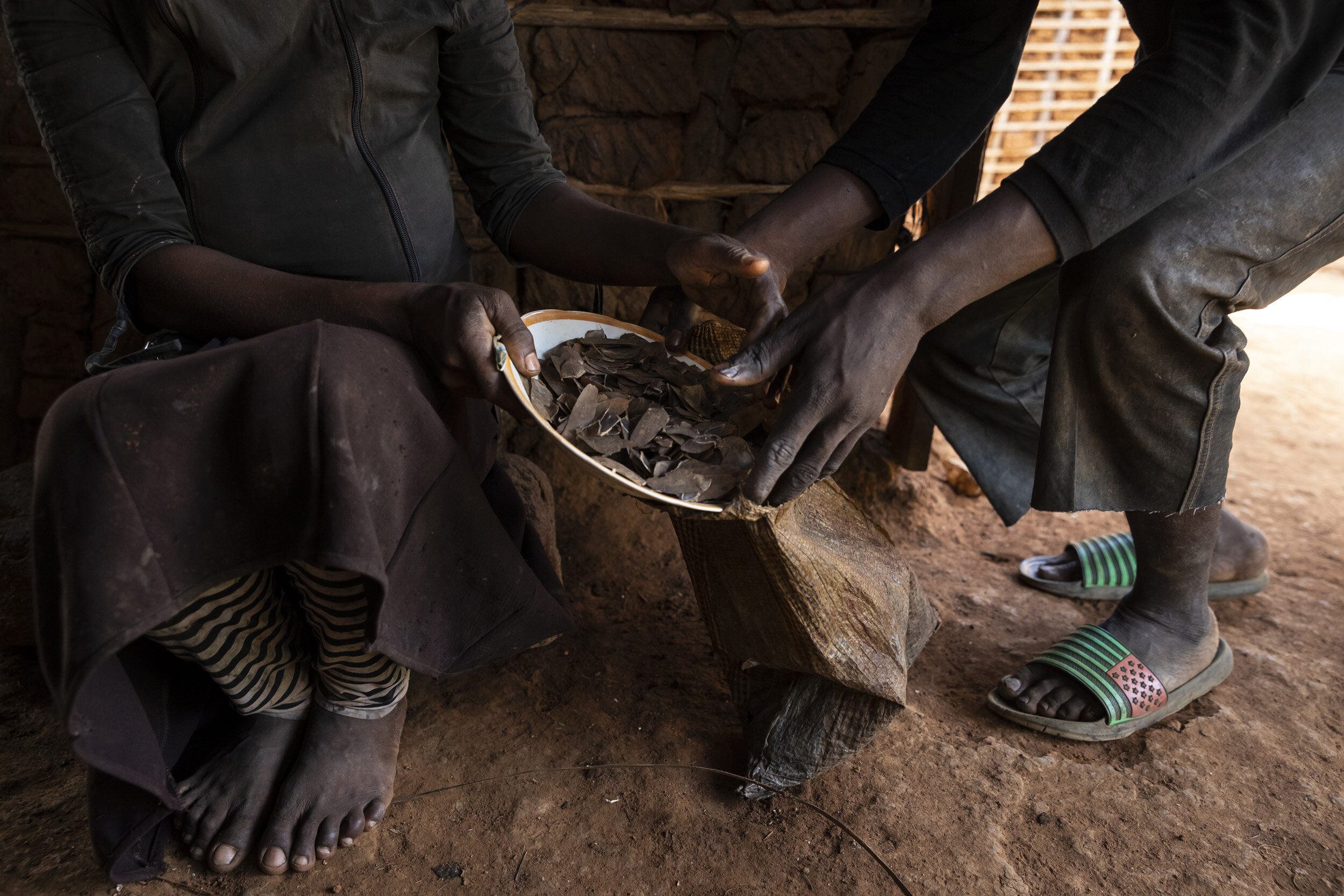
DJA NATIONAL PARK, SALOMA, CAMEROON, 11 AUGUST 2018: A Baka pygmy woman shows pangolin scales she has collected to sell to a Bantu middleman who comes regularly to her village to purchase the scales. She received a sum of $10 for 1kg of scales but has not idea what they are used for. The Baka living inside National Parks in Cameroon have a sustainability allowance which lets them hunt within the park boundaries. They are allowed to hunt Pangolin even thought CITES has listed them as appendix one endangered. The Cameroon government has pending legislation to ban all pangolin hunting but this has not yet passed the house. Bantu middlemen are taking advantage of this loophole for Baka pangolin hunting to buy scales cheaply for Chinese partners in Cameroon, an illegal practise. They will attempt to fly the scales out of Cameroon for traditional Asian medicine. (Photo by Brent Stirton/Getty Images for National Geographic Magazine.)
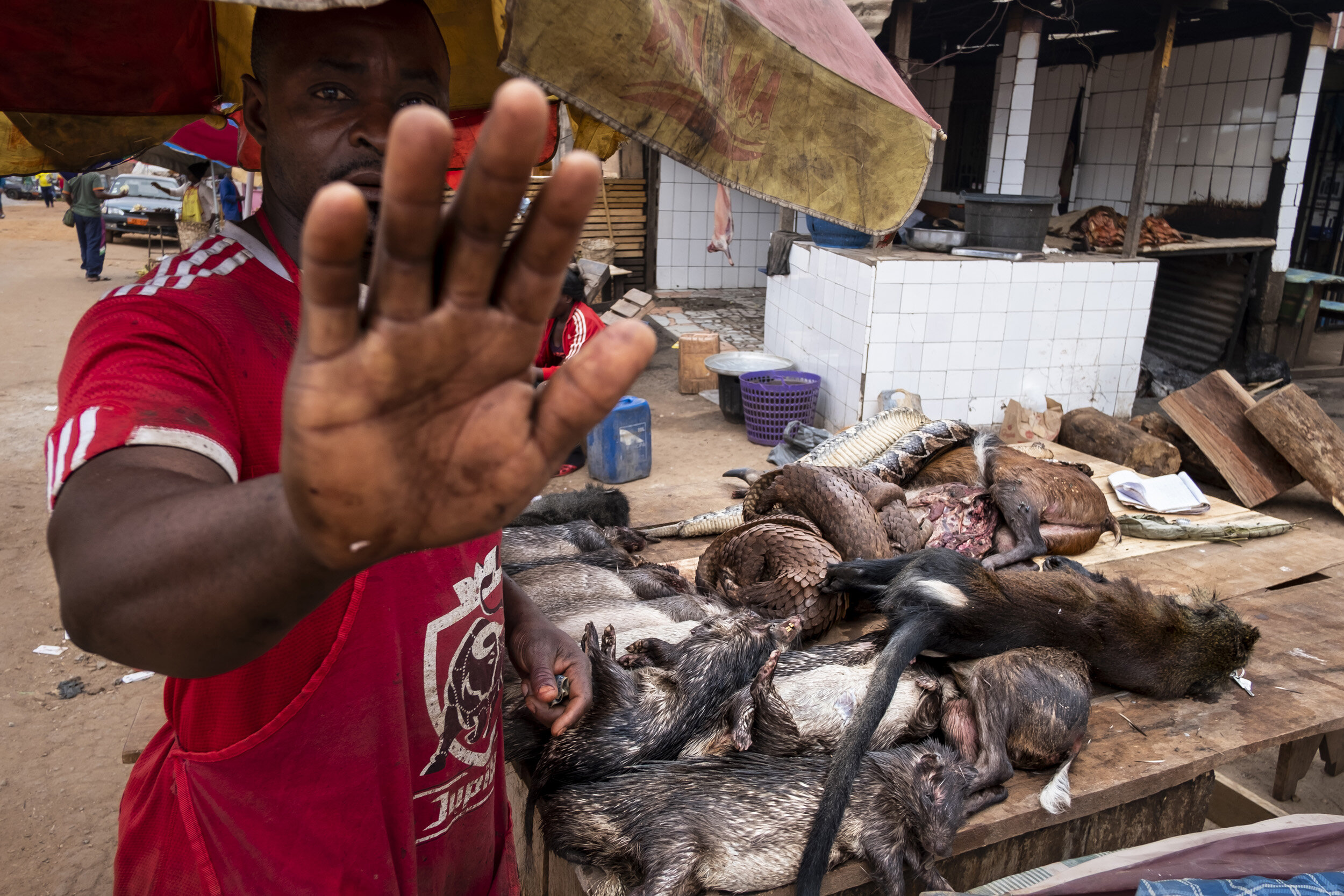
YAONDE, CAMEROON, 8 AUGUST 2018: Four juvenile pangolins for sale in a bushmeat market in Yaonde, Cameroon. Although officially listed as endangered, pangolins are still heavily traded on the bushmeat market in Cameroon, one of the very few countries in the world where they are still relatively easy to find. The scales, highly prized in Asia for traditional medicine, are often kept after consumption and Cameroonian middlemen purchase those for Chinese clients who most often fly them out of the country via corrupt officials and eco guards. (Photo by Brent Stirton/Getty Images for National Geographic Magazine.)
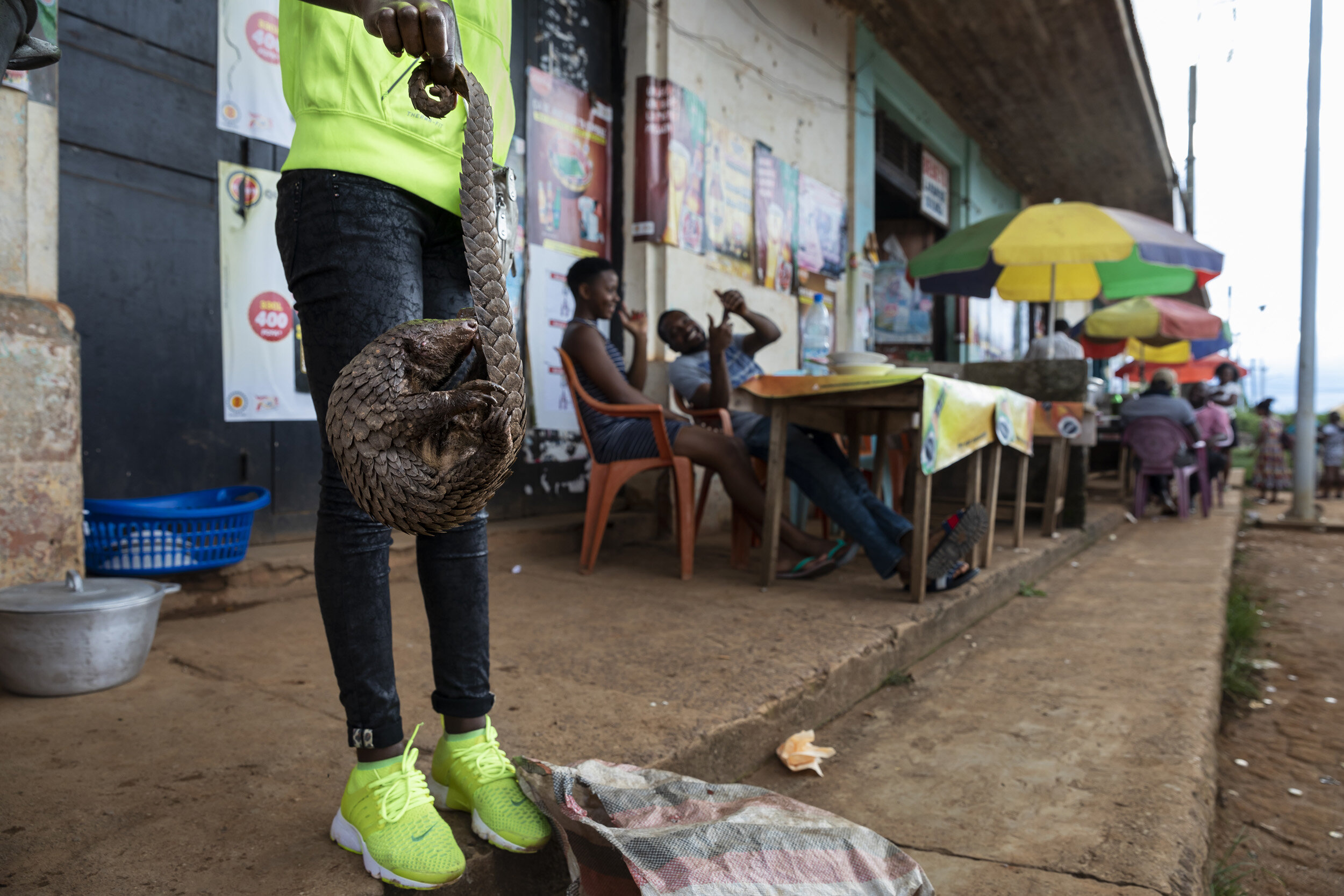
CAMEROON, 12 AUGUST 2018: A young woman who works as a street food trader in a small town 60 miles from Yaonde is seen with a juvenile pangolin which she has purchased from a middleman for $14 who got the pangolin from bushmeat hunters. She is seen with the pangolin at her stall shortly after acquiring the live animal. She then took the animal home and slaughtered it, removing the scales and disecting the body. She says she has been selling scaels for about a year but has been selling pangolin meat for at least 10 years. She adds that it is becoming rarer to find and more expensive. At this time, this is still a legal practise in Cameroon. (Photo by Brent Stirton/Getty Images for National Geographic Magazine.)
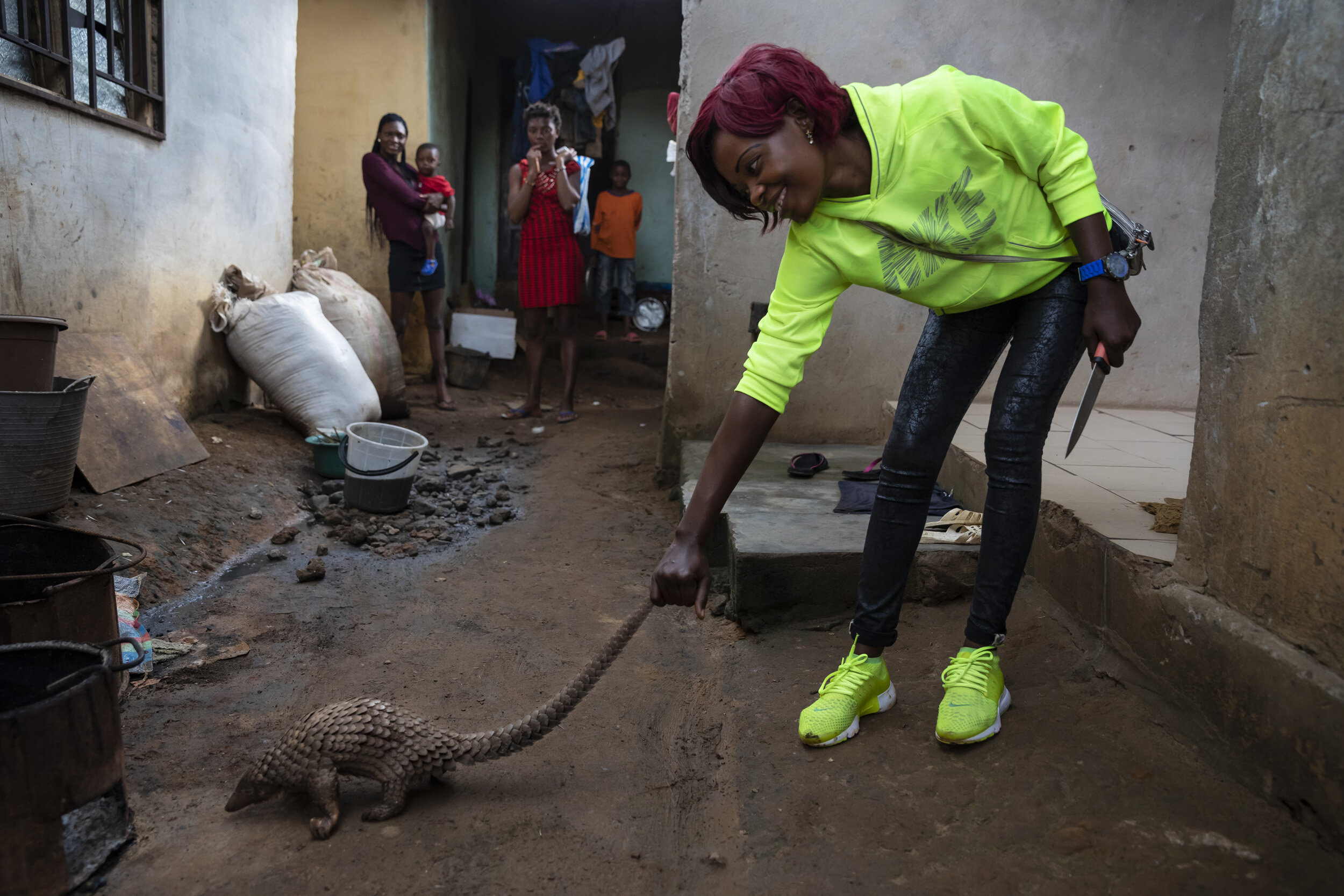
CAMEROON, 12 AUGUST 2018: A young woman who works as a street food trader in a small town 60 miles from Yaonde is seen with a juvenile pangolin which she has purchased from a middleman for $14 who got the pangolin from bushmeat hunters. She is seen with the pangolin at her stall shortly after acquiring the live animal. She then took the animal home and slaughtered it, removing the scales and disecting the body. She says she has been selling scaels for about a year but has been selling pangolin meat for at least 10 years. She adds that it is becoming rarer to find and more expensive. At this time, this is still a legal practise in Cameroon. (Photo by Brent Stirton/Getty Images for National Geographic Magazine.)
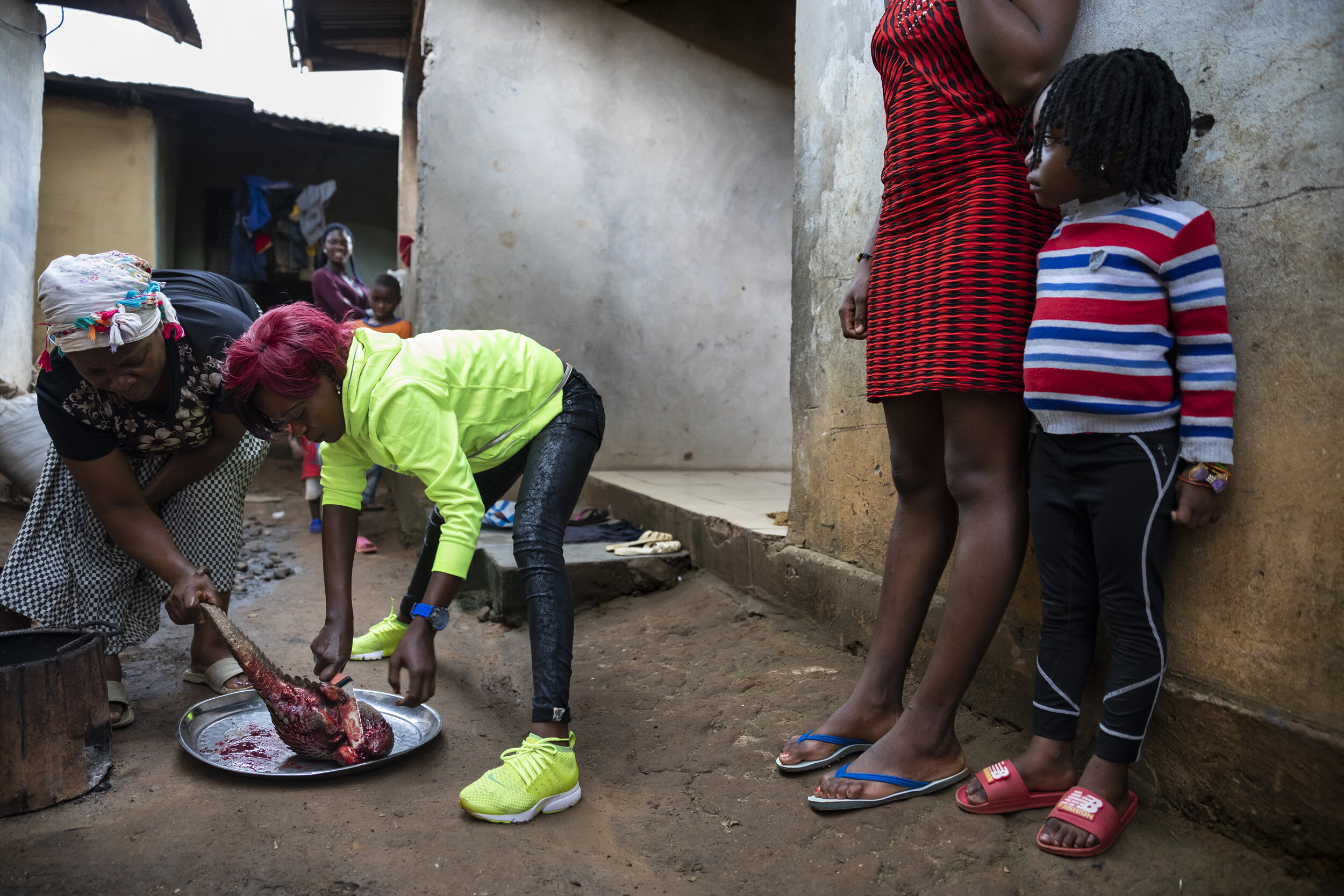
CAMEROON, 12 AUGUST 2018: A young woman who works as a street food trader in a small town 60 miles from Yaonde is seen with a juvenile pangolin which she has purchased from a middleman for $14 who got the pangolin from bushmeat hunters. She is seen with the pangolin at her stall shortly after acquiring the live animal. She then took the animal home and slaughtered it, removing the scales and disecting the body. She says she has been selling scaels for about a year but has been selling pangolin meat for at least 10 years. She adds that it is becoming rarer to find and more expensive. At this time, this is still a legal practise in Cameroon. (Photo by Brent Stirton/Getty Images for National Geographic Magazine.)
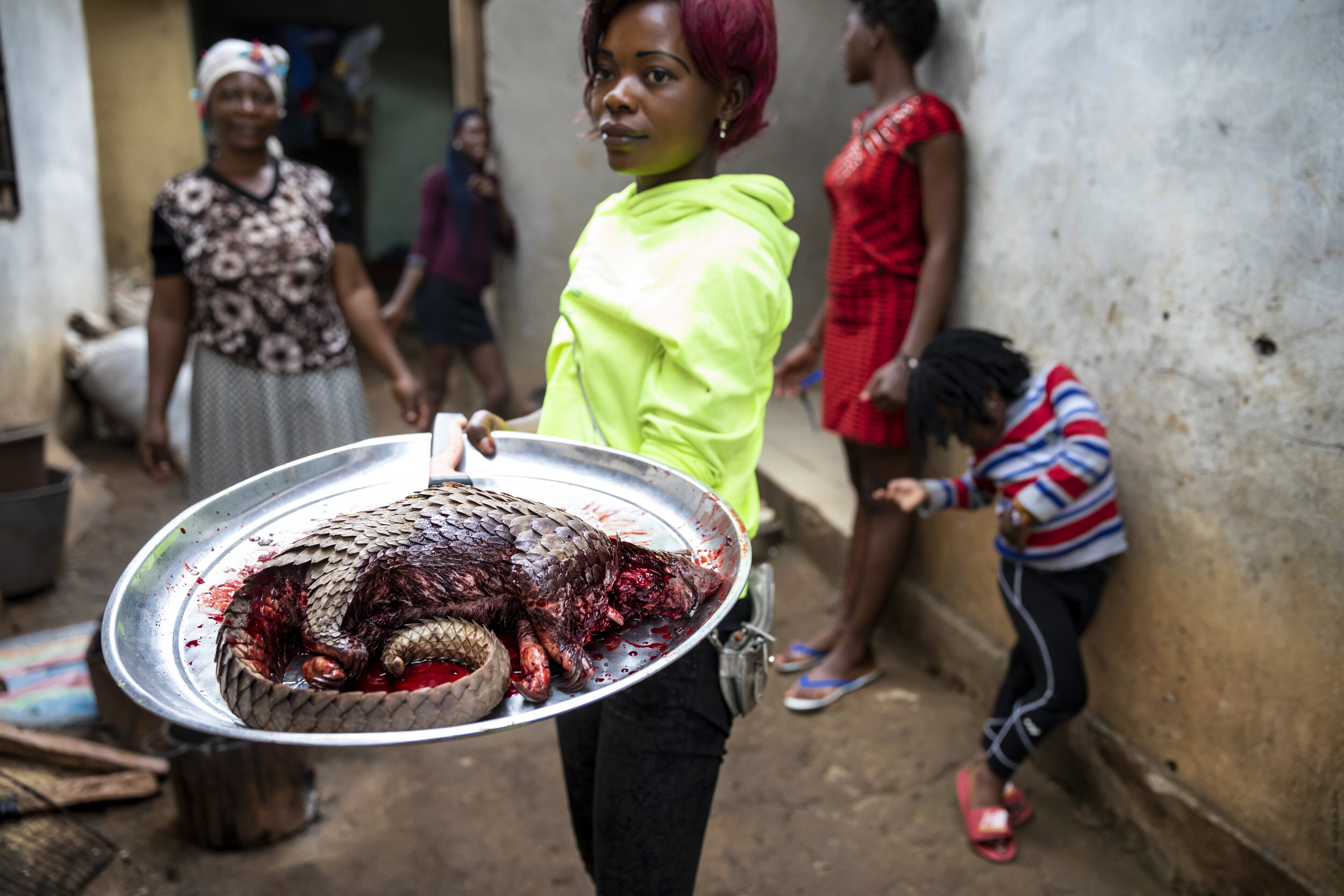
CAMEROON, 12 AUGUST 2018: A young woman who works as a street food trader in a small town 60 miles from Yaonde is seen with a juvenile pangolin which she has purchased from a middleman for $14 who got the pangolin from bushmeat hunters. She is seen with the pangolin at her stall shortly after acquiring the live animal. She then took the animal home and slaughtered it, removing the scales and disecting the body. She says she has been selling scaels for about a year but has been selling pangolin meat for at least 10 years. She adds that it is becoming rarer to find and more expensive. At this time, this is still a legal practise in Cameroon. (Photo by Brent Stirton/Getty Images for National Geographic Magazine.)
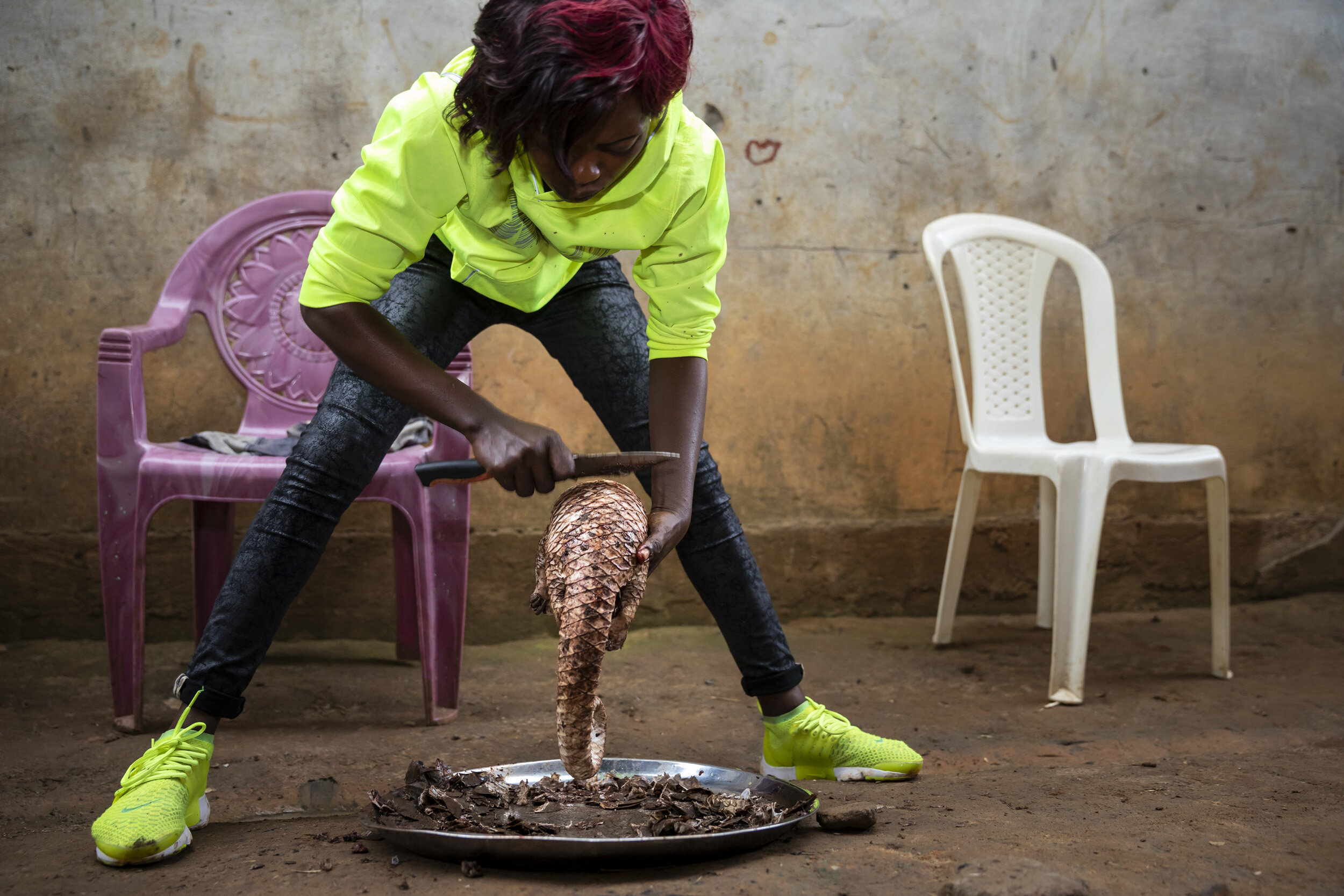
CAMEROON, 12 AUGUST 2018: A young woman who works as a street food trader in a small town 60 miles from Yaonde is seen with a juvenile pangolin which she has purchased from a middleman for $14 who got the pangolin from bushmeat hunters. She is seen with the pangolin at her stall shortly after acquiring the live animal. She then took the animal home and slaughtered it, removing the scales and disecting the body. She says she has been selling scaels for about a year but has been selling pangolin meat for at least 10 years. She adds that it is becoming rarer to find and more expensive. At this time, this is still a legal practise in Cameroon. (Photo by Brent Stirton/Getty Images for National Geographic Magazine.)
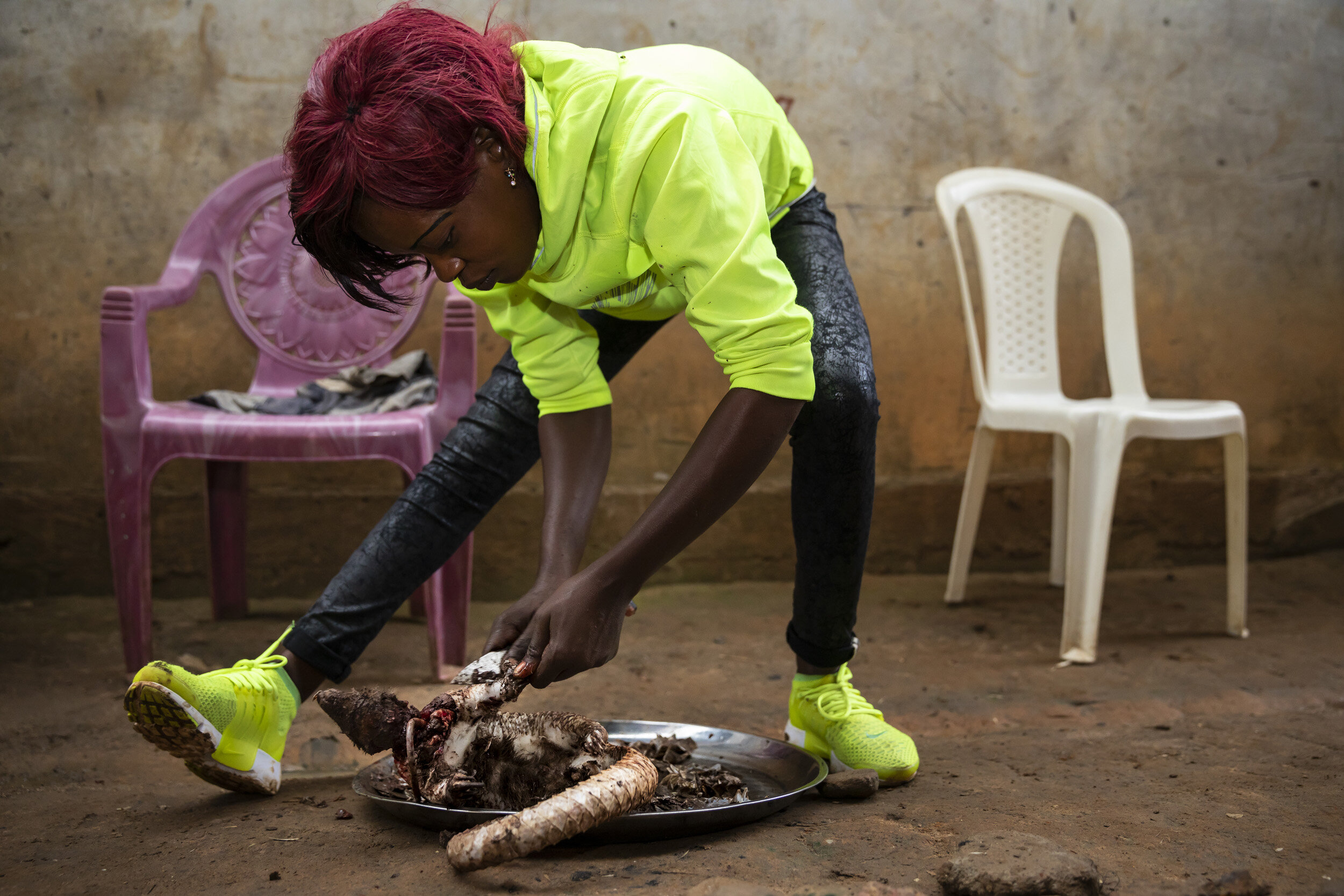
CAMEROON, 12 AUGUST 2018: A young woman who works as a street food trader in a small town 60 miles from Yaonde is seen with a juvenile pangolin which she has purchased from a middleman for $14 who got the pangolin from bushmeat hunters. She is seen with the pangolin at her stall shortly after acquiring the live animal. She then took the animal home and slaughtered it, removing the scales and disecting the body. She says she has been selling scaels for about a year but has been selling pangolin meat for at least 10 years. She adds that it is becoming rarer to find and more expensive. At this time, this is still a legal practise in Cameroon. (Photo by Brent Stirton/Getty Images for National Geographic Magazine.)

DOUALA, CAMEROON, 18 AUGUST 2018: Members of the Ministry of Wildlife, undercover Police and undercover members of LAGA, a wildlife law enforcement agency capture a group of 5 men who tried to sell one thousand kilograms of giant pangolin scales to an undercover agent of LAGA. These are some of the most endangered Pangolins in the world. A price of $100,000.00 was negotiated for the scales before the bust. The traffickers include men from both Cameroon and Central African Republic and another Nigerian remains at large. (Photo by Brent Stirton/Getty Images for National Geographic Magazine.)

DOUALA, CAMEROON, 18 AUGUST 2018: Members of the Ministry of Wildlife, undercover Police and undercover members of LAGA, a wildlife law enforcement agency capture a group of 5 men who tried to sell one thousand kilograms of giant pangolin scales to an undercover agent of LAGA. These are some of the most endangered Pangolins in the world. A price of $100,000.00 was negotiated for the scales before the bust. The traffickers include men from both Cameroon and Central African Republic and another Nigerian remains at large. (Photo by Brent Stirton/Getty Images for National Geographic Magazine.)

DOUALA, CAMEROON, 18 AUGUST 2018: Members of the Ministry of Wildlife, undercover Police and undercover members of LAGA, a wildlife law enforcement agency capture a group of 5 men who tried to sell one thousand kilograms of giant pangolin scales to an undercover agent of LAGA. These are some of the most endangered Pangolins in the world. A price of $100,000.00 was negotiated for the scales before the bust. The traffickers include men from both Cameroon and Central African Republic and another Nigerian remains at large. (Photo by Brent Stirton/Getty Images for National Geographic Magazine.)
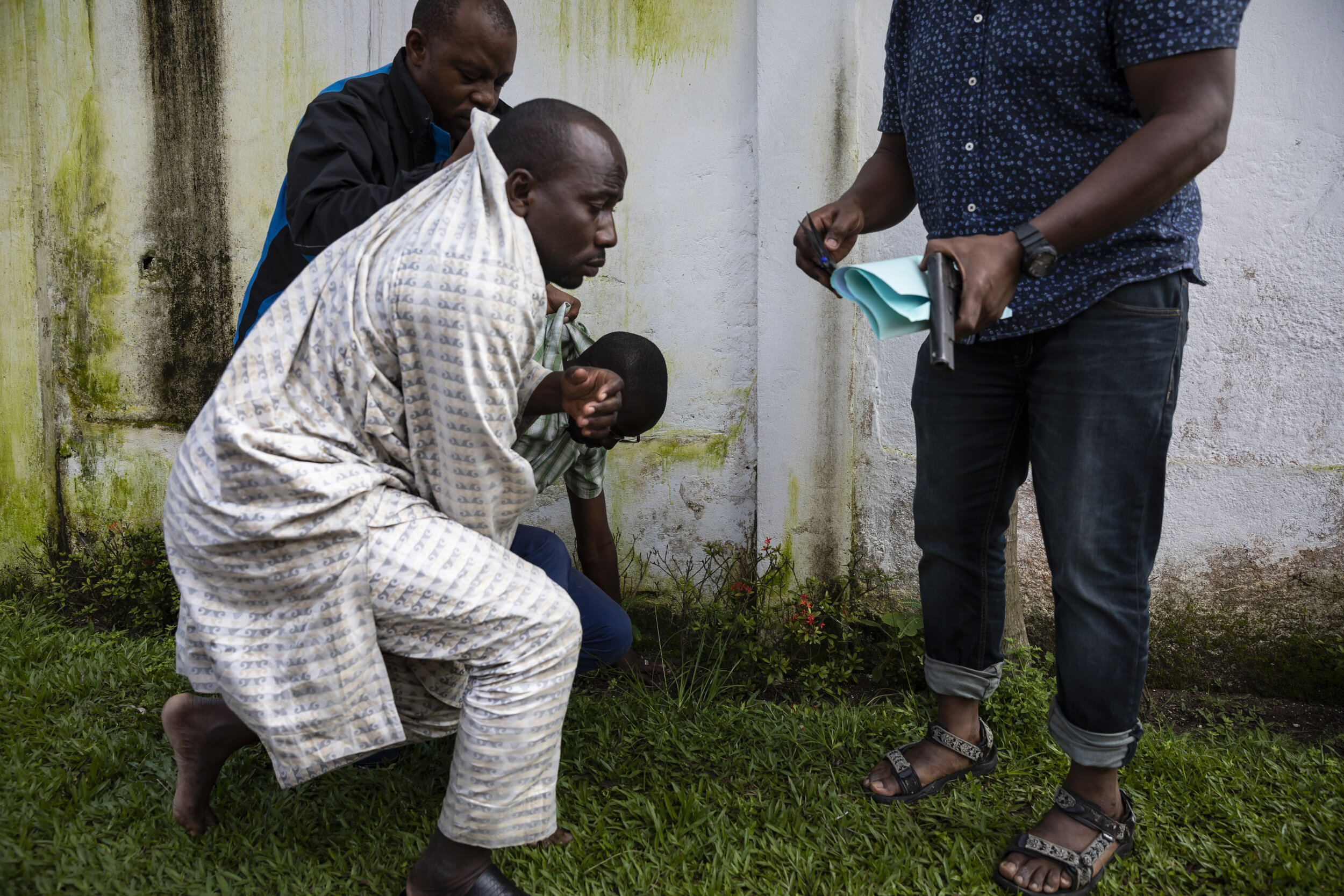
DOUALA, CAMEROON, 18 AUGUST 2018: Members of the Ministry of Wildlife, undercover Police and undercover members of LAGA, a wildlife law enforcement agency capture a group of 5 men who tried to sell one thousand kilograms of giant pangolin scales to an undercover agent of LAGA. These are some of the most endangered Pangolins in the world. A price of $100,000.00 was negotiated for the scales before the bust. The traffickers include men from both Cameroon and Central African Republic and another Nigerian remains at large. (Photo by Brent Stirton/Getty Images for National Geographic Magazine.)
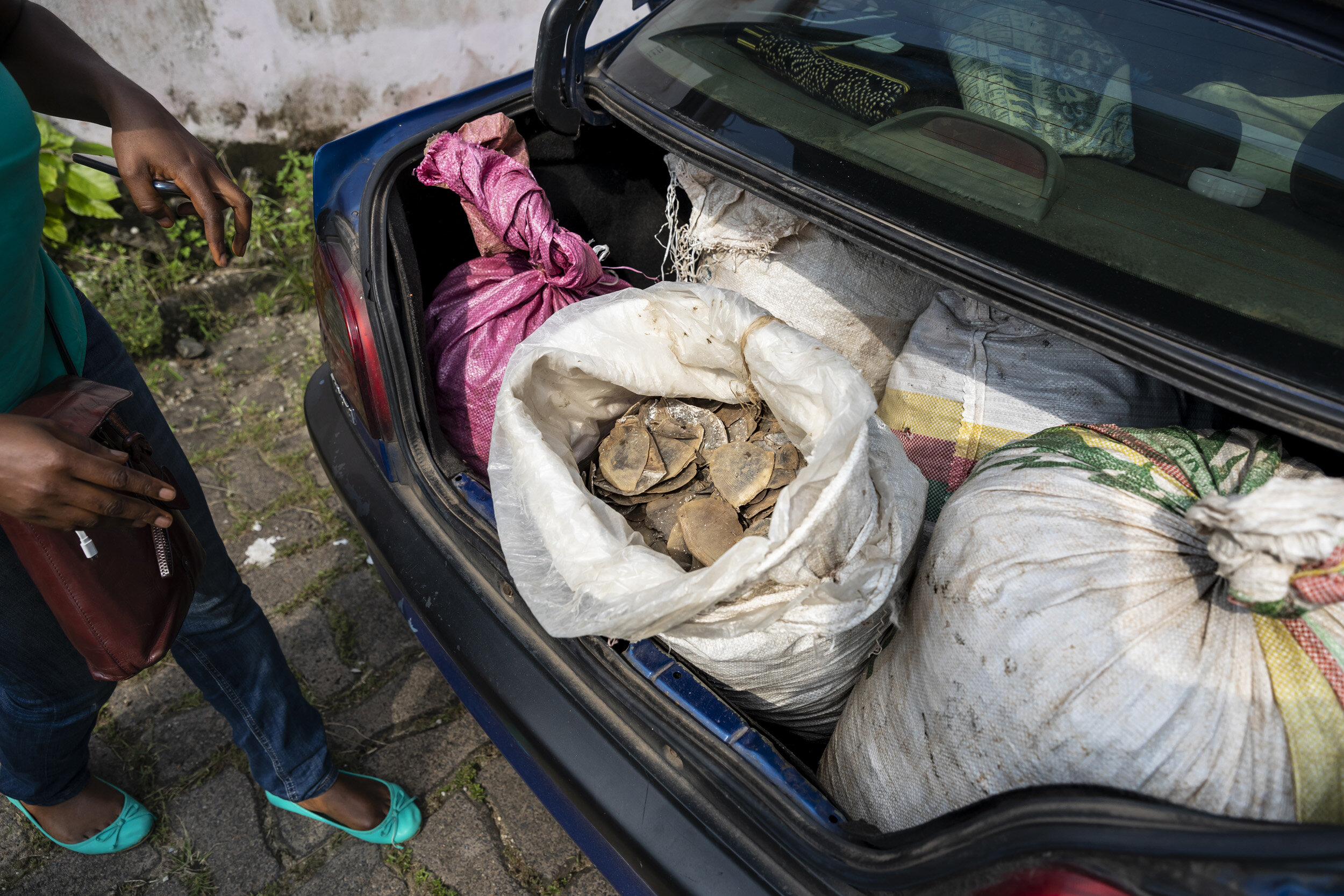
DOUALA, CAMEROON, 18 AUGUST 2018: Members of the Ministry of Wildlife, undercover Police and undercover members of LAGA, a wildlife law enforcement agency capture a group of 5 men who tried to sell one thousand kilograms of giant pangolin scales to an undercover agent of LAGA. These are some of the most endangered Pangolins in the world. A price of $100,000.00 was negotiated for the scales before the bust. The traffickers include men from both Cameroon and Central African Republic and another Nigerian remains at large. (Photo by Brent Stirton/Getty Images for National Geographic Magazine.)
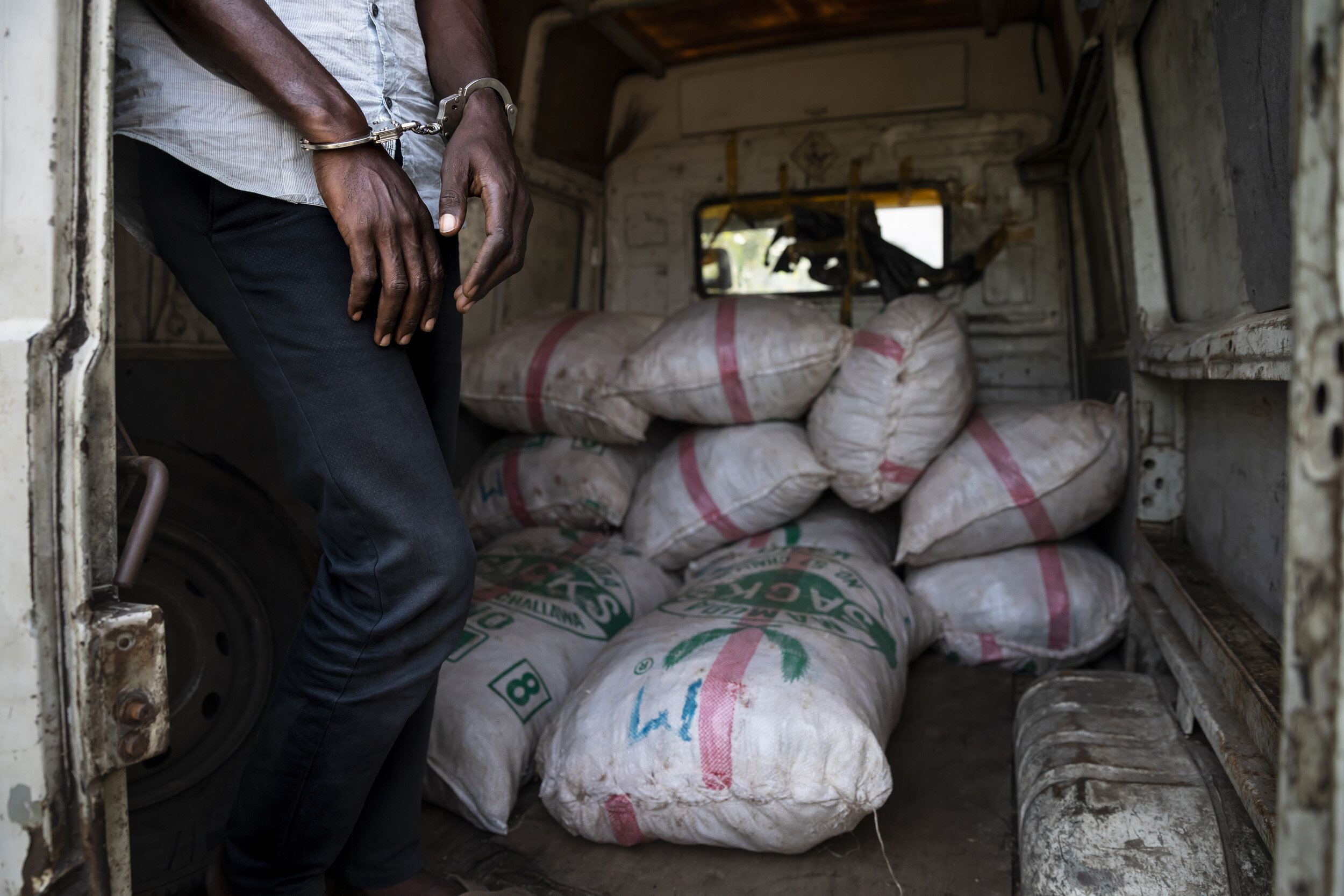
DOUALA, CAMEROON, 18 AUGUST 2018: Members of the Ministry of Wildlife, undercover Police and undercover members of LAGA, a wildlife law enforcement agency capture a group of 5 men who tried to sell one thousand kilograms of giant pangolin scales to an undercover agent of LAGA. These are some of the most endangered Pangolins in the world. A price of $100,000.00 was negotiated for the scales before the bust. The traffickers include men from both Cameroon and Central African Republic and another Nigerian remains at large. (Photo by Brent Stirton/Getty Images for National Geographic Magazine.)
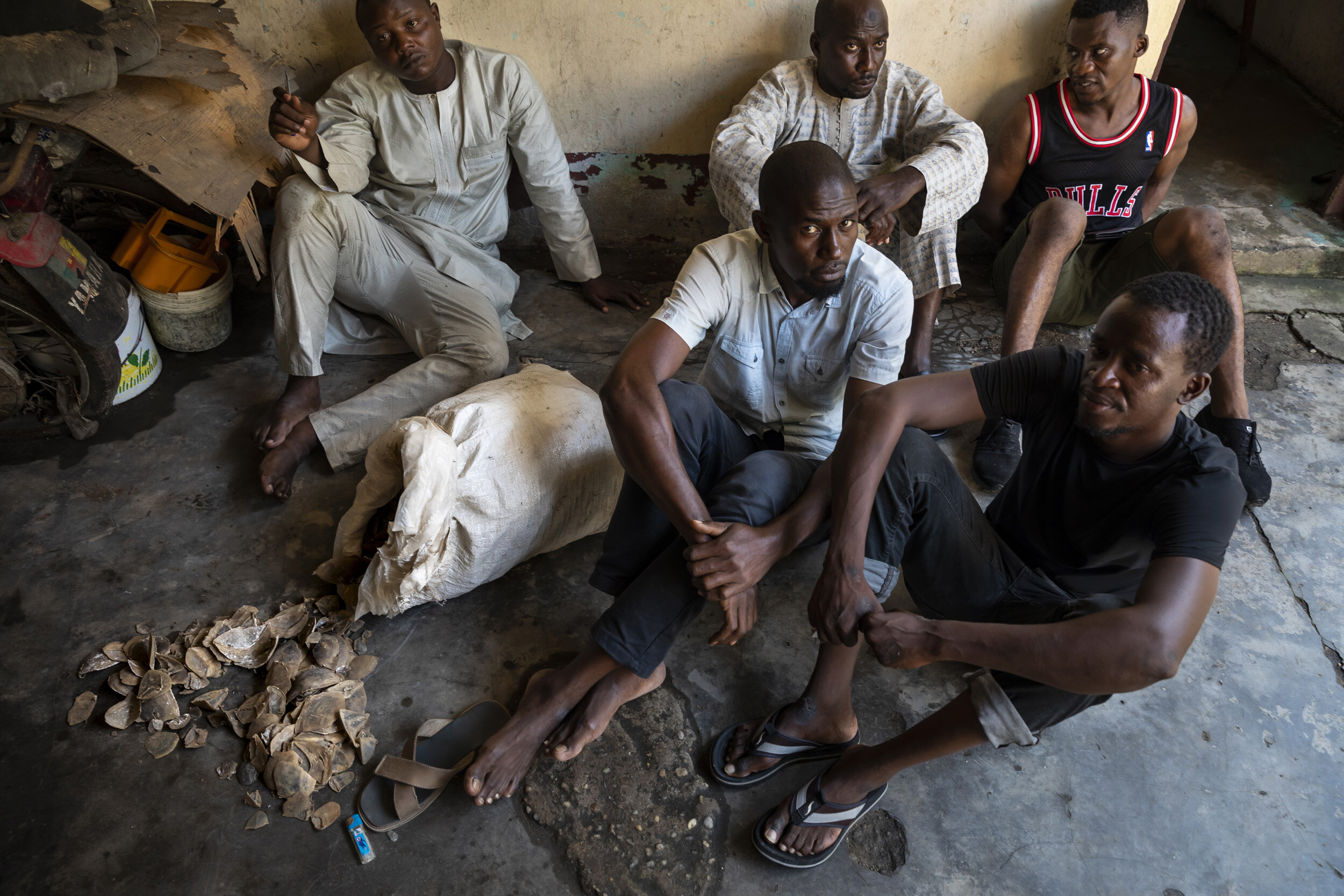
DOUALA, CAMEROON, 18 AUGUST 2018: Members of the Ministry of Wildlife, undercover Police and undercover members of LAGA, a wildlife law enforcement agency capture a group of 5 men who tried to sell one thousand kilograms of giant pangolin scales to an undercover agent of LAGA. These are some of the most endangered Pangolins in the world. A price of $100,000.00 was negotiated for the scales before the bust. The traffickers include men from both Cameroon and Central African Republic and another Nigerian remains at large. (Photo by Brent Stirton/Getty Images for National Geographic Magazine.)
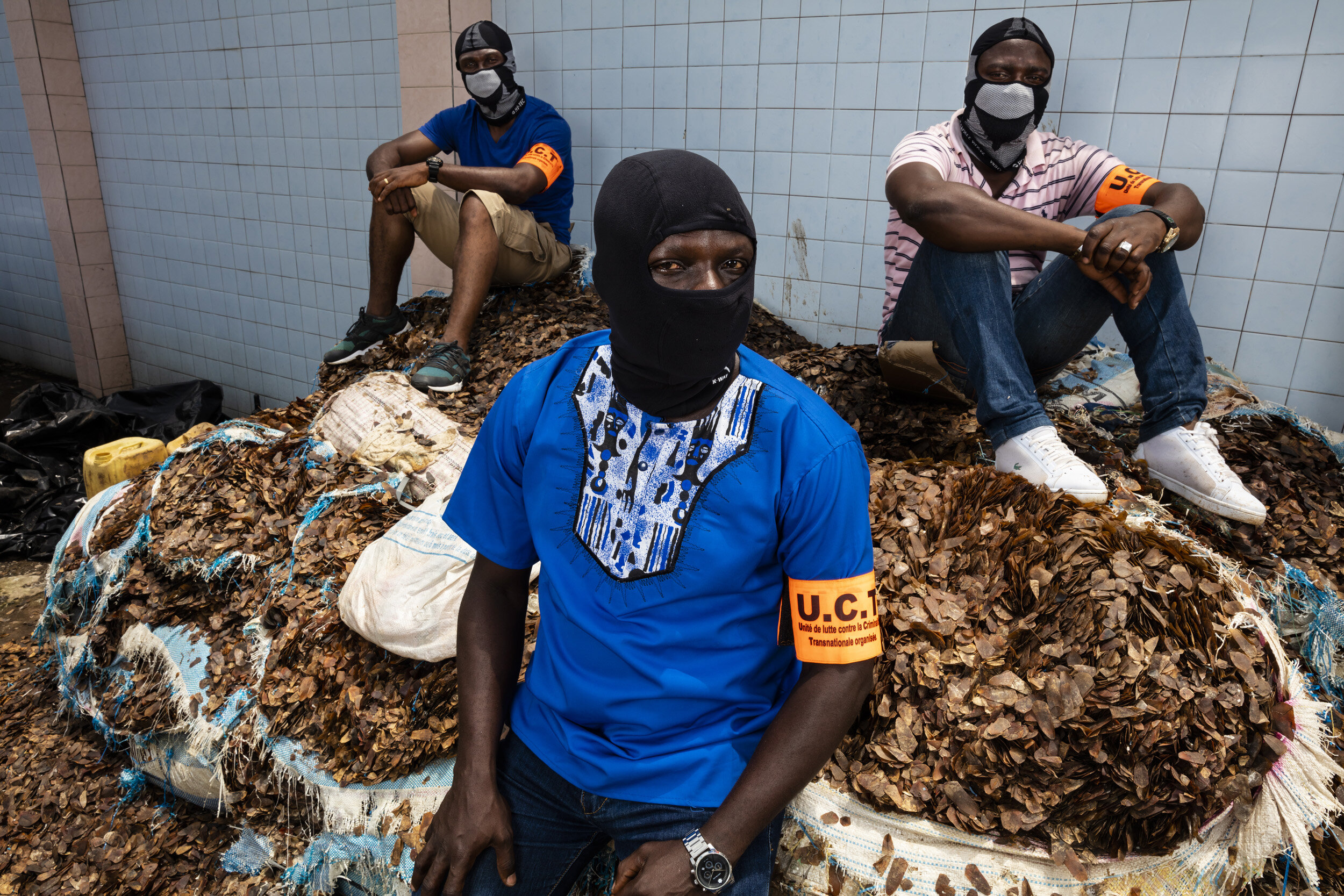
COTE D’IVOIRE, 28 AUGUST 2018: 3,600kgs of Pangolin scales in the car park of the offices of the Ivorian Unit for Trans National crime. The wildlife NGO Eagle worked in co-operation with this new unit to capture an Ivorian Trafficker and his 3 accomplices in a 3 ton sale of pangolin scales. They recently also arrested a Vietnamese trafficker who was caught with 23 ivory tusks from rare Forest Elephant as well as 600 kgs of Pangolin scales. Together this seizure represents a conservative estimate of over 11,000 pangolins. The Ivorian trafficker received one year of jail time and is out again as of the 1st of August, the Vietnamese man is still inside. He speaks very little French and his phone was full of illegal wildlife trade items. He says he is only in Ivory coast for this trade. Abidjan has a substantial Vietnamese population. The house where he was arrested also contained weapons and drugs belonging to a Chinese man, he was also implicated in human trafficking of Ivorian women to China. (Photo by Brent Stirton/Getty Images for National Geographic Magazine.)
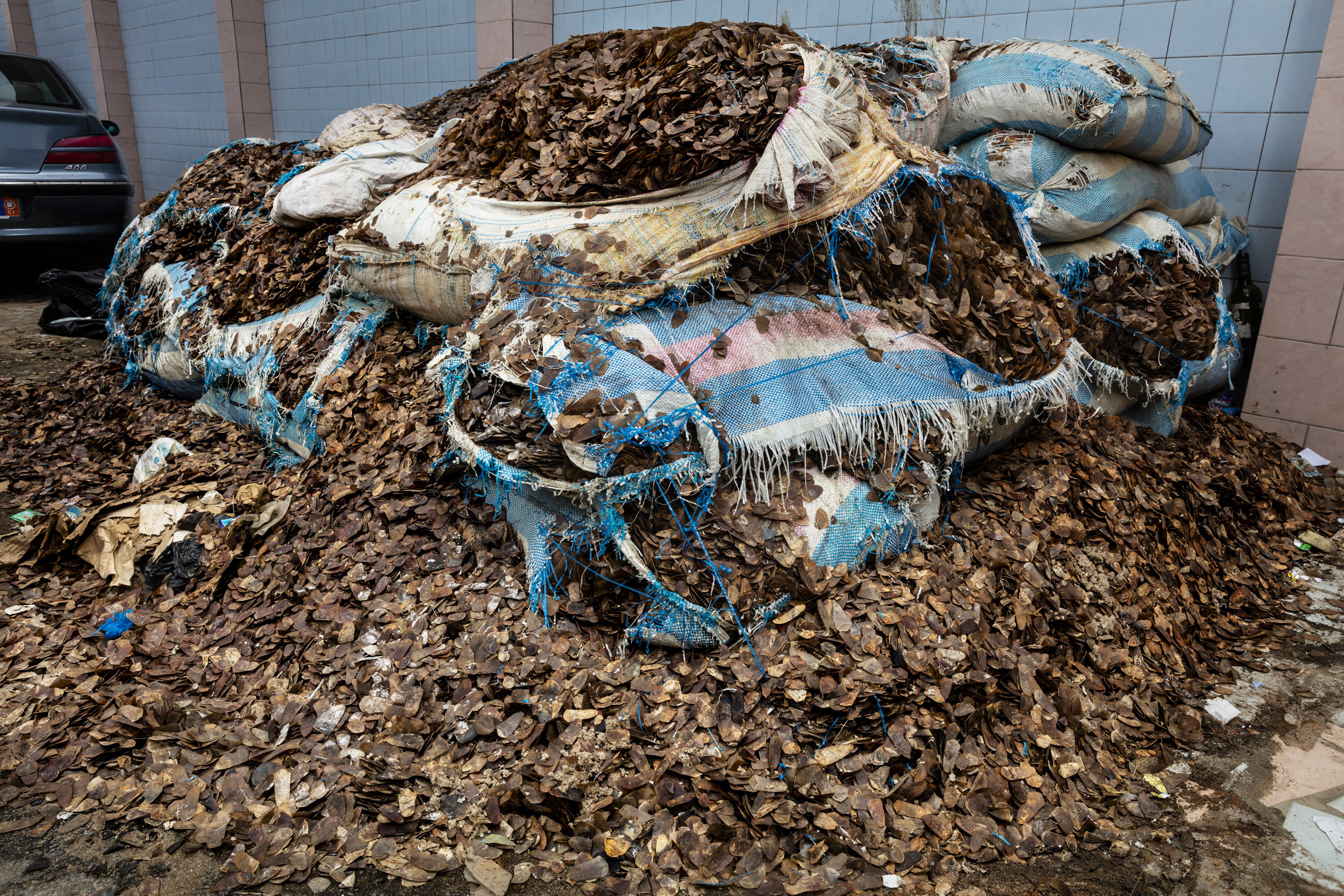
COTE D’IVOIRE, 28 AUGUST 2018: 3,600kgs of Pangolin scales in the car park of the offices of the Ivorian Unit for Trans National crime. The wildlife NGO Eagle worked in co-operation with this new unit to capture an Ivorian Trafficker and his 3 accomplices in a 3 ton sale of pangolin scales. They recently also arrested a Vietnamese trafficker who was caught with 23 ivory tusks from rare Forest Elephant as well as 600 kgs of Pangolin scales. Together this seizure represents a conservative estimate of over 11,000 pangolins. The Ivorian trafficker received one year of jail time and is out again as of the 1st of August, the Vietnamese man is still inside. He speaks very little French and his phone was full of illegal wildlife trade items. He says he is only in Ivory coast for this trade. Abidjan has a substantial Vietnamese population. The house where he was arrested also contained weapons and drugs belonging to a Chinese man, he was also implicated in human trafficking of Ivorian women to China. (Photo by Brent Stirton/Getty Images for National Geographic Magazine.)
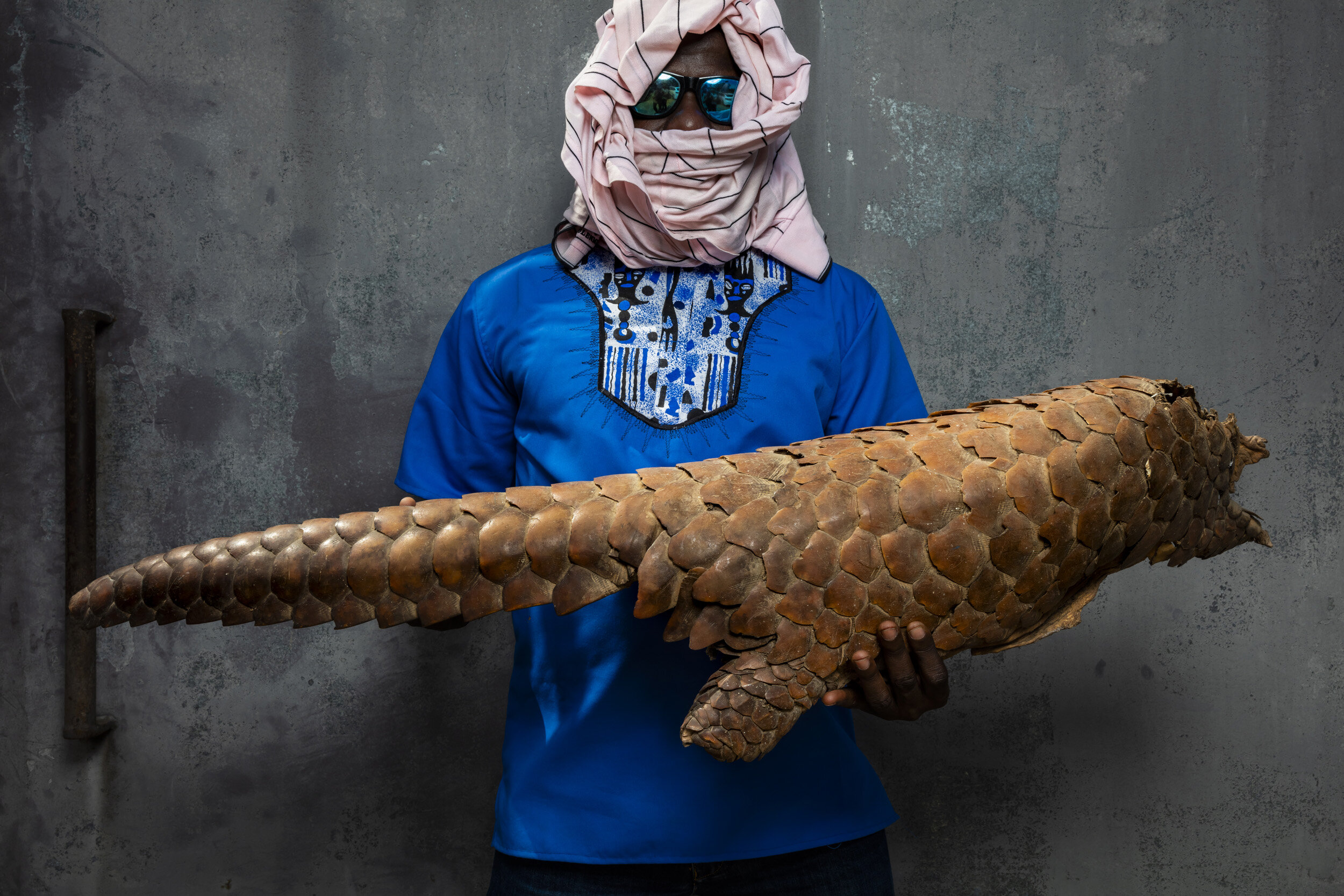
ABIDJAN, COTE D’IVOIRE, 28 AUGUST 2018: An undercover officer from a unit dedicated to Trans-national crime holds a giant pangolin exoskeleton discovered in a raid on a house in Abidjan. The raid netted two Vietnamese traffickers with 600 kgs of Pangolin scales as well as 23 ivory tusks from Forest Elephant. A Chinese man in the house was arrested for guns, drugs and is suspected of human trafficking based on document and photographs of 14 Ivorian women. The giant pangolin is a very highly endangered animal, on the red list for CITES appendix one. This exoskeleton and the tail of another larger giant pangolin were discovered in the locked room of the Chinese owner of the house, a traditonal Chinese doctor. (Photo by Brent Stirton/Getty Images for National Geographic Magazine.)

GARAMBA NATIONAL PARK, DEMOCRATIC REPUBLIC OF CONGO, APRIL 18TH 2019: ICCN conservation ranger Dog handlers receiving training on tracking and detection for ivory and pangolin scales. This pointer has just located a single pangolin scale hidden in the wall.
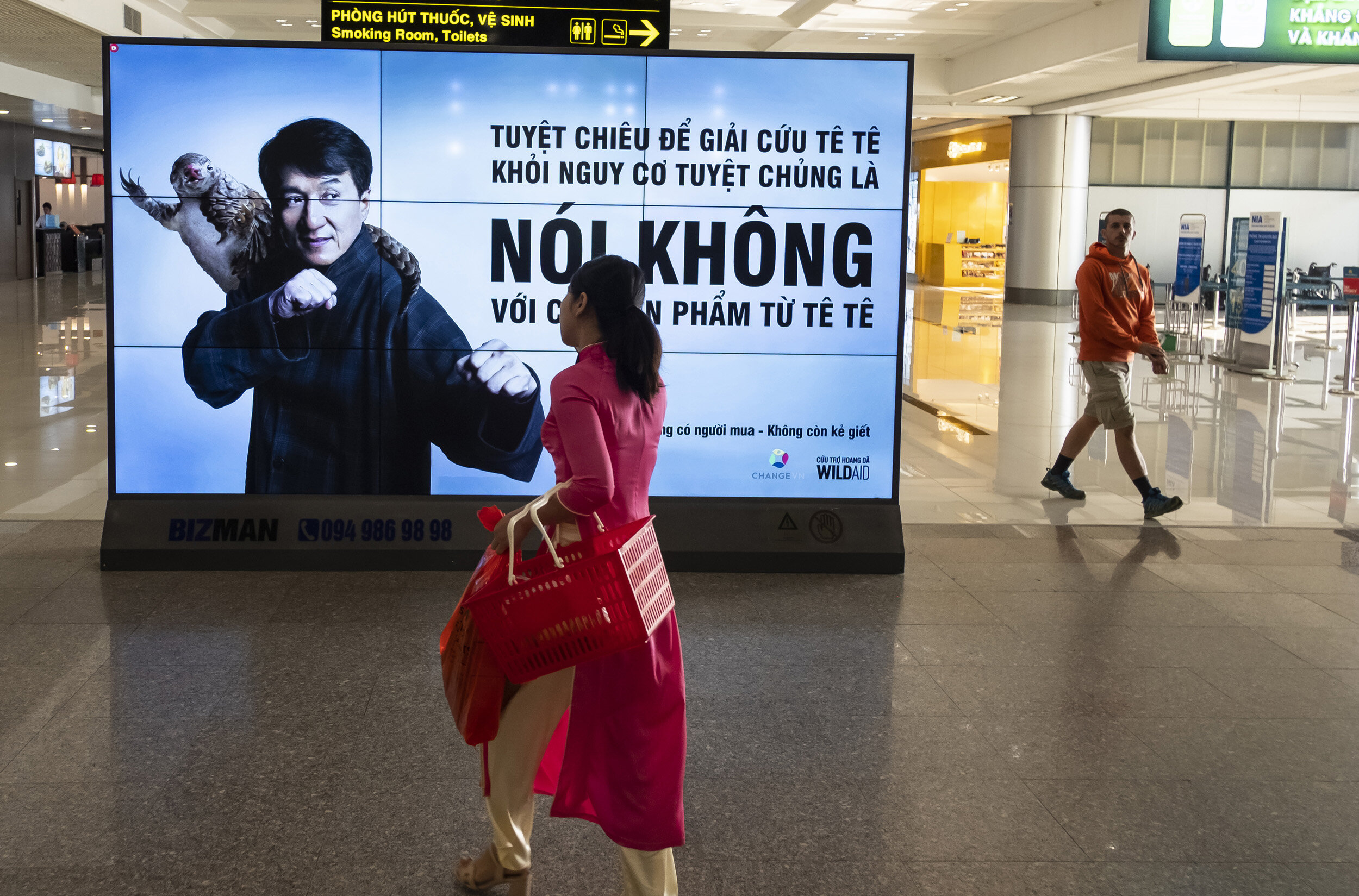
HANOI, VIETNAM, 3 NOVEMBER 2018: A public awareness campaign against the illegal consumption of Pangolins with Chinese star Jackie Chang is seen at Hanoi airport. There are two schools of thought with regards to these campaigns. Some Asian animal rights groups believe they can have the opposite effect and stimulate intersest in the endangered animal. (Photo by Brent Stirton/Getty Images for National Geographic Magazine)
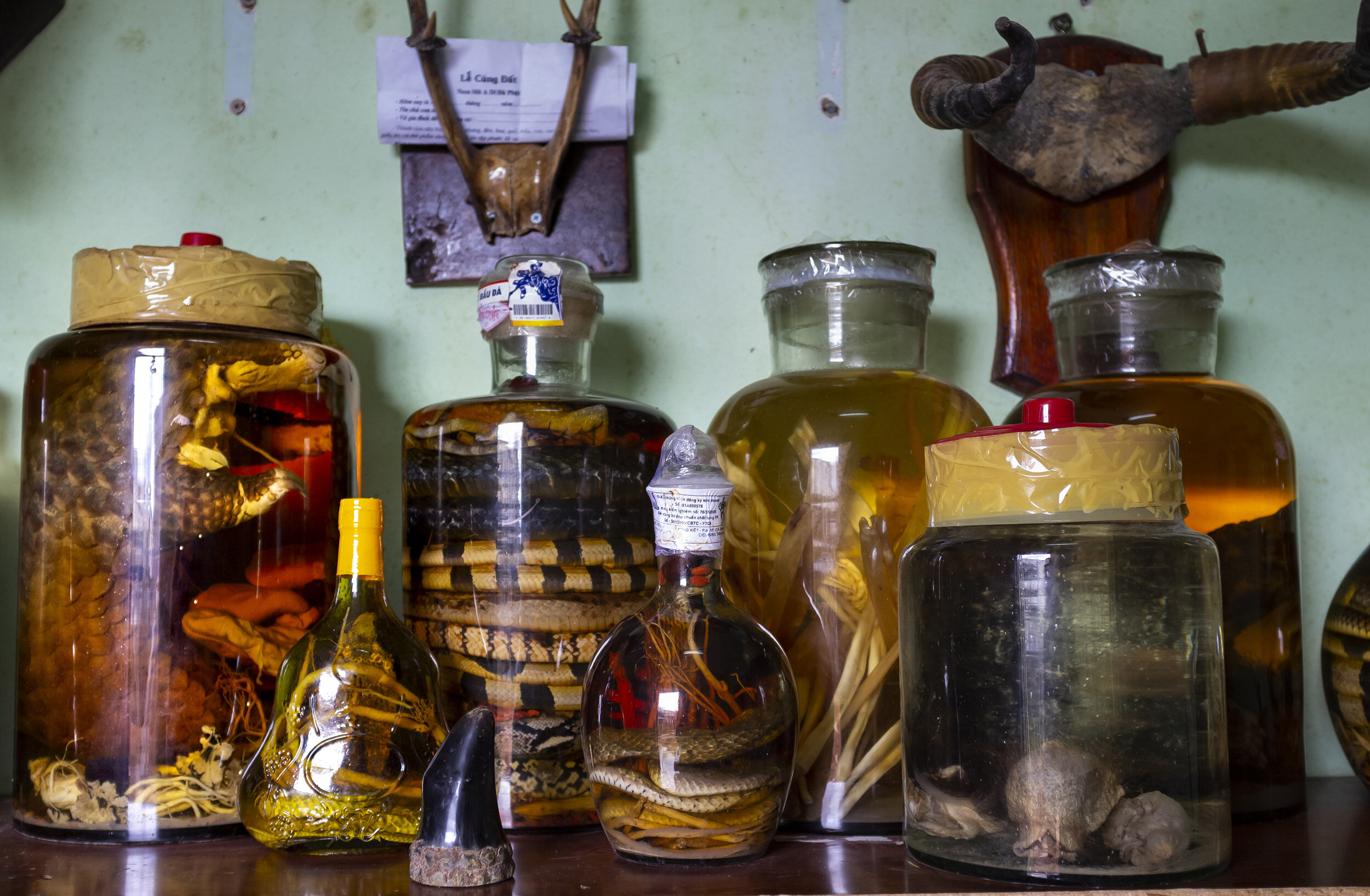
HO CHI MINH CITY, VIETNAM, OCTOBER 4, 2011: A white bellied pangolin is seen amongst other wildlife in “wine” form in a Vietnamese Traditional Medicine shop. Vietnamese and Chinese traditional medicine has long believed that this “tonic” will be good for the person who drinks it. (Photo by Brent Stirton/National Geographic Magazine.)
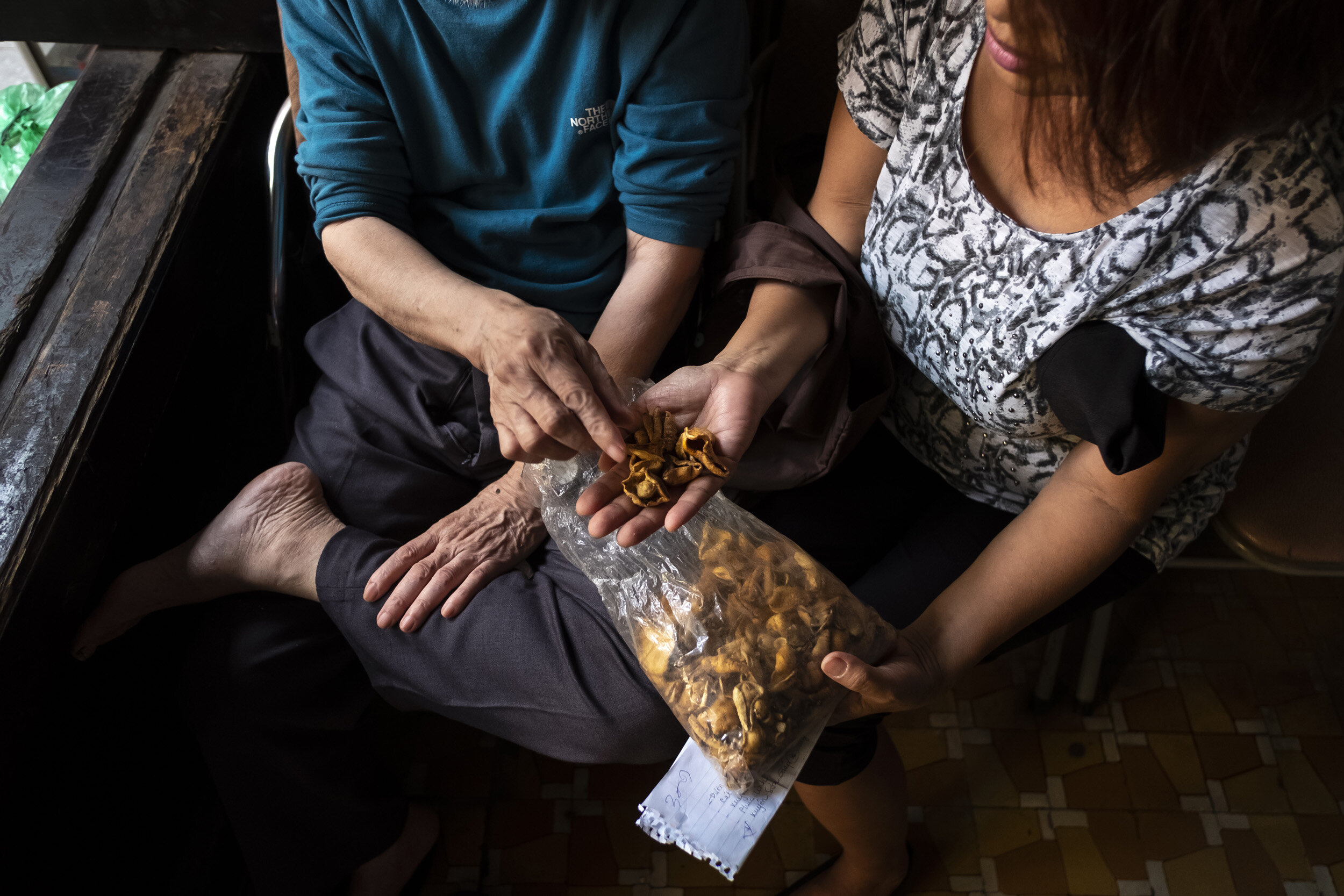
HANOI, VIETNAM, 5 NOVEMBER 2018: A Vietnamese woman consults with a traditional medicine specialist over pangolin scales. The highest percentage use for the scales in TM is for help for lactating women. Pangolins are now listed as Appendix one critically endangered by CITES since the beginning of 2018 but scales are still available all over Vietnam. It is known that they are an illegal commodity but law enforcement is lax. (Photo by Brent Stirton/Getty Images for National Geographic Magazine)
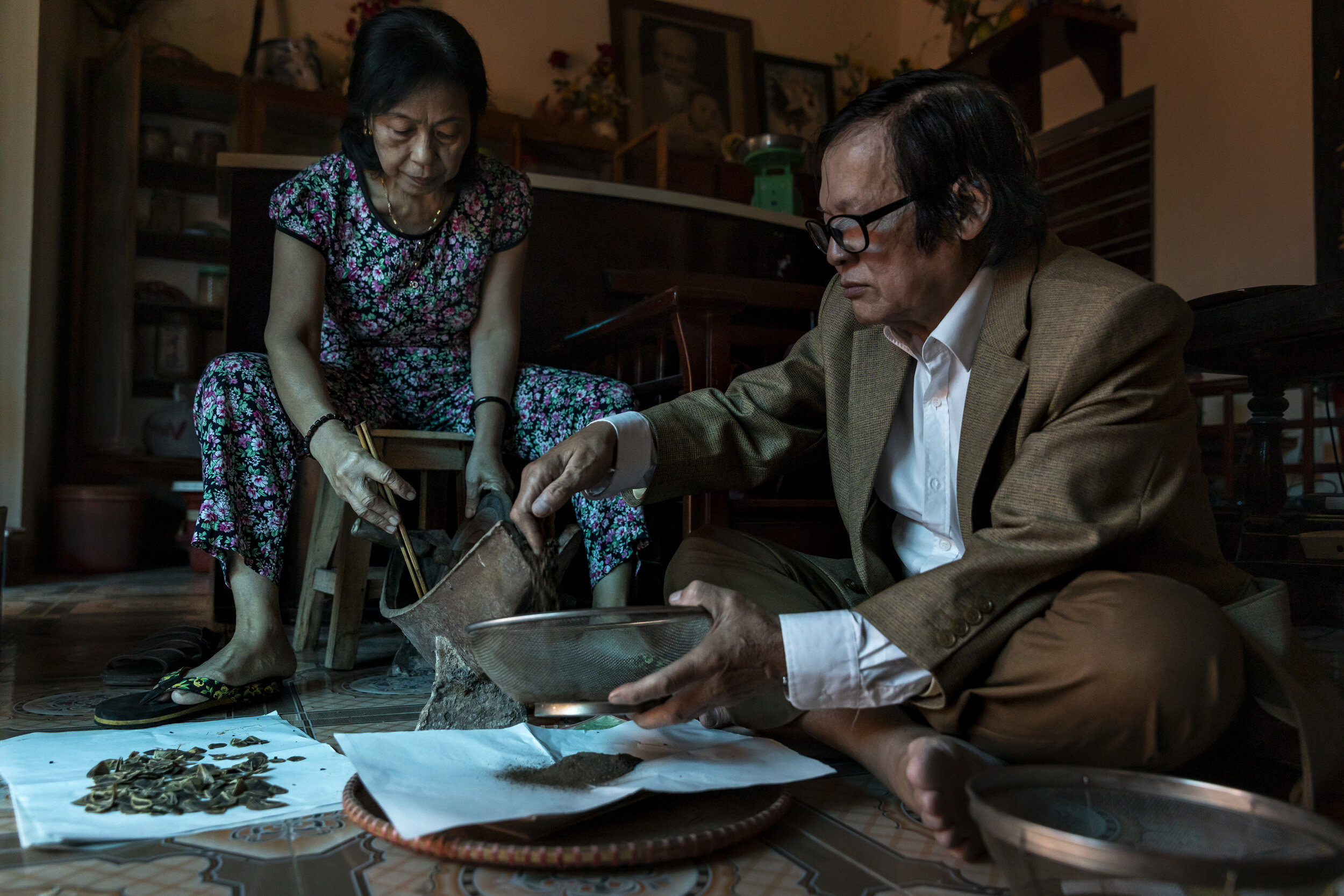
DUONGLAM, VIETNAM, 6 NOVEMBER 2018: Do Doan Quat, 71, a 6th generation traditional medicine doctor, is seen with his wife Tran Thi Thanh in their home. They grind pangolin scales and mix them with other herbs to create a medicine he believes is good for tumors. He says that he has never really been sure about the efficacy of the use of Pangolin scales but that people believe in them so he uses them. He states that a lot of this kind of medicine is a testament to the power of belief. He states that the use of pangolin parts in Vietnam was so common in the past that it was like using chickens. He say the use has declined and is not so common anymore, the recent ban has moved the trade more underground. He thinks this is due to the fact that there are far less pangolin these days. He states that much of Vietnam’s traditional medicine is imported from China. The Vietnamese tend to prioritize traditional medicine but in an emergency will go for Western Medicine first. (Photo by Brent Stirton/Getty Images for National Geographic Magazine.)
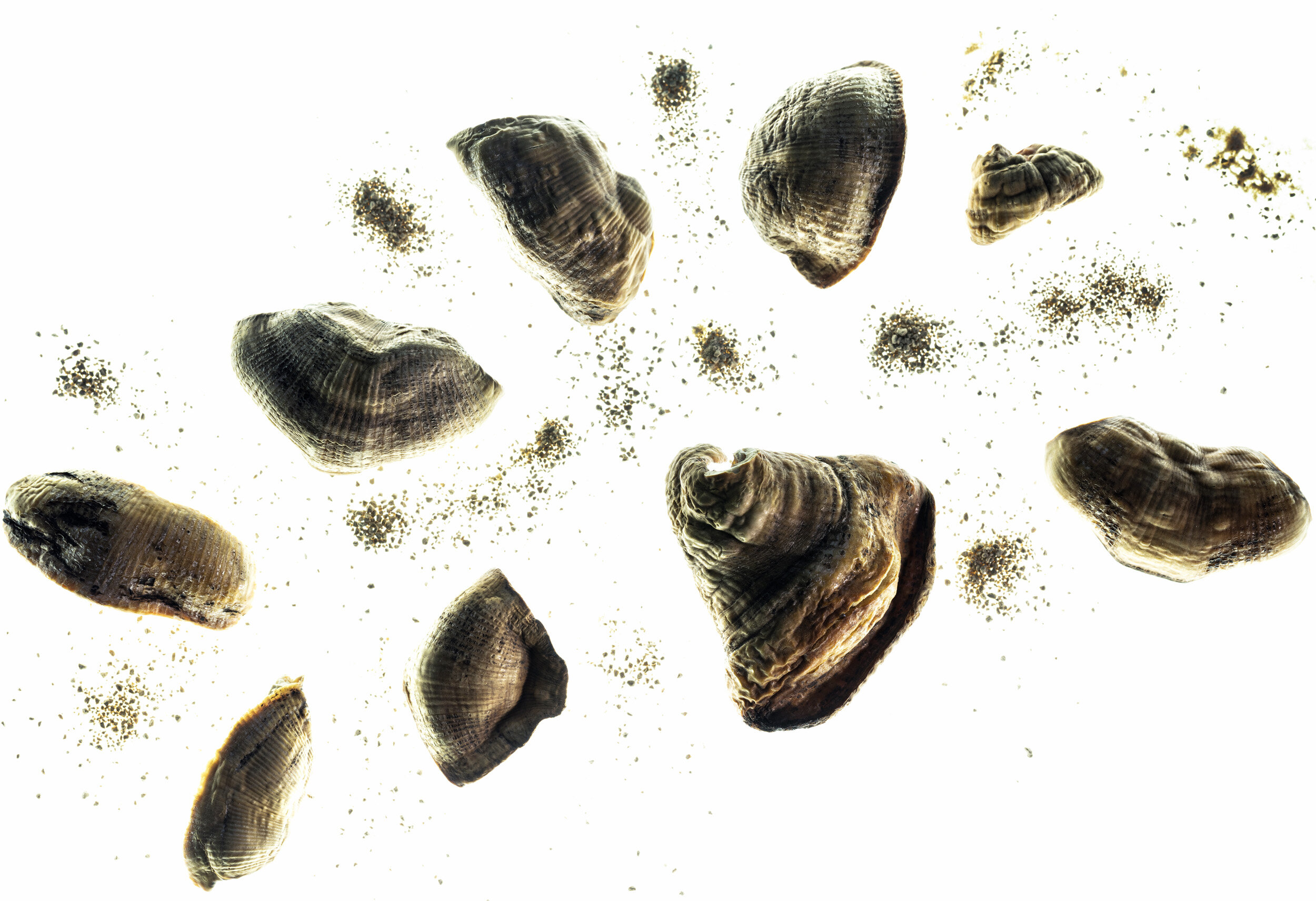
GUANGZHOU, CHINA, DECEMBER 2018: Pangolin scales purchased legally from Chinese traditional medicine outlets. These scales come in whole and crushed form. The crushed version is sold in packages that look like sugar sachets. Two of the outlets that sold these scales speculated that these scales nowadays come from confiscations, they have noticed that there are fewer and fewer pangolins and that is has become harder to get the scales. These scales are used for various treatments but the biggest use remains for women who are having problems with lactation. (Photo by Brent Stirton/Getty Images.)
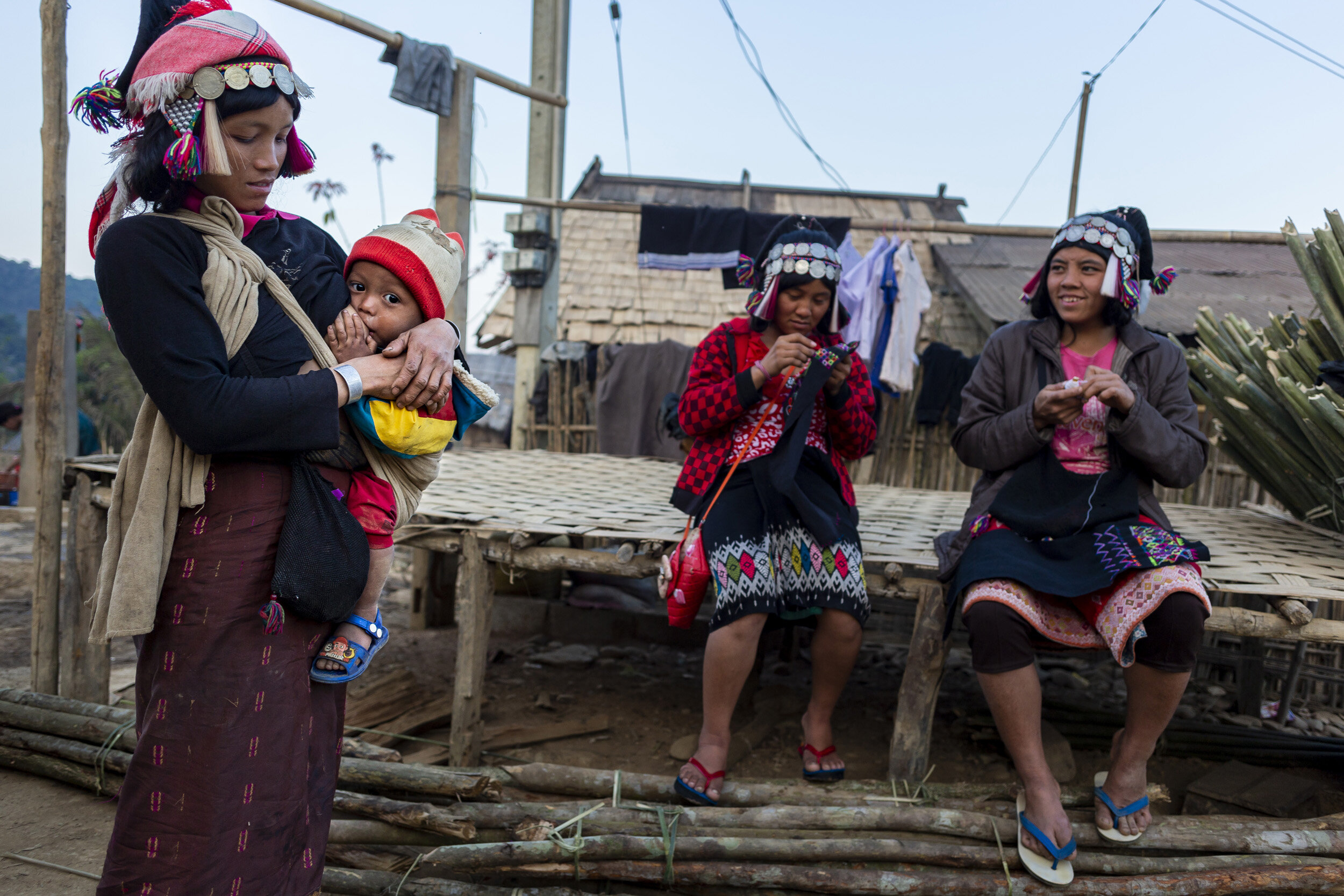
HIGHLANDS, LAOS, FEB 9TH, 2014: An Akha tribal woman breastfeeds her baby son. The highest percentage use of pangolin scales in traditional medicine is to aid in lactation for breastfeeding women. There is no scientific basis to this but statisically this is the most popular use of the the keratin based scales. (Photo by Brent Stirton/Getty Images for National Geographic Magazine.)
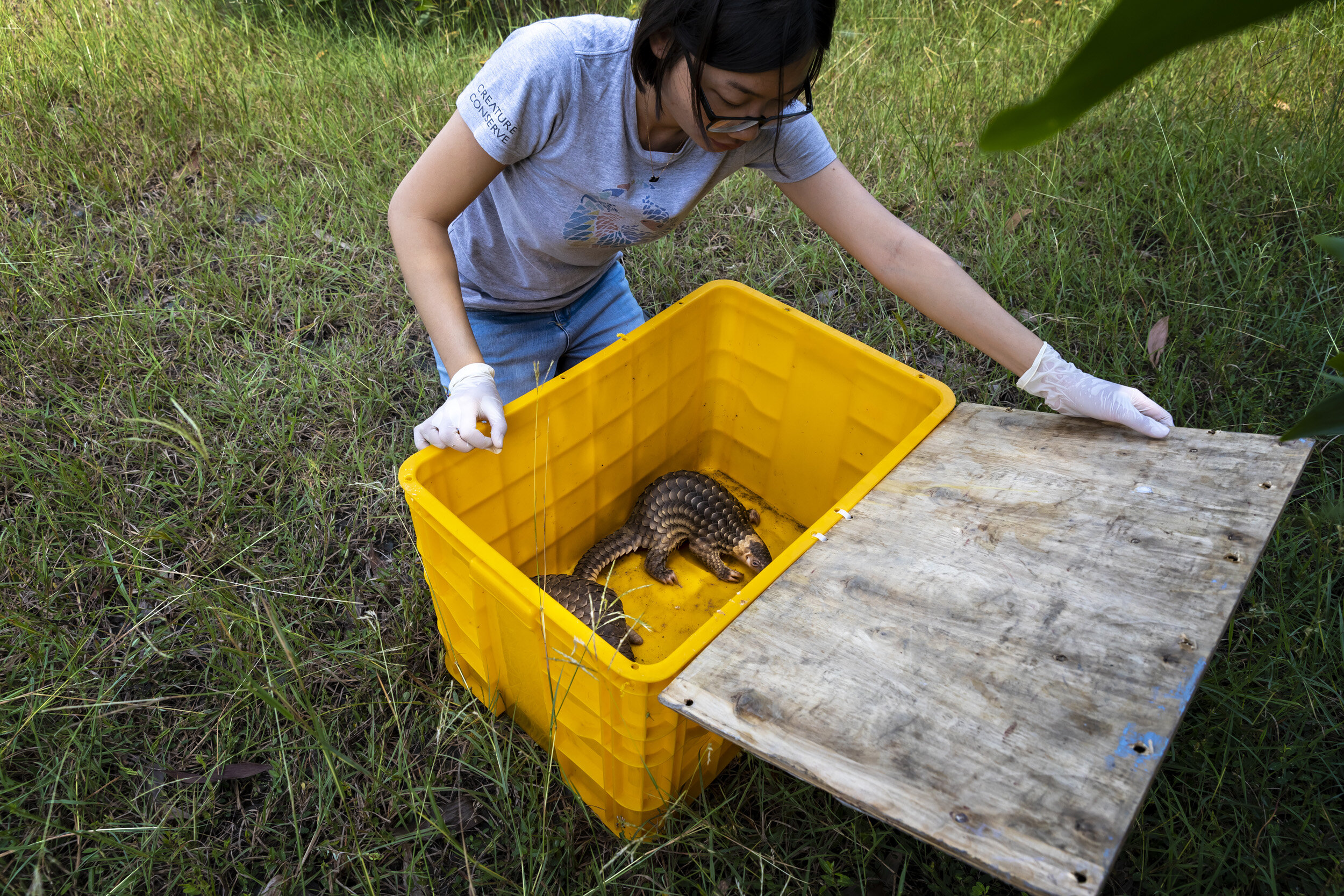
HO CHI MINH CITY, VIETNAM, 4 NOVEMBER 2018: A National Parks Veterinarian and a Veternarian from Save Vietnam’s Wildlife rescue three juvenile pangolins that were left in a box in a wasteland area in Ho Chi Minh city. SVW received an anonymous phone call saying that a man had rescued the pangolins from a trader but did not want to reveal himself. It is believed the pangolins were abandoned because they are juveniles and too small to sell to the lucrative restaurant trade and too difficult to raise to maturity. (Photo by Brent Stirton/National Geographic Magazine.)
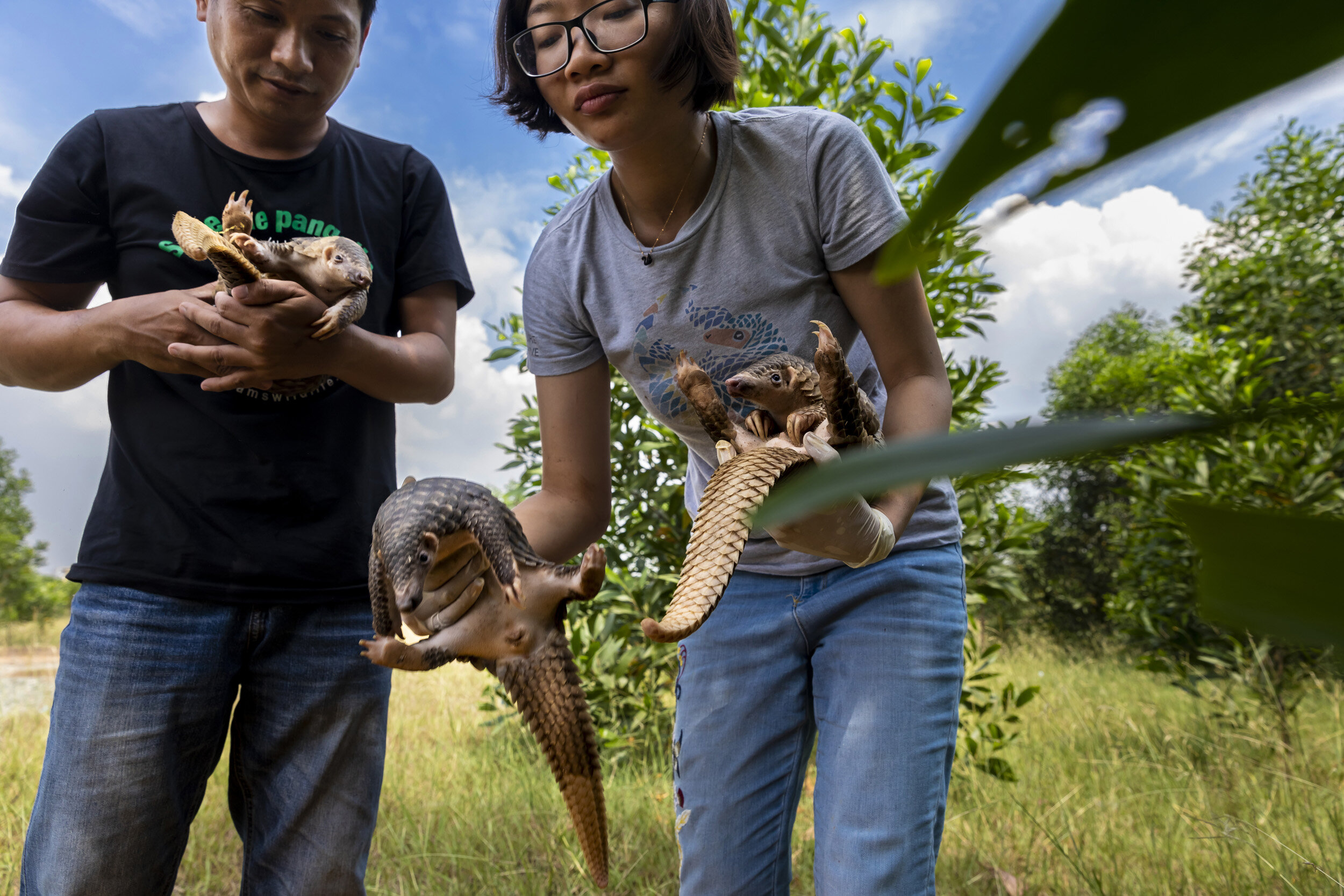
HO CHI MINH CITY, VIETNAM, 4 NOVEMBER 2018: A National Parks Veterinarian Nguyen Van Cuong and a Veternarian from Save Vietnam’s Wildlife, Ngoc Duyen Huong, rescue three juvenile pangolins that were left in a box in a wasteland area in Ho Chi Minh city. SVW received an anonymous phone call saying that a man had rescued the pangolins from a trader but did not want to reveal himself. It is believed the pangolins were abandoned because they are juveniles and too small to sell to the lucrative restaurant trade and too difficult to raise to maturity. (Photo by Brent Stirton/National Geographic Magazine.)
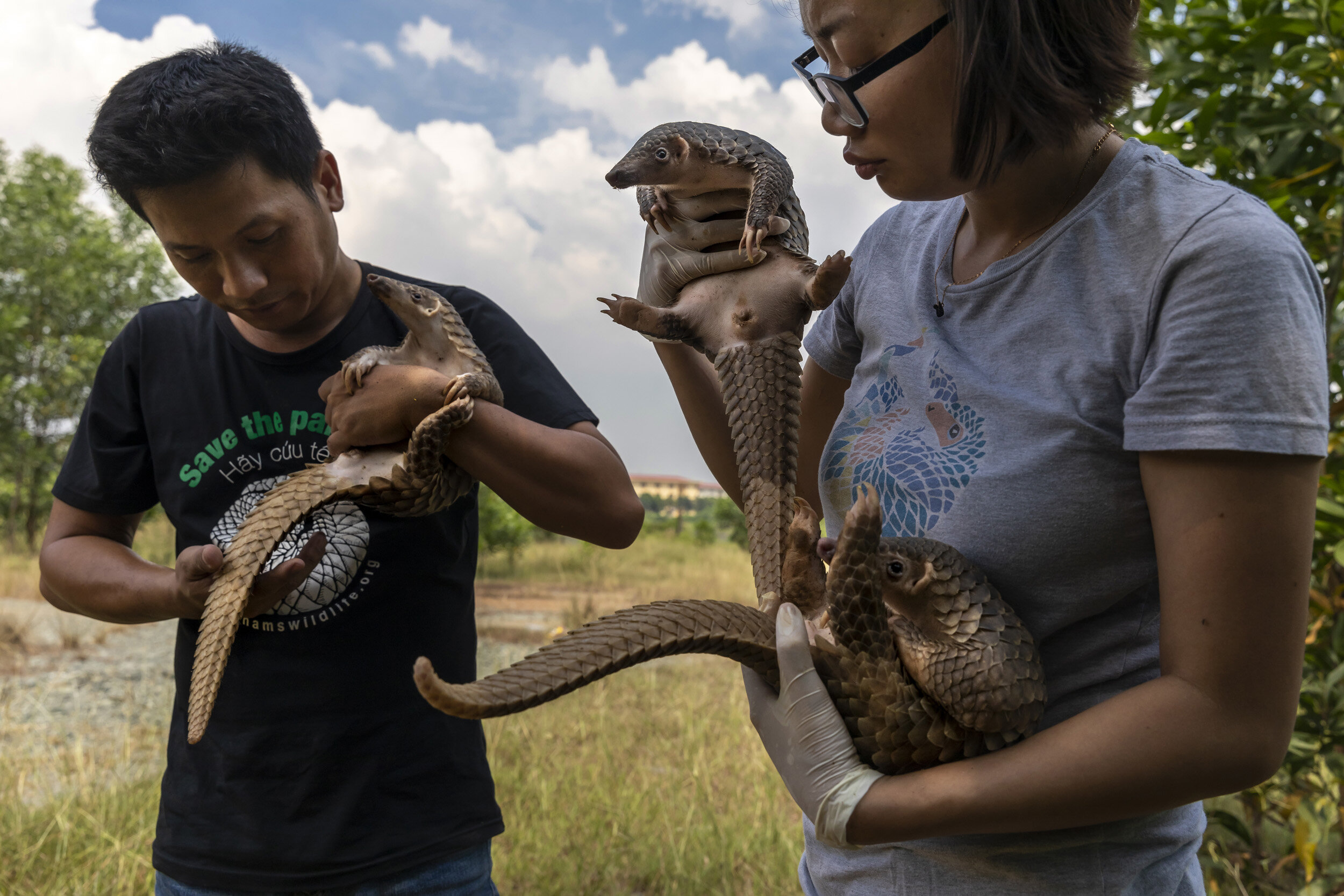
HO CHI MINH CITY, VIETNAM, 4 NOVEMBER 2018: A National Parks Veterinarian Nguyen Van Cuong and a Veternarian from Save Vietnam’s Wildlife, Ngoc Duyen Huong, rescue three juvenile pangolins that were left in a box in a wasteland area in Ho Chi Minh city. SVW received an anonymous phone call saying that a man had rescued the pangolins from a trader but did not want to reveal himself. It is believed the pangolins were abandoned because they are juveniles and too small to sell to the lucrative restaurant trade and too difficult to raise to maturity. (Photo by Brent Stirton/National Geographic Magazine.)
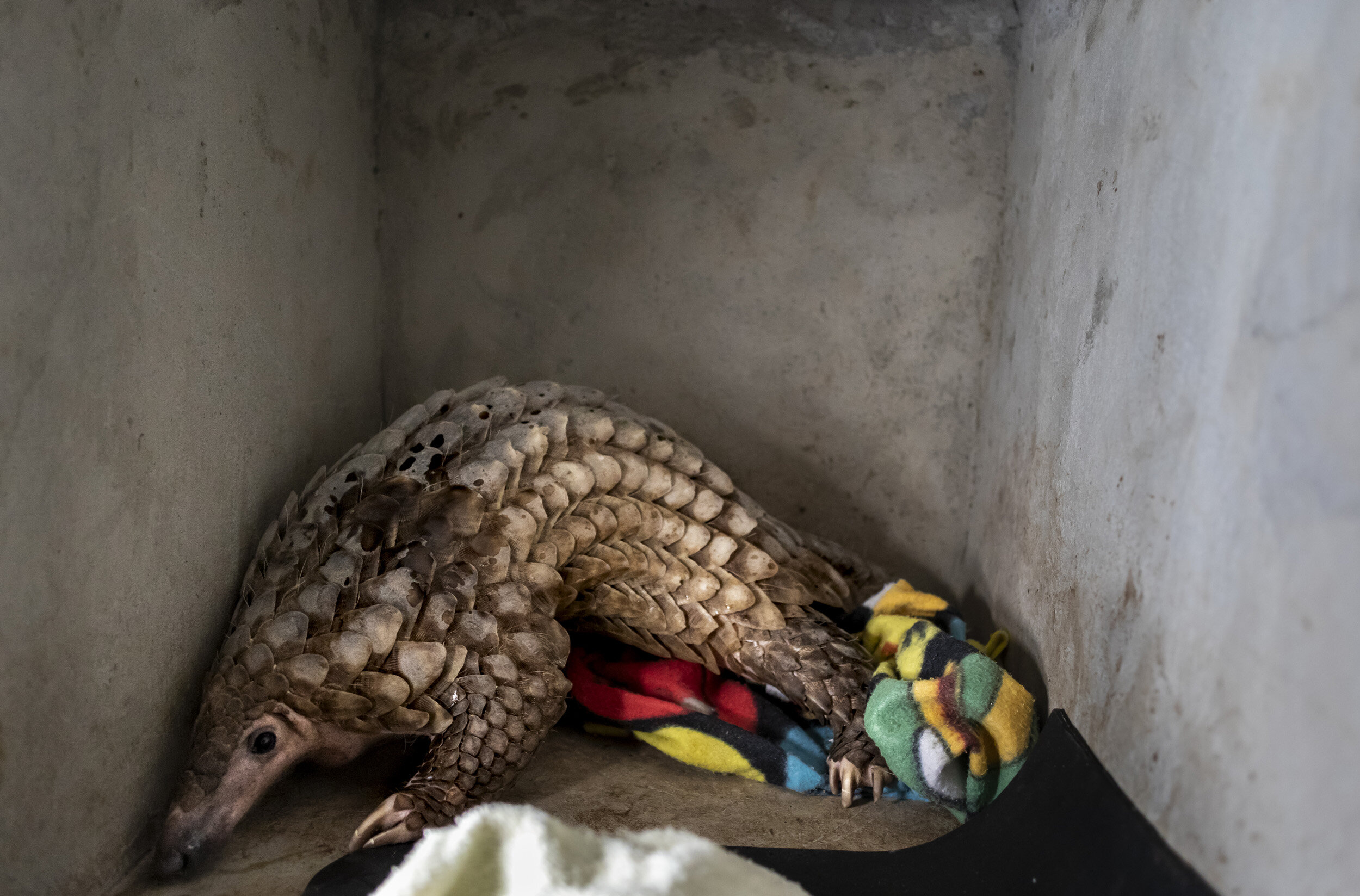
CUC PHUONG, VIETNAM, November 2, 2018: A nervous recently rescued Pangolin that has been rescued from the illegal trade awaits release after rehab at Save Vietnam’s Wildlife headquarters in Cuc Phuong, Vietnam. SVW was founded in 2014 by Thai Van Nguyen to expand the conservation activities of the CPCP. Since then it was evolved into a organization that advocates globally and nationally for pangolins, small carnivore and all threatened species in Vietnam. It has opened Vietnam’s first pangolin and small carnivore education center and has successfully lobbied to have pangolins scales removed from the National health schemes and works with other rescues centers to raise staff capacity and animal welfare standards across Vietnam. Today SVW focuses on the rescue, rehabilitation and release of carnivores and pangolins confiscated from the illegal wildlife trade; and the development of global conservation breeding program for threatened carnivores and pangolins. (Photo by Brent Stirton/Getty Images for National Geographic Magazine.)
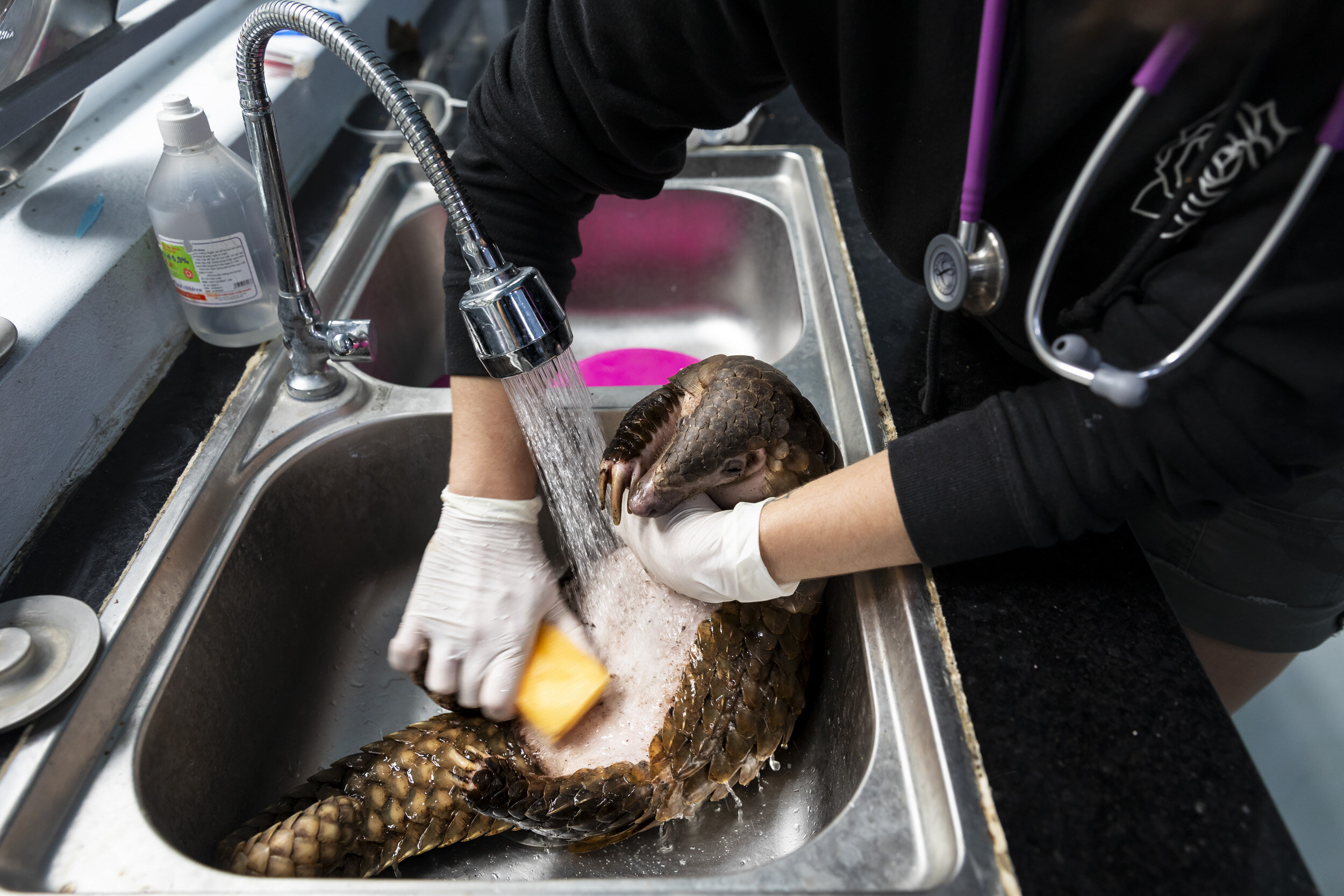
CUC PHUONG, VIETNAM, 8 NOVEMBER 2018: Save Vietnam’s Wildlife veterinary manager Jessica Jimerson bathes a recently arrived pangolin that has been rescued from the trafficking industry.. Most of the Pangolins that are rescued by SVW come from Indonesia and Borneo. They are often caught in snares and badly injured, then they are subjected to weeks of trafficking to Vietnam where they are highly desireably in high end restaurants or go on to the northern border with China where they are more lucrative. SVW was founded in 2014 by Thai Van Nguyen to expand the conservation activities of the CPCP. Since then it was evolved into a organization that advocates globally and nationally for pangolins, small carnivore and all threatened species in Vietnam. It has opened Vietnam’s first pangolin and small carnivore education center and has successfully lobbied to have pangolins scales removed from the National health schemes and works with other rescues centers to raise staff capacity and animal welfare standards across Vietnam. Today SVW focuses on the rescue, rehabilitation and release of carnivores and pangolins confiscated from the illegal wildlife trade; and the development of global conservation breeding program for threatened carnivores and pangolins. (Photo by Brent Stirton/Getty Images for National Geographic Magazine.)
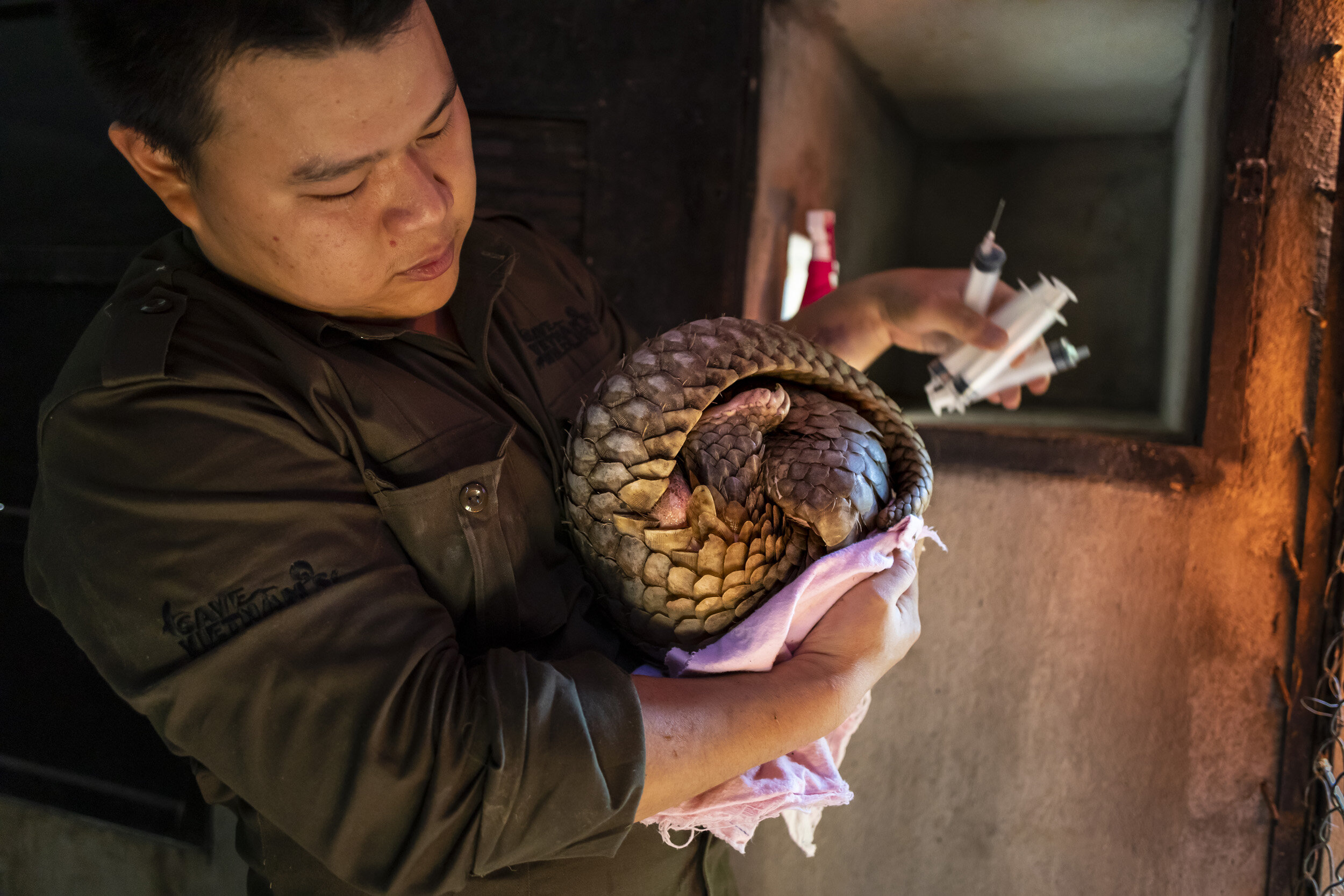
CUC PHUONG, VIETNAM, 2 NOVEMBER 2018: Save Vietnam’s Wildlife veterinarian Lam Kim Hai rehydrates rescued, traumatized pangolins in SVW’s rehabilitation center. SVW was founded in 2014 by Thai Van Nguyen to expand the conservation activities of the CPCP. Since then it was evolved into a organization that advocates globally and nationally for pangolins, small carnivore and all threatened species in Vietnam. It has opened Vietnam’s first pangolin and small carnivore education center and has successfully lobbied to have pangolins scales removed from the National health schemes and works with other rescues centers to raise staff capacity and animal welfare standards across Vietnam. Today SVW focuses on the rescue, rehabilitation and release of carnivores and pangolins confiscated from the illegal wildlife trade; and the development of global conservation breeding program for threatened carnivores and pangolins. (Photo by Brent Stirton/Getty Images for National Geographic Magazine.)
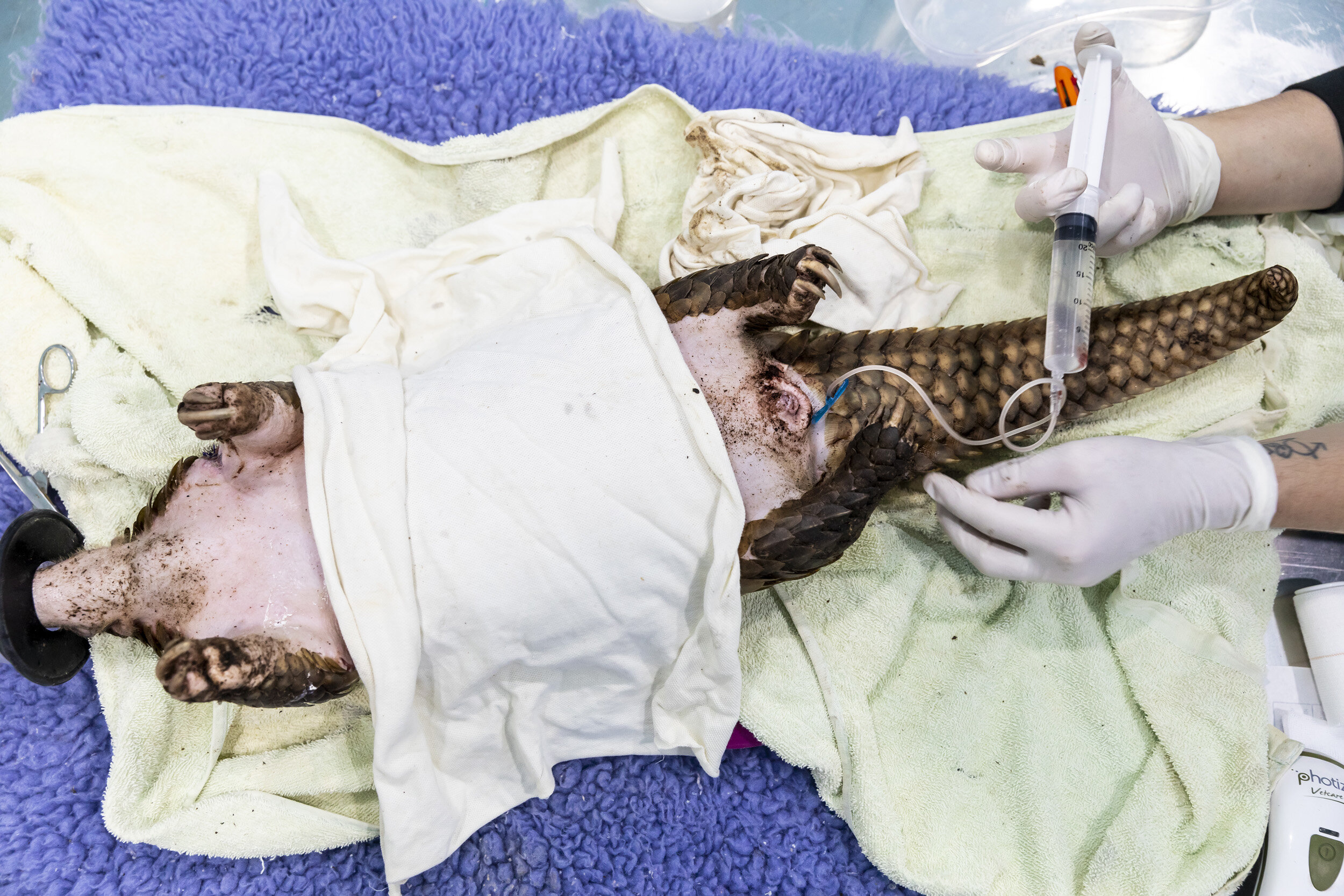
CUC PHUONG, VIETNAM, 9 NOVEMBER 2018: Save Vietnam’s Wildlife veterinary manager Jessica Jimerson works on rehydrating a trafficked pangolin in SVW’s rehabilitation center. Most of the Pangolins that are rescued by SVW come from Indonesia and Borneo. They are often caught in snares and badly injured, then they are subjected to weeks of trafficking to Vietnam where they are highly desireably in high end restaurants or go on to the northern border with China where they are more lucrative. SVW was founded in 2014 by Thai Van Nguyen to expand the conservation activities of the CPCP. Since then it was evolved into a organization that advocates globally and nationally for pangolins, small carnivore and all threatened species in Vietnam. It has opened Vietnam’s first pangolin and small carnivore education center and has successfully lobbied to have pangolins scales removed from the National health schemes and works with other rescues centers to raise staff capacity and animal welfare standards across Vietnam. Today SVW focuses on the rescue, rehabilitation and release of carnivores and pangolins confiscated from the illegal wildlife trade; and the development of global conservation breeding program for threatened carnivores and pangolins. (Photo by Brent Stirton/Getty Images for National Geographic Magazine.)
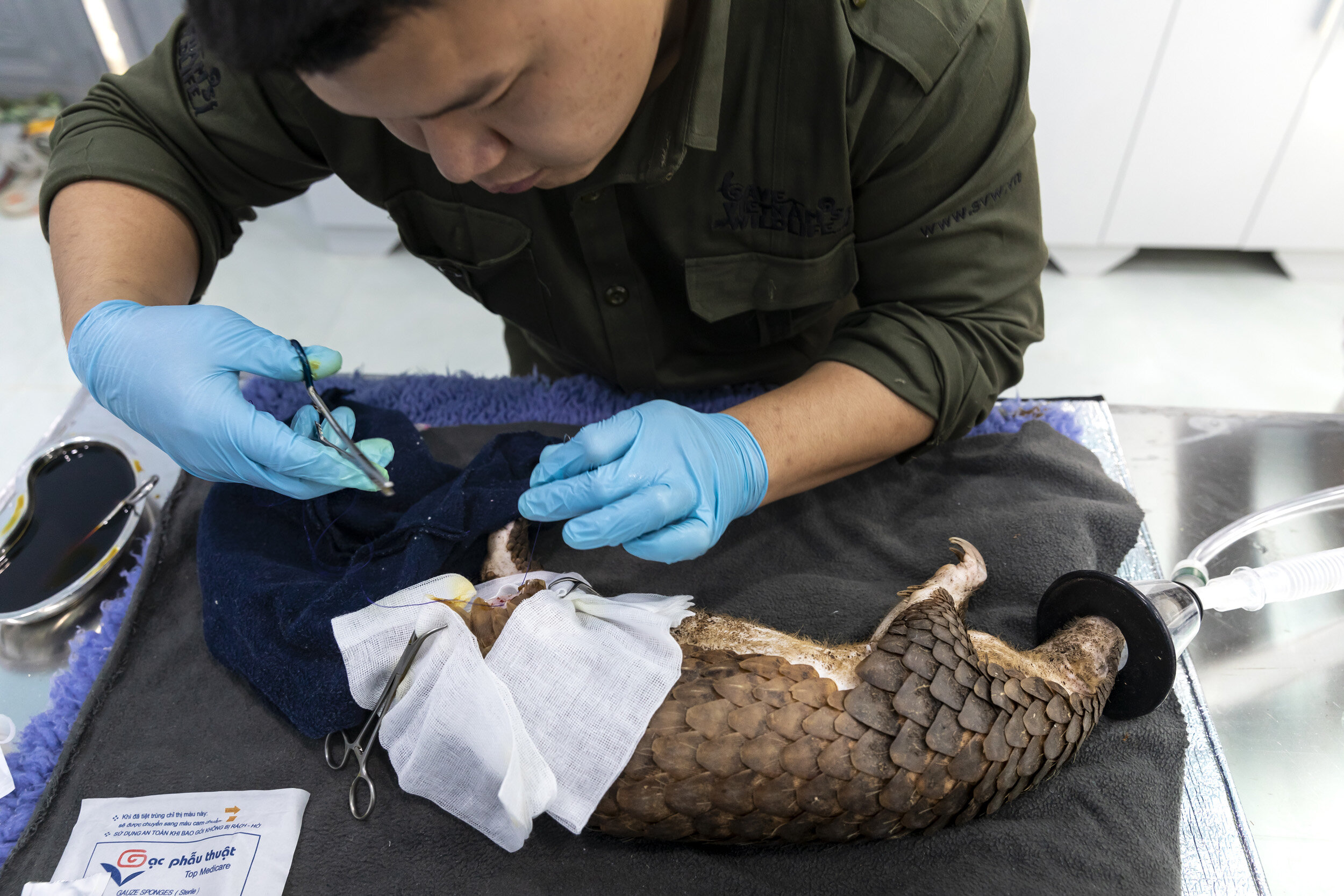
CUC PHUONG, VIETNAM, 2 NOVEMBER 2018: Save Vietnam’s Wildlife veterinarian Lam Kim Hai works on a rescued trafficked pangolin that had it’s hind leg severely damaged in a poachers snare. He had to amputate the leg as a result. SVW was founded in 2014 by Thai Van Nguyen to expand the conservation activities of the CPCP. Since then it was evolved into a organization that advocates globally and nationally for pangolins, small carnivore and all threatened species in Vietnam. It has opened Vietnam’s first pangolin and small carnivore education center and has successfully lobbied to have pangolins scales removed from the National health schemes and works with other rescues centers to raise staff capacity and animal welfare standards across Vietnam. Today SVW focuses on the rescue, rehabilitation and release of carnivores and pangolins confiscated from the illegal wildlife trade; and the development of global conservation breeding program for threatened carnivores and pangolins. (Photo by Brent Stirton/Getty Images for National Geographic Magazine.)
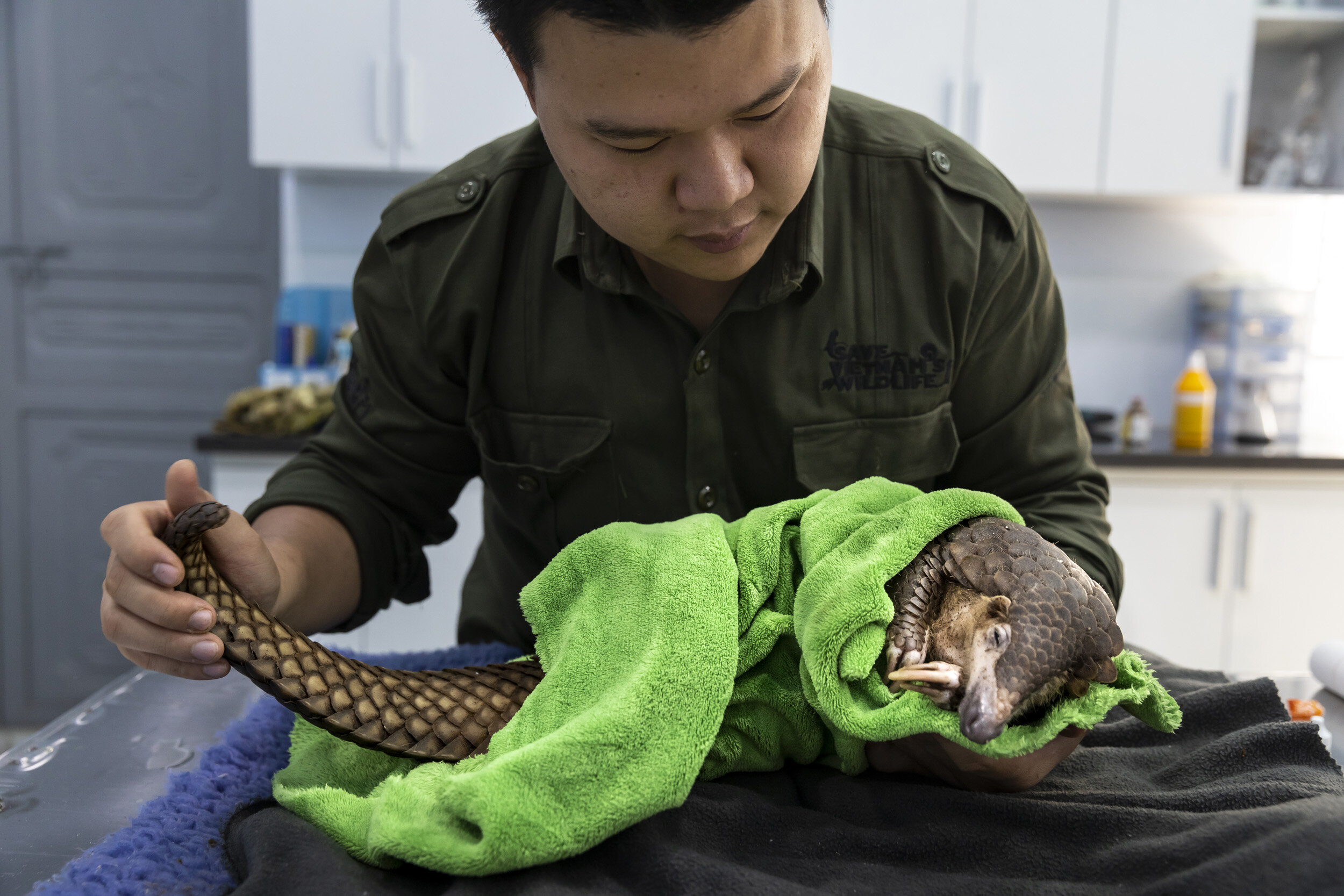
CUC PHUONG, VIETNAM, 2 NOVEMBER 2018: Save Vietnam’s Wildlife veterinarian Lam Kim Hai works on a rescued trafficked pangolin that had it’s hind leg severely damaged in a poachers snare. He had to amputate the leg as a result. SVW was founded in 2014 by Thai Van Nguyen to expand the conservation activities of the CPCP. Since then it was evolved into a organization that advocates globally and nationally for pangolins, small carnivore and all threatened species in Vietnam. It has opened Vietnam’s first pangolin and small carnivore education center and has successfully lobbied to have pangolins scales removed from the National health schemes and works with other rescues centers to raise staff capacity and animal welfare standards across Vietnam. Today SVW focuses on the rescue, rehabilitation and release of carnivores and pangolins confiscated from the illegal wildlife trade; and the development of global conservation breeding program for threatened carnivores and pangolins. (Photo by Brent Stirton/Getty Images for National Geographic Magazine.)
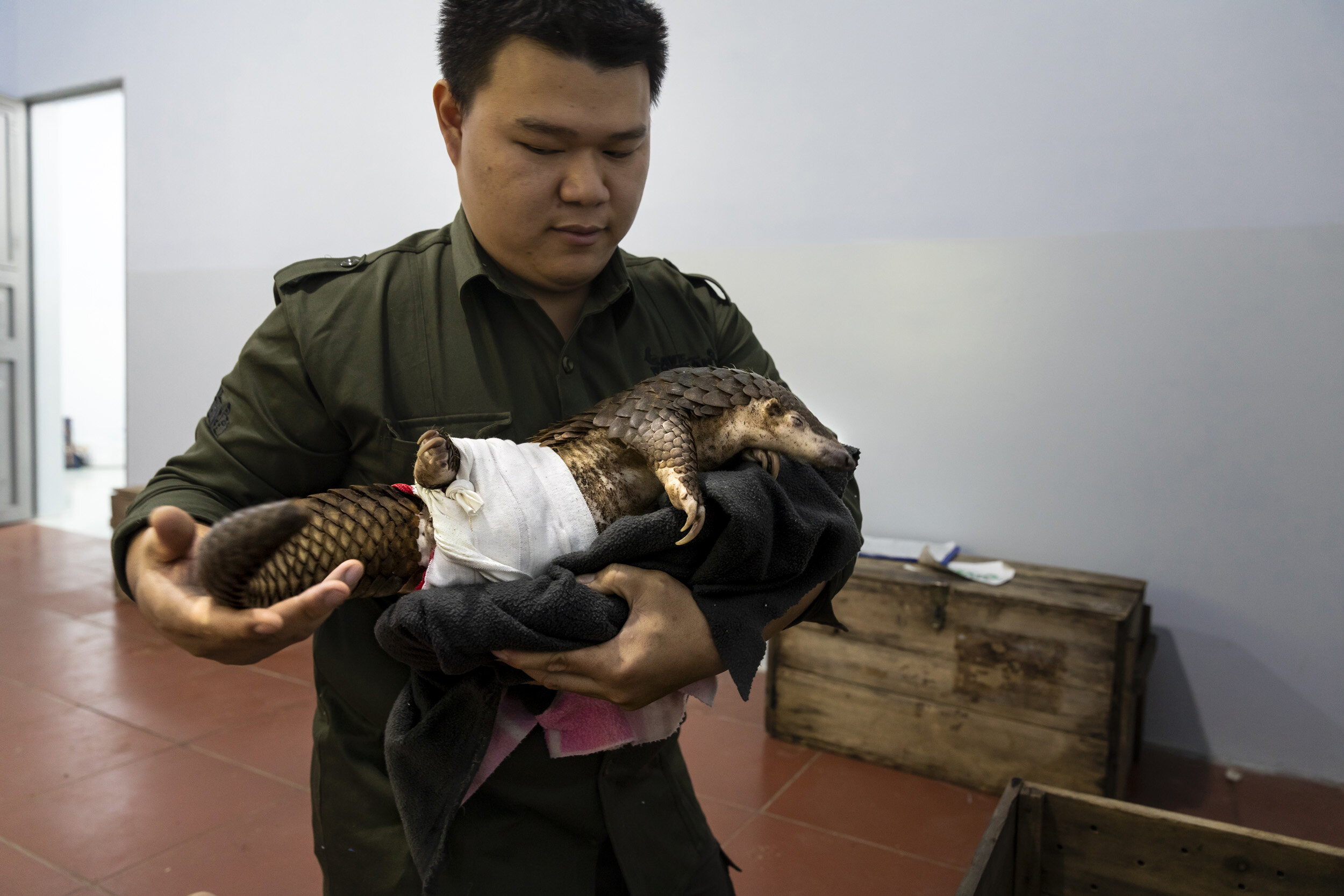
CUC PHUONG, VIETNAM, 2 NOVEMBER 2018: Save Vietnam’s Wildlife veterinarian Lam Kim Hai works on a rescued trafficked pangolin that had it’s hind leg severely damaged in a poachers snare. He had to amputate the leg as a result. SVW was founded in 2014 by Thai Van Nguyen to expand the conservation activities of the CPCP. Since then it was evolved into a organization that advocates globally and nationally for pangolins, small carnivore and all threatened species in Vietnam. It has opened Vietnam’s first pangolin and small carnivore education center and has successfully lobbied to have pangolins scales removed from the National health schemes and works with other rescues centers to raise staff capacity and animal welfare standards across Vietnam. Today SVW focuses on the rescue, rehabilitation and release of carnivores and pangolins confiscated from the illegal wildlife trade; and the development of global conservation breeding program for threatened carnivores and pangolins. (Photo by Brent Stirton/Getty Images for National Geographic Magazine.)
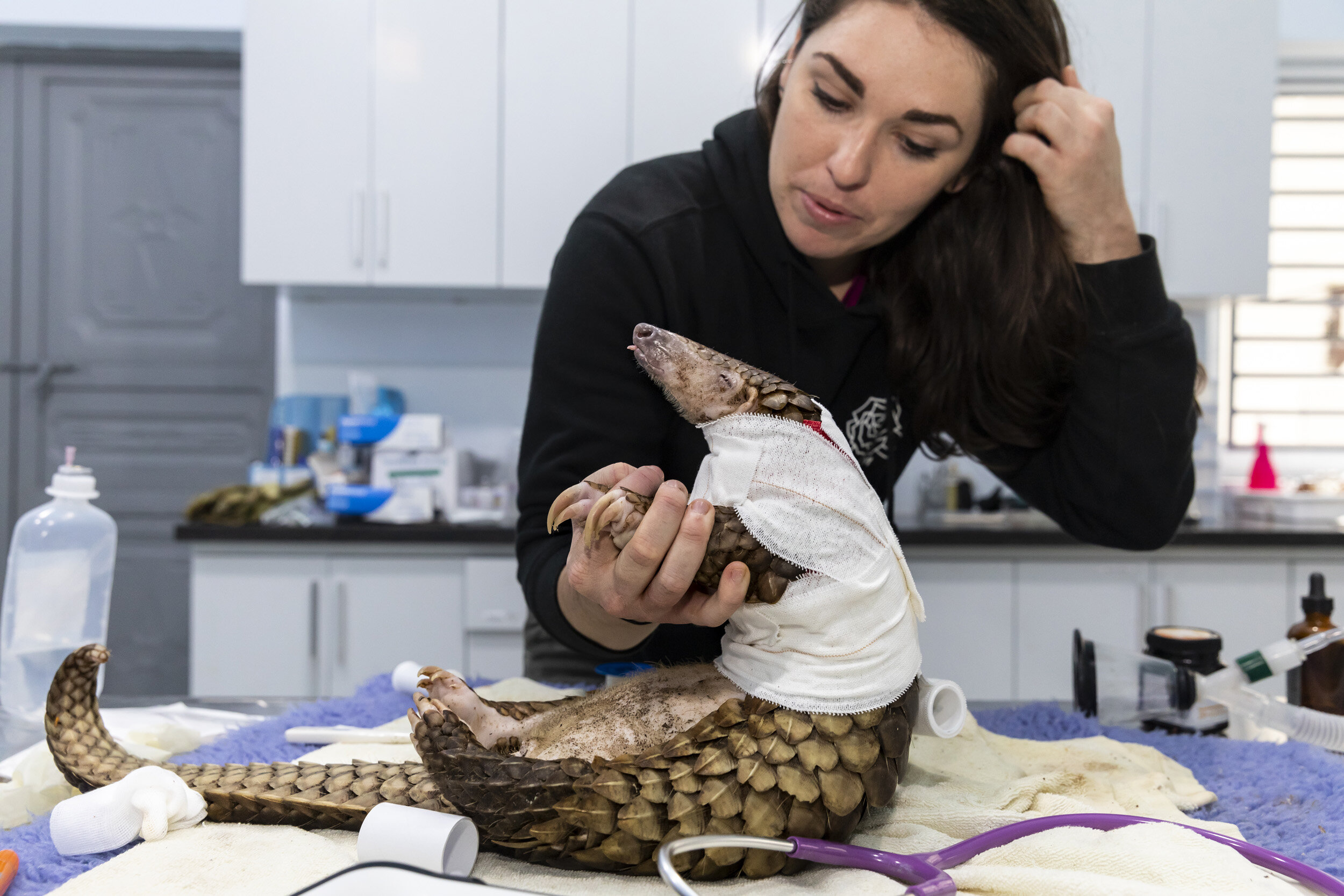
CUC PHUONG, VIETNAM, 8 NOVEMBER 2018: Save Vietnam’s Wildlife veterinary manager Jessica Jimerson works on a badly injured snared pangolin in SVW’s rehabilitation center. Most of the Pangolins that are rescued by SVW come from Indonesia and Borneo. They are often caught in snares and badly injured, then they are subjected to weeks of trafficking to Vietnam where they are highly desireably in high end restaurants or go on to the northern border with China where they are more lucrative. SVW was founded in 2014 by Thai Van Nguyen to expand the conservation activities of the CPCP. Since then it was evolved into a organization that advocates globally and nationally for pangolins, small carnivore and all threatened species in Vietnam. It has opened Vietnam’s first pangolin and small carnivore education center and has successfully lobbied to have pangolins scales removed from the National health schemes and works with other rescues centers to raise staff capacity and animal welfare standards across Vietnam. Today SVW focuses on the rescue, rehabilitation and release of carnivores and pangolins confiscated from the illegal wildlife trade; and the development of global conservation breeding program for threatened carnivores and pangolins. (Photo by Brent Stirton/Getty Images for National Geographic Magazine.)
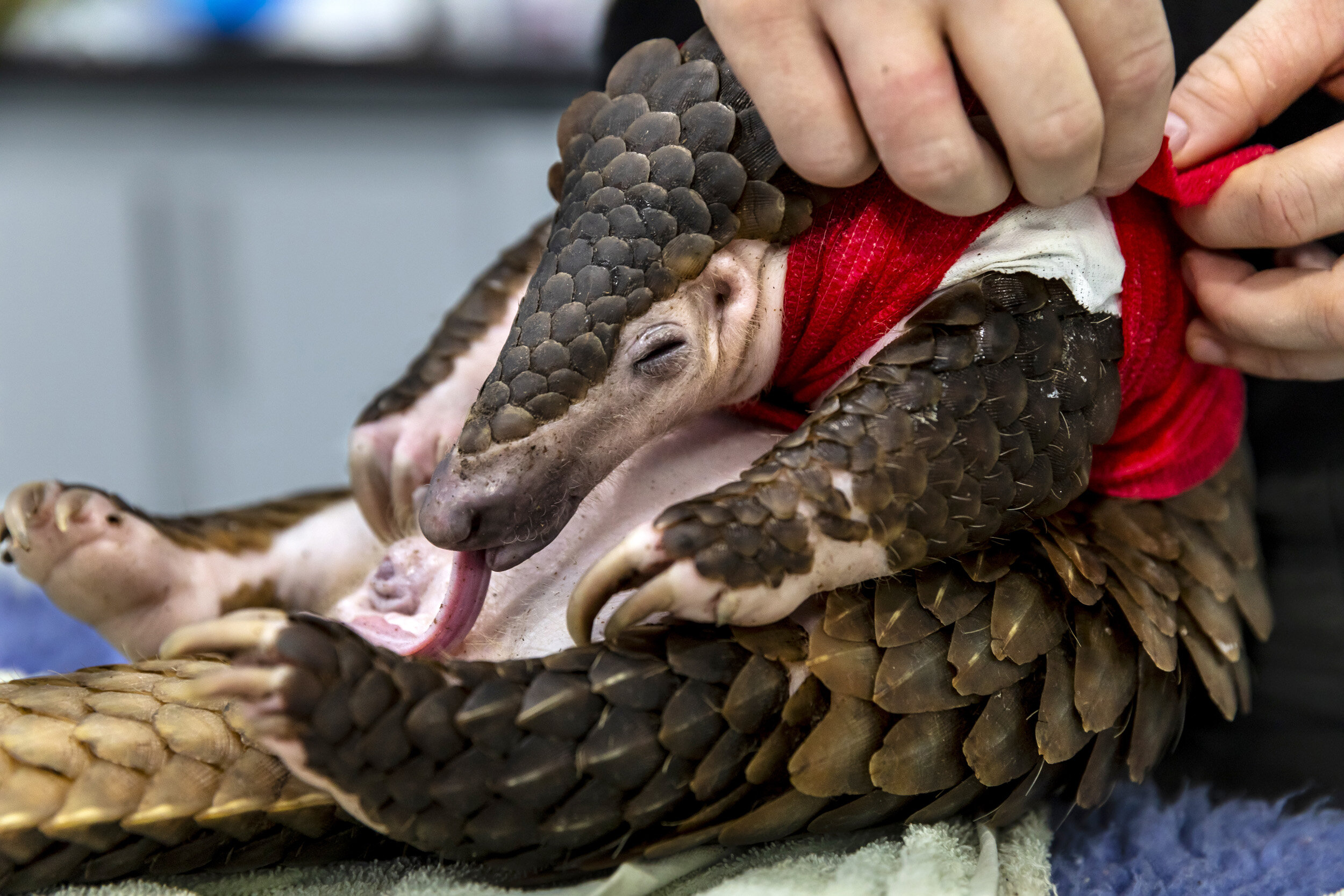
CUC PHUONG, VIETNAM, 8 NOVEMBER 2018: Save Vietnam’s Wildlife veterinary manager Jessica Jimerson works on a badly injured snared pangolin in SVW’s rehabilitation center. Most of the Pangolins that are rescued by SVW come from Indonesia and Borneo. They are often caught in snares and badly injured, then they are subjected to weeks of trafficking to Vietnam where they are highly desireably in high end restaurants or go on to the northern border with China where they are more lucrative. SVW was founded in 2014 by Thai Van Nguyen to expand the conservation activities of the CPCP. Since then it was evolved into a organization that advocates globally and nationally for pangolins, small carnivore and all threatened species in Vietnam. It has opened Vietnam’s first pangolin and small carnivore education center and has successfully lobbied to have pangolins scales removed from the National health schemes and works with other rescues centers to raise staff capacity and animal welfare standards across Vietnam. Today SVW focuses on the rescue, rehabilitation and release of carnivores and pangolins confiscated from the illegal wildlife trade; and the development of global conservation breeding program for threatened carnivores and pangolins. (Photo by Brent Stirton/Getty Images for National Geographic Magazine.)
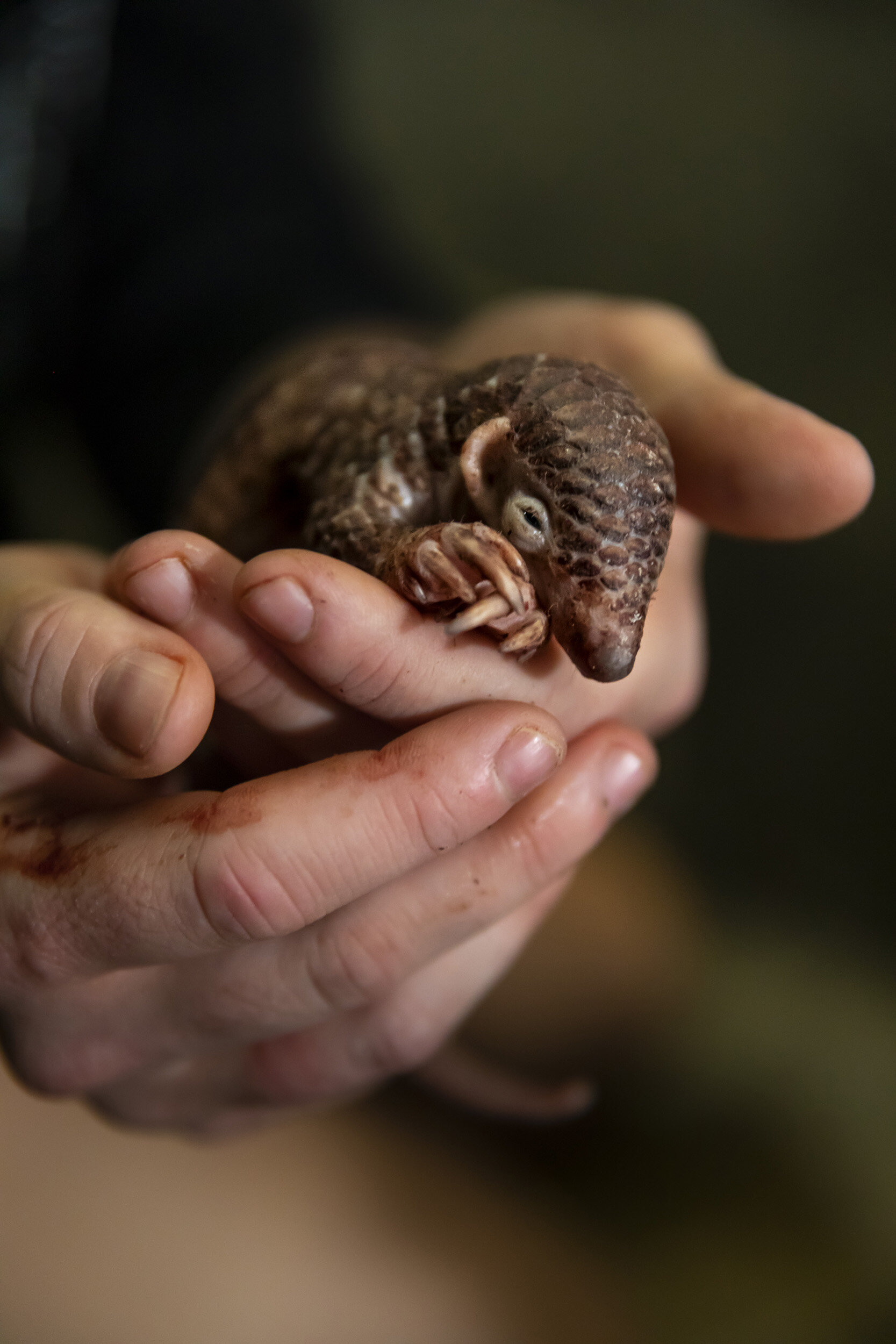
CUC PHUONG, VIETNAM, 9 NOVEMBER 2018: Save Vietnam’s Wildlife welcomes a 2 day old pangolin baby in SVW’s rehabilitation center. Blood was seen in the enclosure so the baby was quickly inspected and placed back with the mother. This is a trafficked pangolin female and sometimes the stress causes premature birth or misscarriage. Most of the Pangolins that are rescued by SVW come from Indonesia and Borneo. They are often caught in snares and badly injured, then they are subjected to weeks of trafficking to Vietnam where they are highly desireably in high end restaurants or go on to the northern border with China where they are more lucrative. SVW was founded in 2014 by Thai Van Nguyen to expand the conservation activities of the CPCP. Since then it was evolved into a organization that advocates globally and nationally for pangolins, small carnivore and all threatened species in Vietnam. It has opened Vietnam’s first pangolin and small carnivore education center and has successfully lobbied to have pangolins scales removed from the National health schemes and works with other rescues centers to raise staff capacity and animal welfare standards across Vietnam. Today SVW focuses on the rescue, rehabilitation and release of carnivores and pangolins confiscated from the illegal wildlife trade; and the development of global conservation breeding program for threatened carnivores and pangolins. (Photo by Brent Stirton/Getty Images for National Geographic Magazine.)
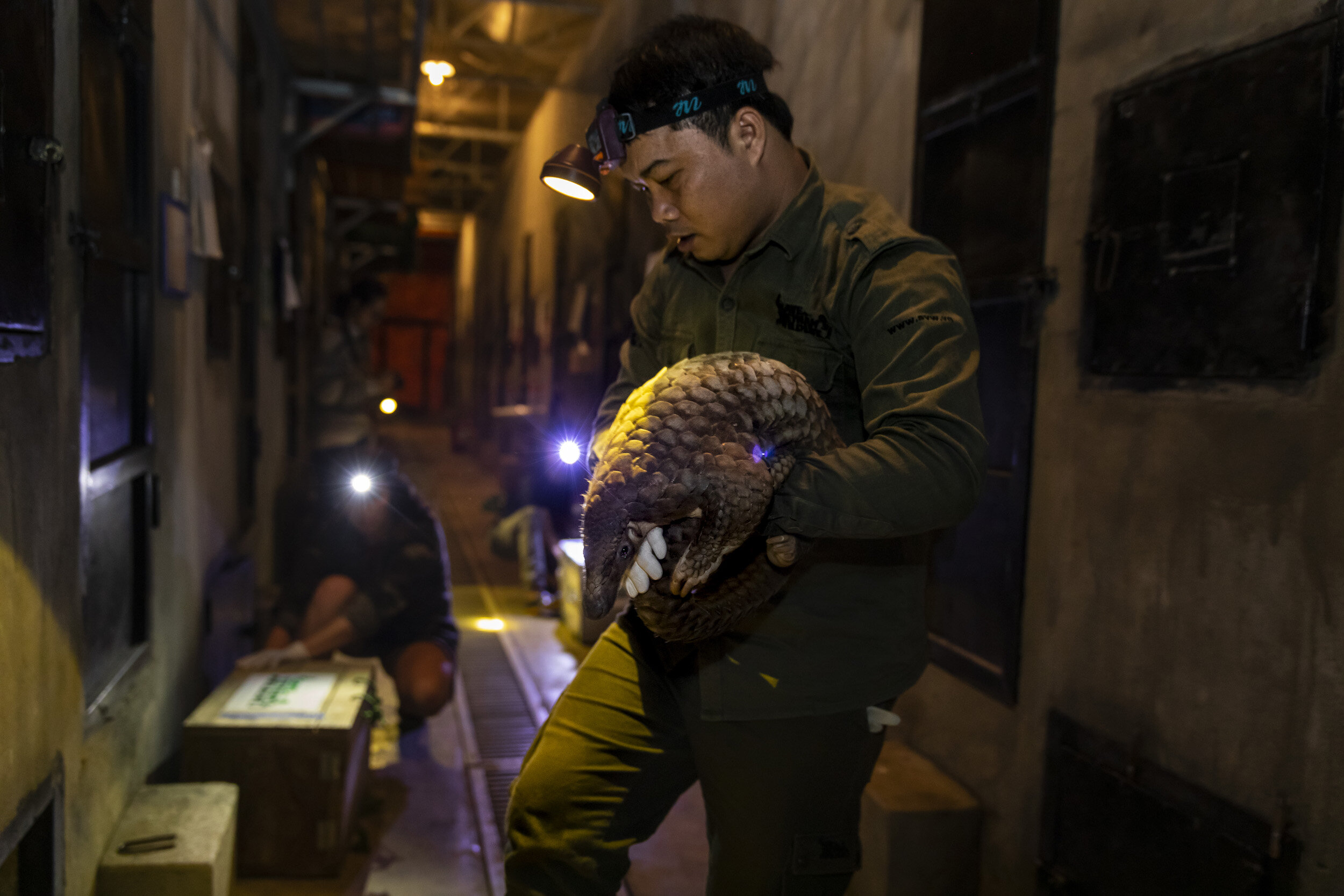
CUC PHUONG, VIETNAM, 11 NOVEMBER 2018: Save Vietnam’s Wildlife founder Thai Van Nguyen readies rescued pangolins for transport in SVW’s rehabilitation center. On this occasion 25 trafficked pangolins were rescued and rehabilitated by SVW and will be releases in remote Pu Mat National Park. SVW released over 420 rescued pangolins in 2017 and will likely release more than that in 2018. Most of the Pangolins that are rescued by SVW come from Indonesia and Borneo. They are often caught in snares and badly injured, then they are subjected to weeks of trafficking to Vietnam where they are highly desireably in high end restaurants or go on to the northern border with China where they are more lucrative. SVW was founded in 2014 by Thai Van Nguyen to expand the conservation activities of the CPCP. Since then it was evolved into a organization that advocates globally and nationally for pangolins, small carnivore and all threatened species in Vietnam. It has opened Vietnam’s first pangolin and small carnivore education center and has successfully lobbied to have pangolins scales removed from the National health schemes and works with other rescues centers to raise staff capacity and animal welfare standards across Vietnam. Today SVW focuses on the rescue, rehabilitation and release of carnivores and pangolins confiscated from the illegal wildlife trade; and the development of global conservation breeding program for threatened carnivores and pangolins. (Photo by Brent Stirton/Getty Images for National Geographic Magazine.)
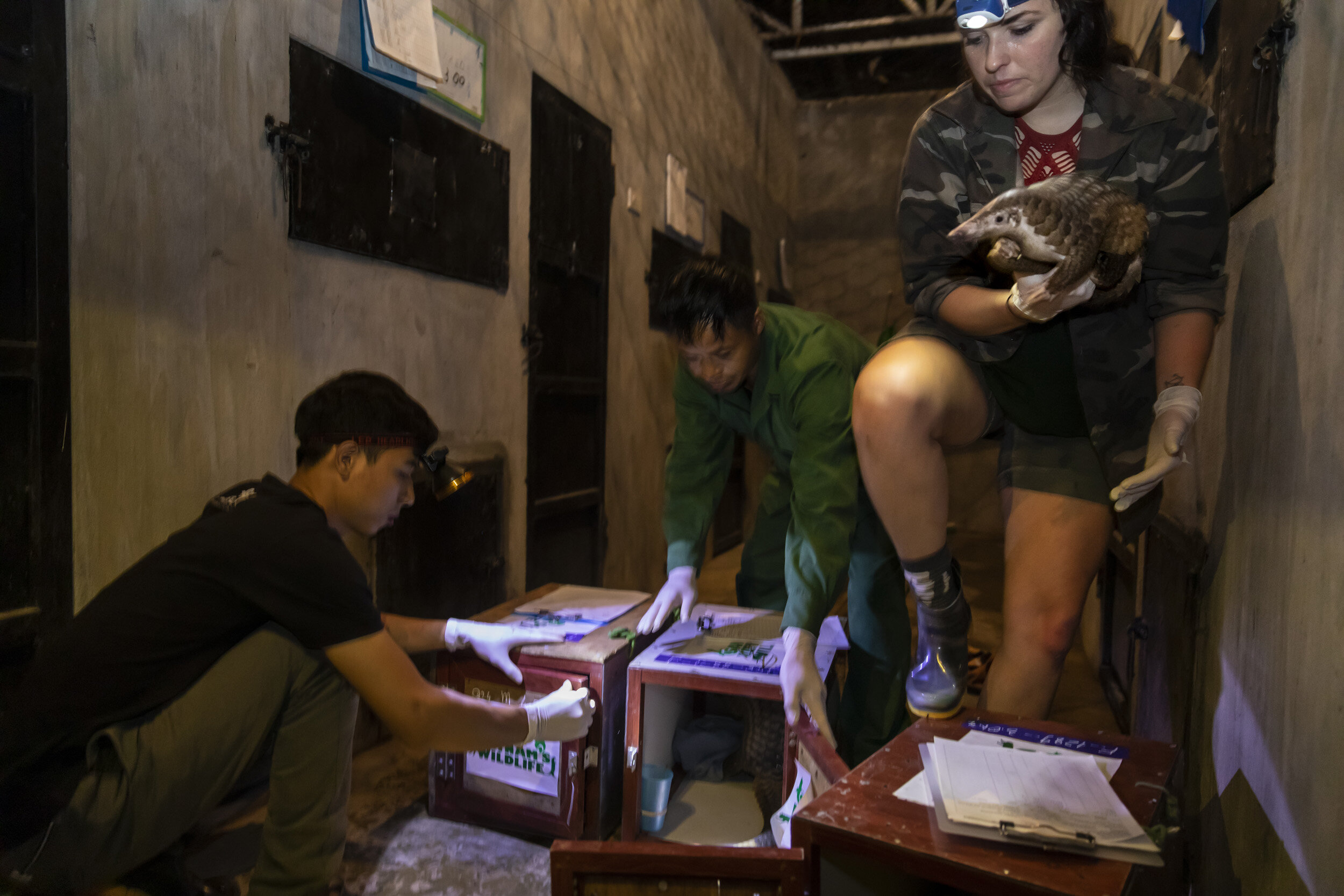
CUC PHUONG, VIETNAM, 11 NOVEMBER 2018: Save Vietnam’s Wildlife personel ready rescued pangolins for transport in SVW’s rehabilitation center. On this occasion 25 trafficked pangolins rescued and rehabilitated by SVW will be released in remote Pu Mat National Park. SVW released over 420 rescued pangolins in 2017 and will likely release more than that in 2018. Most of the Pangolins that are rescued by SVW come from Indonesia and Borneo. They are often caught in snares and badly injured, then they are subjected to weeks of trafficking to Vietnam where they are highly desireably in high end restaurants or go on to the northern border with China where they are more lucrative. SVW was founded in 2014 by Thai Van Nguyen to expand the conservation activities of the CPCP. Since then it was evolved into a organization that advocates globally and nationally for pangolins, small carnivore and all threatened species in Vietnam. It has opened Vietnam’s first pangolin and small carnivore education center and has successfully lobbied to have pangolins scales removed from the National health schemes and works with other rescues centers to raise staff capacity and animal welfare standards across Vietnam. Today SVW focuses on the rescue, rehabilitation and release of carnivores and pangolins confiscated from the illegal wildlife trade; and the development of global conservation breeding program for threatened carnivores and pangolins. (Photo by Brent Stirton/Getty Images for National Geographic Magazine.)
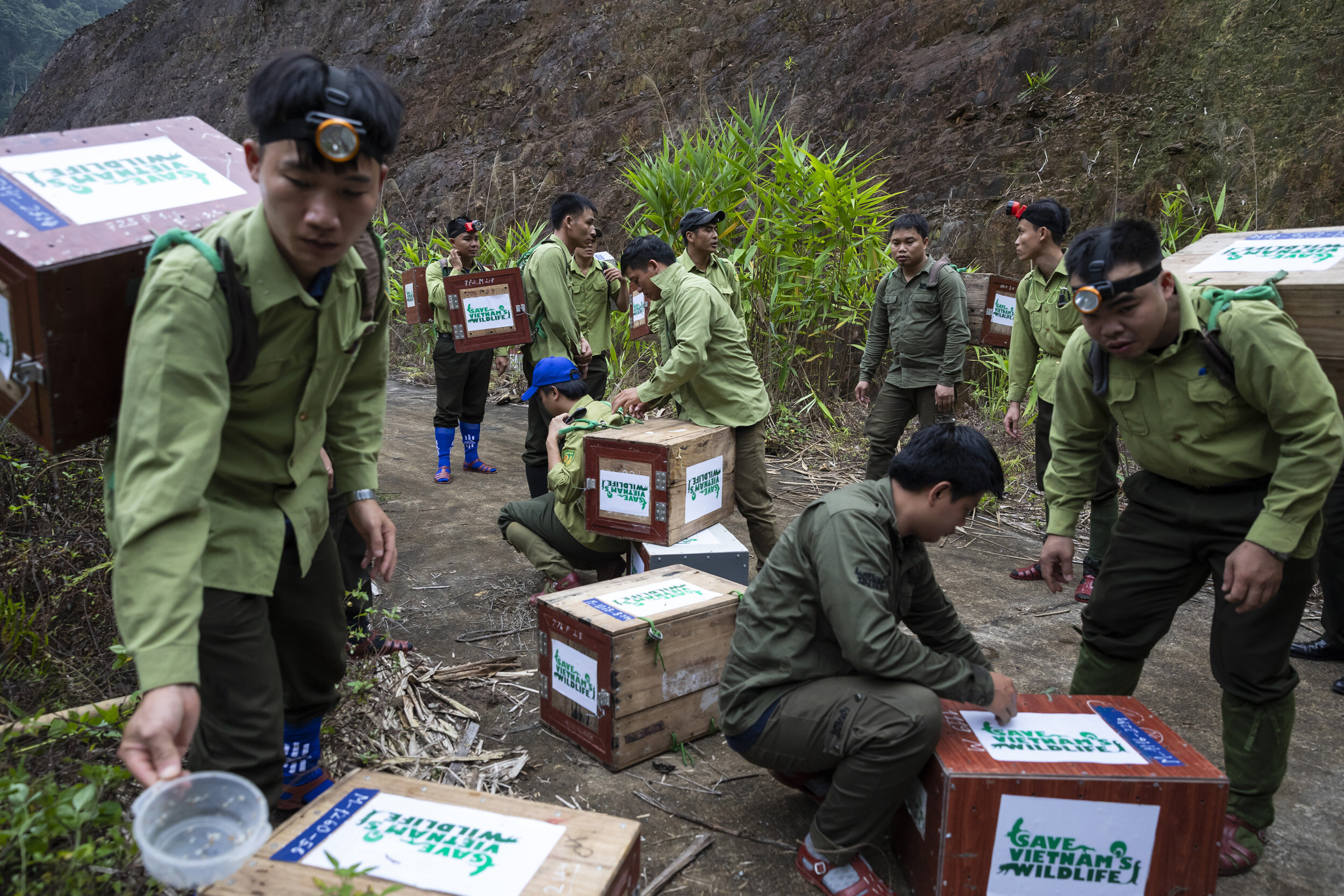
PU MAT NATIONAL PARK, VIETNAM, 11 NOVEMBER 2018: Members of Vietnam’s first Anti-poaching team and NGO Saving Vietnam’s Wildlife prepare for an evening release of 25 rescued pangolins into this remote National Park. They first feed the pangolin with ant eggs and make sure they are hydrated. They then gently carry the pangolin in boxes far upriver away from the road and release them into the bush. Save Vietnam’s Wildlife says the following about the new unit. “In 2018, we set up an Anti-Poaching Unit in Pu Mat National Park. This is being co-managed by the government and Save Vietnam’s Wildlife. This is the first ever example of a co-managed ranger unit in the country. We are now busy training this unit and making sure they have the skills needed to patrol Pu Mat National Park. This unit will also work with our community outreach team, to ensure that our awareness and education activities on illegal hunting are targeted at the right groups of people. “ The 25 trafficked pangolins were rescued and rehabilitated by n.g.o Save Vietnam’s Wildlife. SVW released over 420 rescued pangolins in 2017 and will likely release more than that in 2018. Most of the Pangolins that are rescued by SVW come from Indonesia and Borneo. They are often caught in snares and badly injured, then they are subjected to weeks of trafficking to Vietnam where they are highly desireably in high end restaurants or go on to the northern border with China where they are more lucrative. SVW was founded in 2014 by Thai Van Nguyen to expand the conservation activities of the CPCP. Since then it was evolved into a organization that advocates globally and nationally for pangolins, small carnivore and all threatened species in Vietnam. It has opened Vietnam’s first pangolin and small carnivore education center and has successfully lobbied to have pangolins scales removed from the National health schemes and works with other rescues centers to raise staff capacity and animal welfare standar
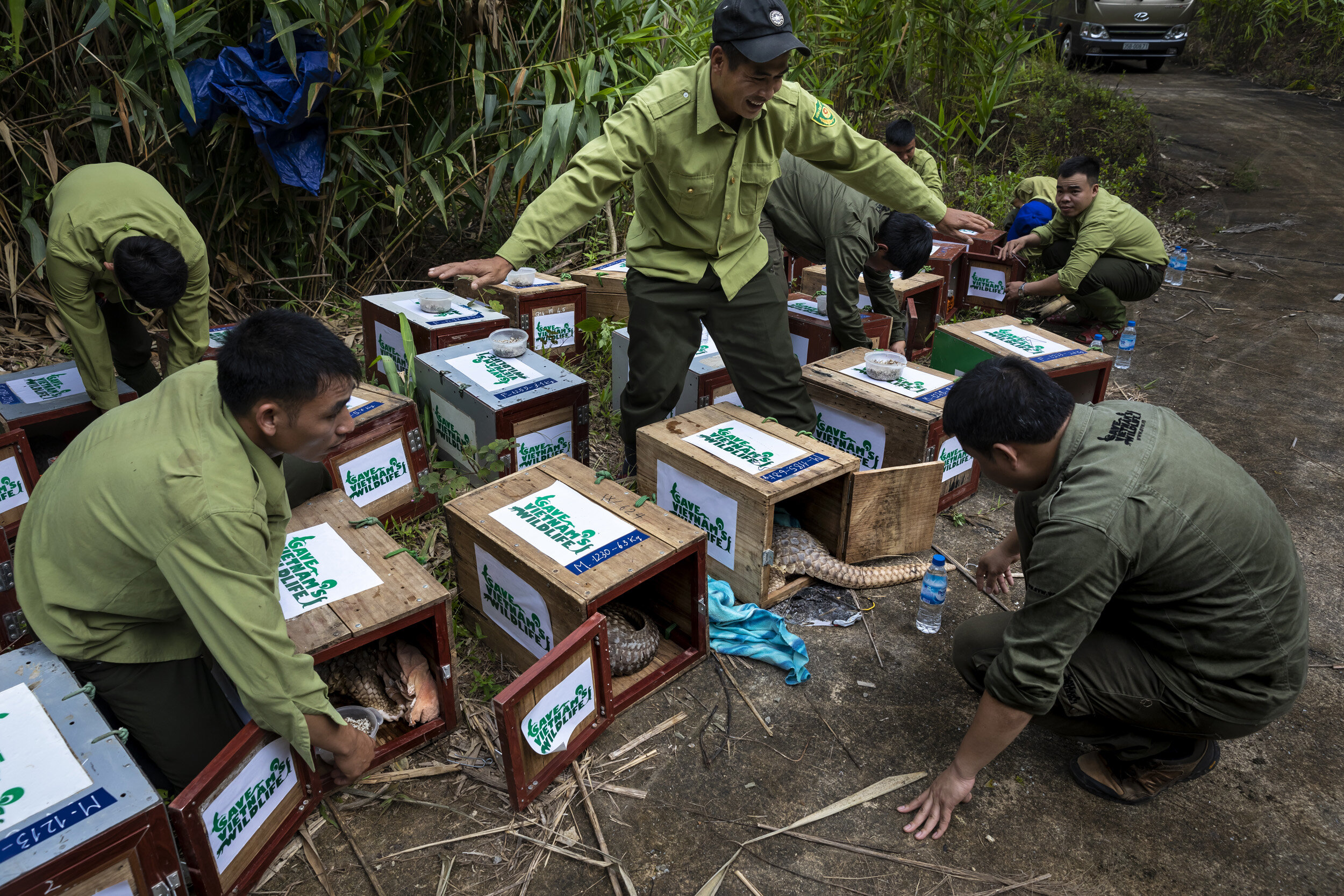
PU MAT NATIONAL PARK, VIETNAM, 11 NOVEMBER 2018: Members of Vietnam’s first Anti-poaching team and NGO Saving Vietnam’s Wildlife prepare for an evening release of 25 rescued pangolins into this remote National Park. They first feed the pangolin with ant eggs and make sure they are hydrated. They then gently carry the pangolin in boxes far upriver away from the road and release them into the bush. Save Vietnam’s Wildlife says the following about the new unit. “In 2018, we set up an Anti-Poaching Unit in Pu Mat National Park. This is being co-managed by the government and Save Vietnam’s Wildlife. This is the first ever example of a co-managed ranger unit in the country. We are now busy training this unit and making sure they have the skills needed to patrol Pu Mat National Park. This unit will also work with our community outreach team, to ensure that our awareness and education activities on illegal hunting are targeted at the right groups of people. “ The 25 trafficked pangolins were rescued and rehabilitated by n.g.o Save Vietnam’s Wildlife. SVW released over 420 rescued pangolins in 2017 and will likely release more than that in 2018. Most of the Pangolins that are rescued by SVW come from Indonesia and Borneo. They are often caught in snares and badly injured, then they are subjected to weeks of trafficking to Vietnam where they are highly desireably in high end restaurants or go on to the northern border with China where they are more lucrative. SVW was founded in 2014 by Thai Van Nguyen to expand the conservation activities of the CPCP. Since then it was evolved into a organization that advocates globally and nationally for pangolins, small carnivore and all threatened species in Vietnam. It has opened Vietnam’s first pangolin and small carnivore education center and has successfully lobbied to have pangolins scales removed from the National health schemes and works with other rescues centers to raise staff capacity and animal welfare standar
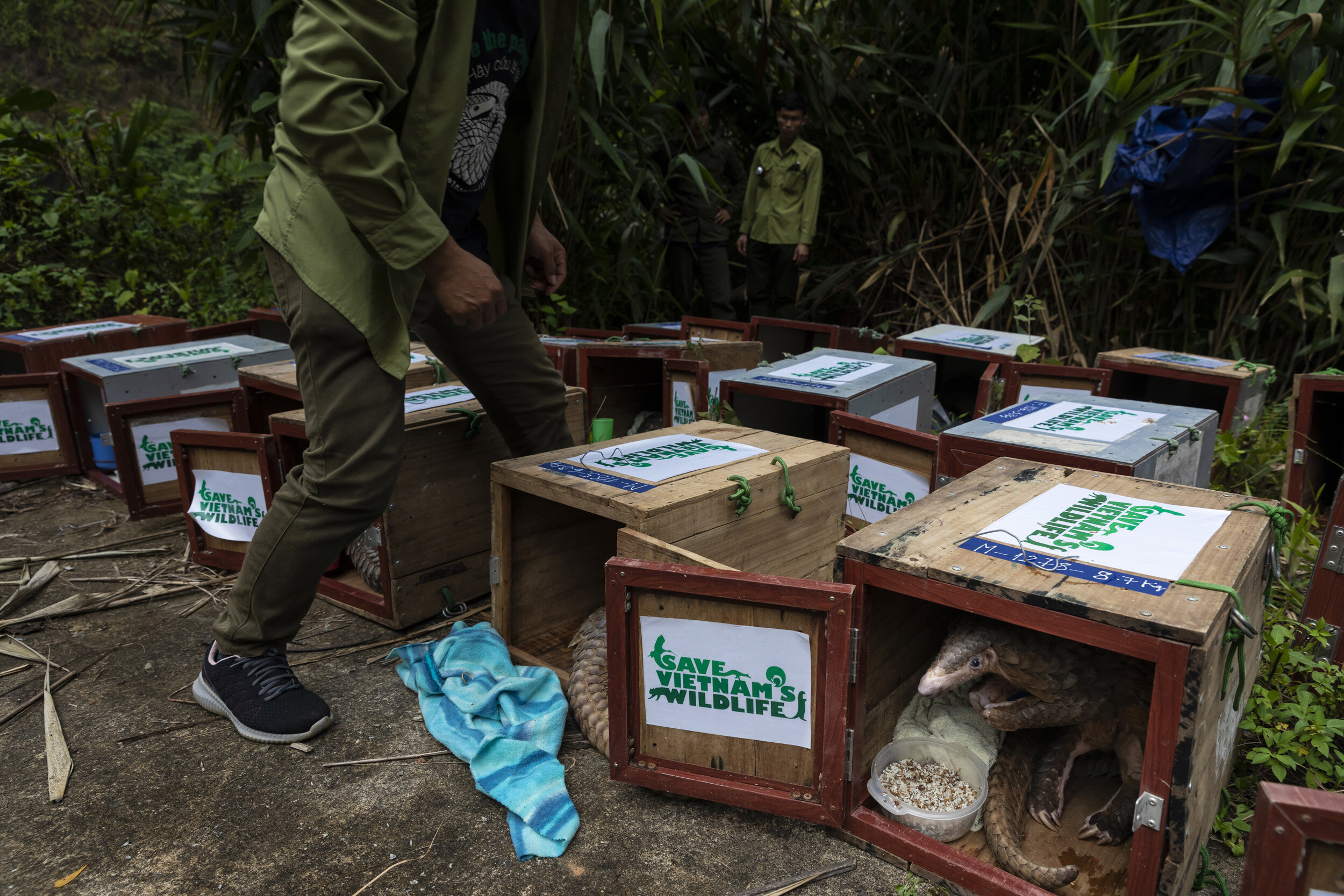
PU MAT NATIONAL PARK, VIETNAM, 11 NOVEMBER 2018: Members of Vietnam’s first Anti-poaching team and NGO Saving Vietnam’s Wildlife prepare for an evening release of 25 rescued pangolins into this remote National Park. They first feed the pangolin with ant eggs and make sure they are hydrated. They then gently carry the pangolin in boxes far upriver away from the road and release them into the bush. Save Vietnam’s Wildlife says the following about the new unit. “In 2018, we set up an Anti-Poaching Unit in Pu Mat National Park. This is being co-managed by the government and Save Vietnam’s Wildlife. This is the first ever example of a co-managed ranger unit in the country. We are now busy training this unit and making sure they have the skills needed to patrol Pu Mat National Park. This unit will also work with our community outreach team, to ensure that our awareness and education activities on illegal hunting are targeted at the right groups of people. “ The 25 trafficked pangolins were rescued and rehabilitated by n.g.o Save Vietnam’s Wildlife. SVW released over 420 rescued pangolins in 2017 and will likely release more than that in 2018. Most of the Pangolins that are rescued by SVW come from Indonesia and Borneo. They are often caught in snares and badly injured, then they are subjected to weeks of trafficking to Vietnam where they are highly desireably in high end restaurants or go on to the northern border with China where they are more lucrative. SVW was founded in 2014 by Thai Van Nguyen to expand the conservation activities of the CPCP. Since then it was evolved into a organization that advocates globally and nationally for pangolins, small carnivore and all threatened species in Vietnam. It has opened Vietnam’s first pangolin and small carnivore education center and has successfully lobbied to have pangolins scales removed from the National health schemes and works with other rescues centers to raise staff capacity and animal welfare standar
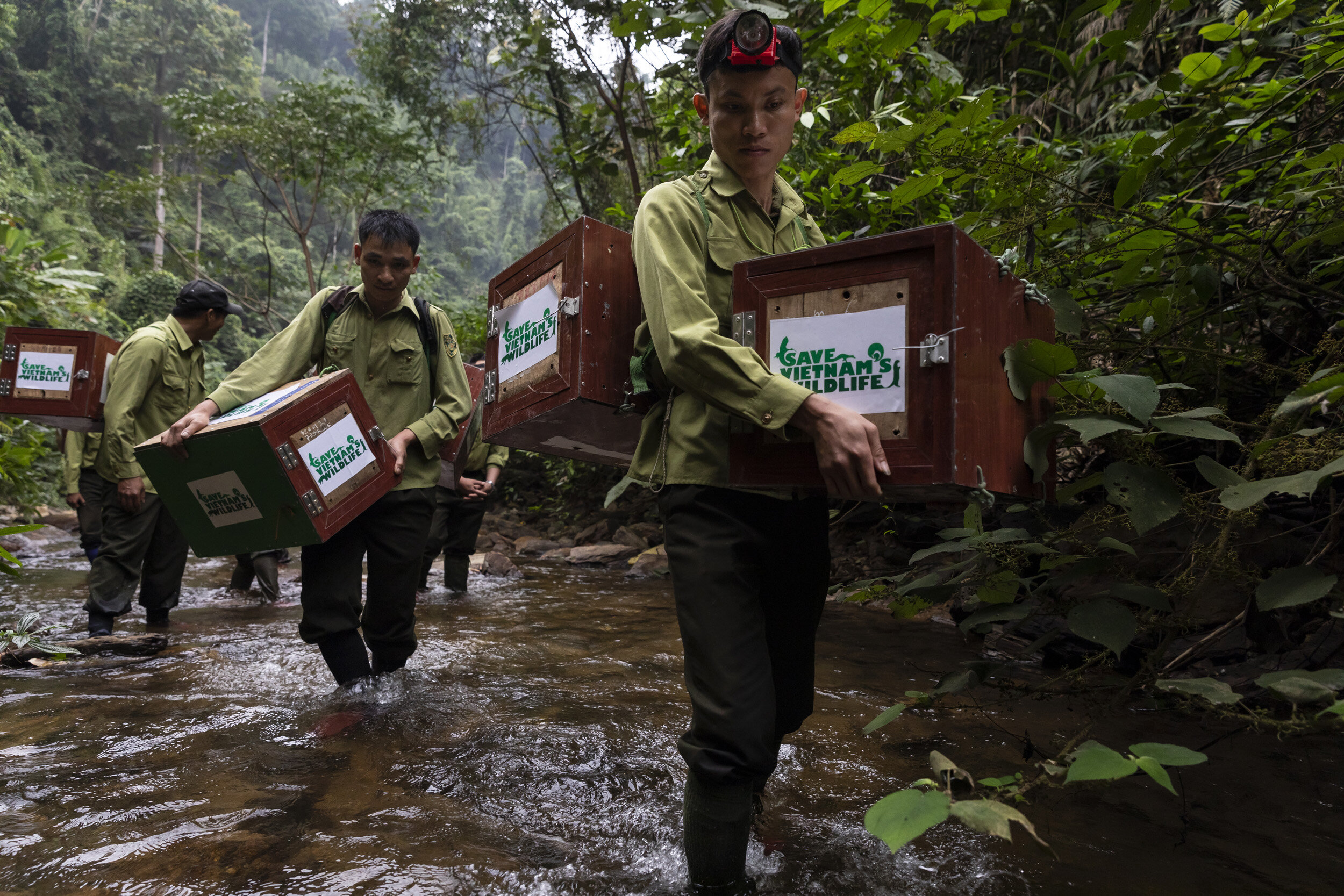
PU MAT NATIONAL PARK, VIETNAM, 11 NOVEMBER 2018: Members of Vietnam’s first Anti-poaching team and NGO Saving Vietnam’s Wildlife walk upriver and release 25 rescued pangolins into this remote National Park. They first feed the pangolin with ant eggs and make sure they are hydrated. They then gently carry the pangolins into a secure zone and release them back into the wild. In 2018 SVW released 417 Pangolins and in 2018 it will be more. (Photo by Brent Stirton/Getty Images for National Geographic magazine.)
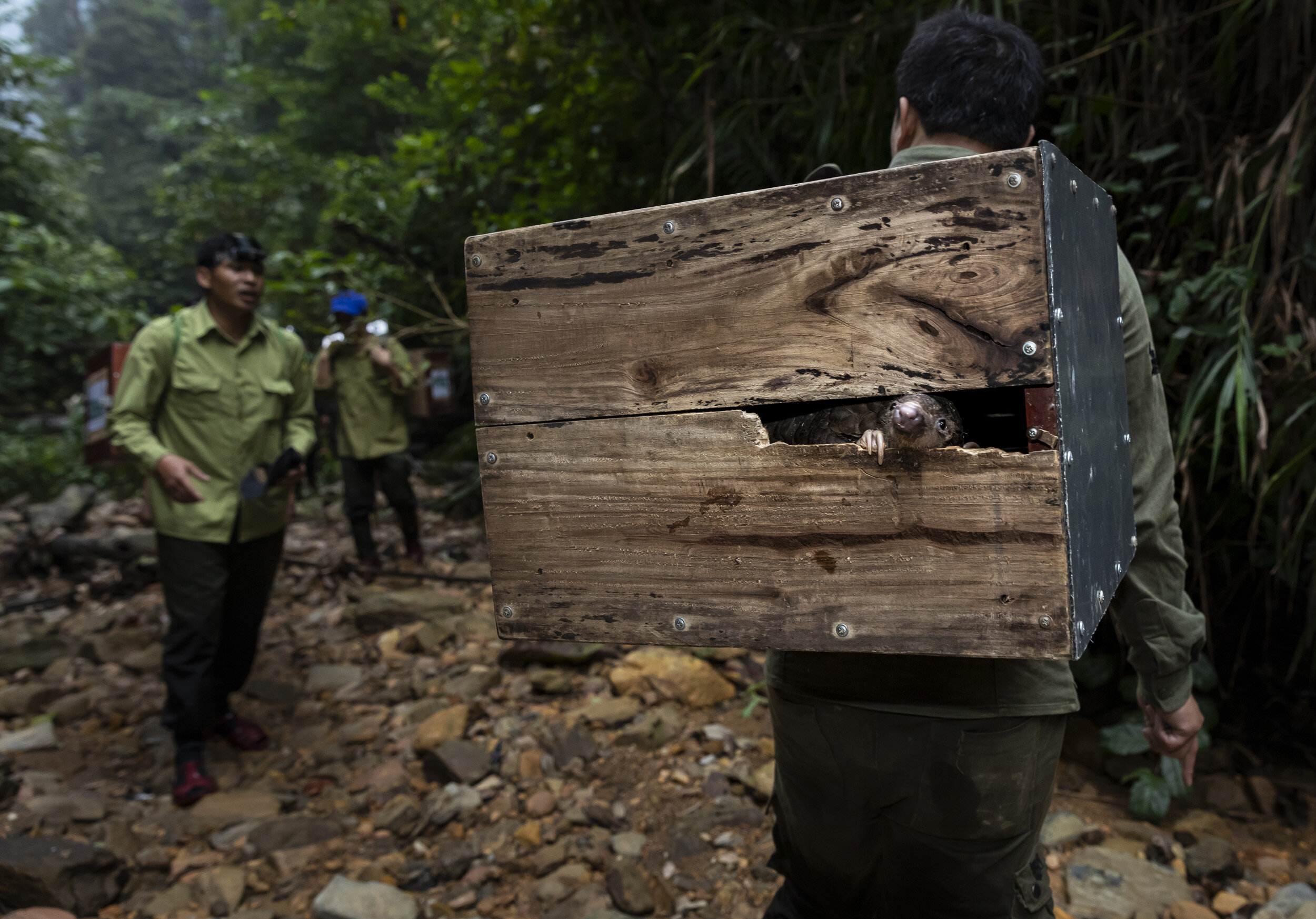
PU MAT NATIONAL PARK, VIETNAM, 11 NOVEMBER 2018: Members of Vietnam’s first Anti-poaching team and NGO Saving Vietnam’s Wildlife walk upriver and release 25 rescued pangolins into this remote National Park. They first feed the pangolin with ant eggs and make sure they are hydrated. They then gently carry the pangolins into a secure zone and release them back into the wild. In 2018 SVW released 417 Pangolins and in 2018 it will be more. (Photo by Brent Stirton/Getty Images for National Geographic magazine.)
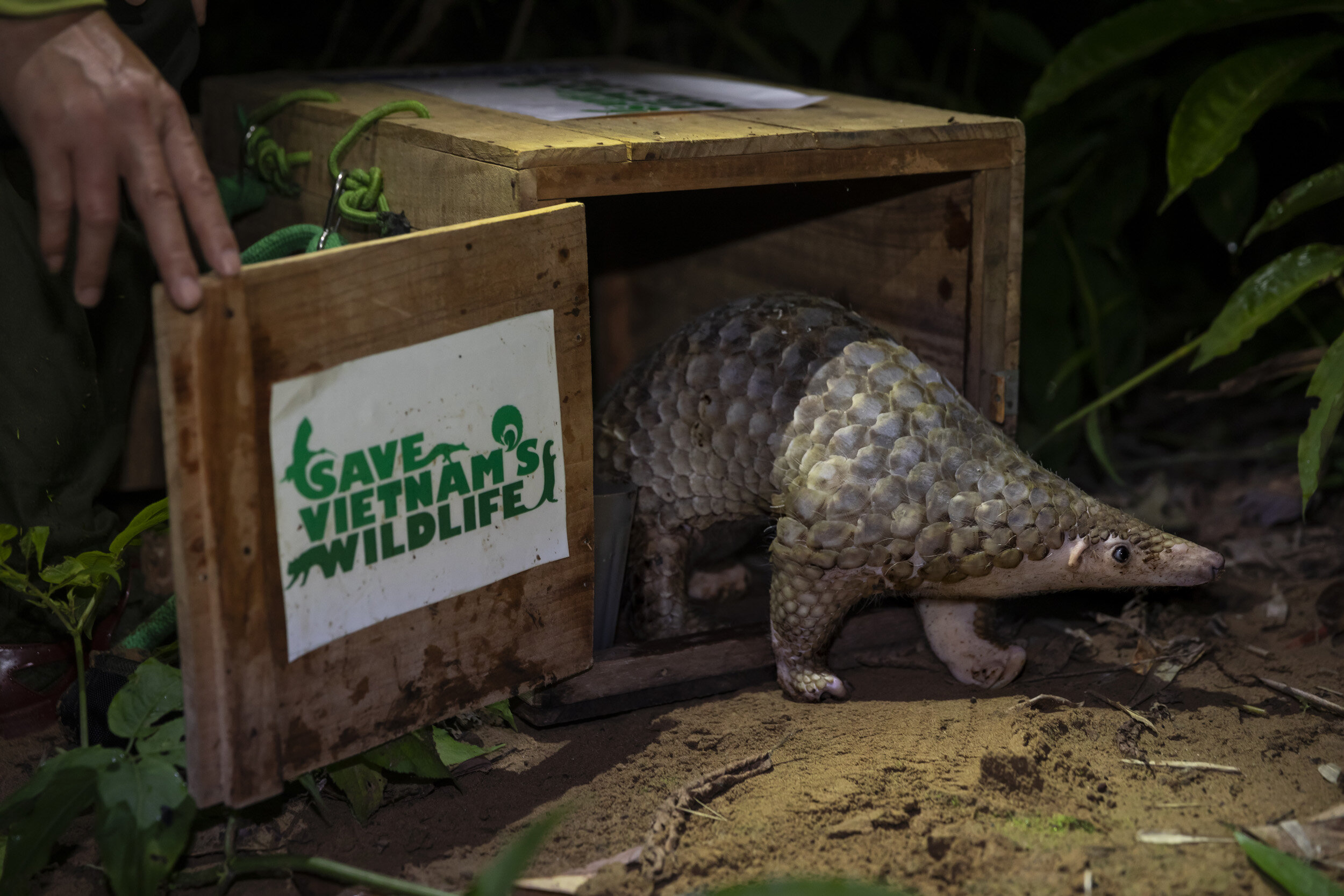
PU MAT NATIONAL PARK, VIETNAM, 11 NOVEMBER 2018: Members of Vietnam’s first Anti-poaching team and NGO Saving Vietnam’s Wildlife walk upriver and release 25 rescued pangolins into this remote National Park. They first feed the pangolin with ant eggs and make sure they are hydrated. They then gently carry the pangolins into a secure zone and release them back into the wild. In 2018 SVW released 417 Pangolins and in 2018 it will be more. (Photo by Brent Stirton/Getty Images for National Geographic magazine.)
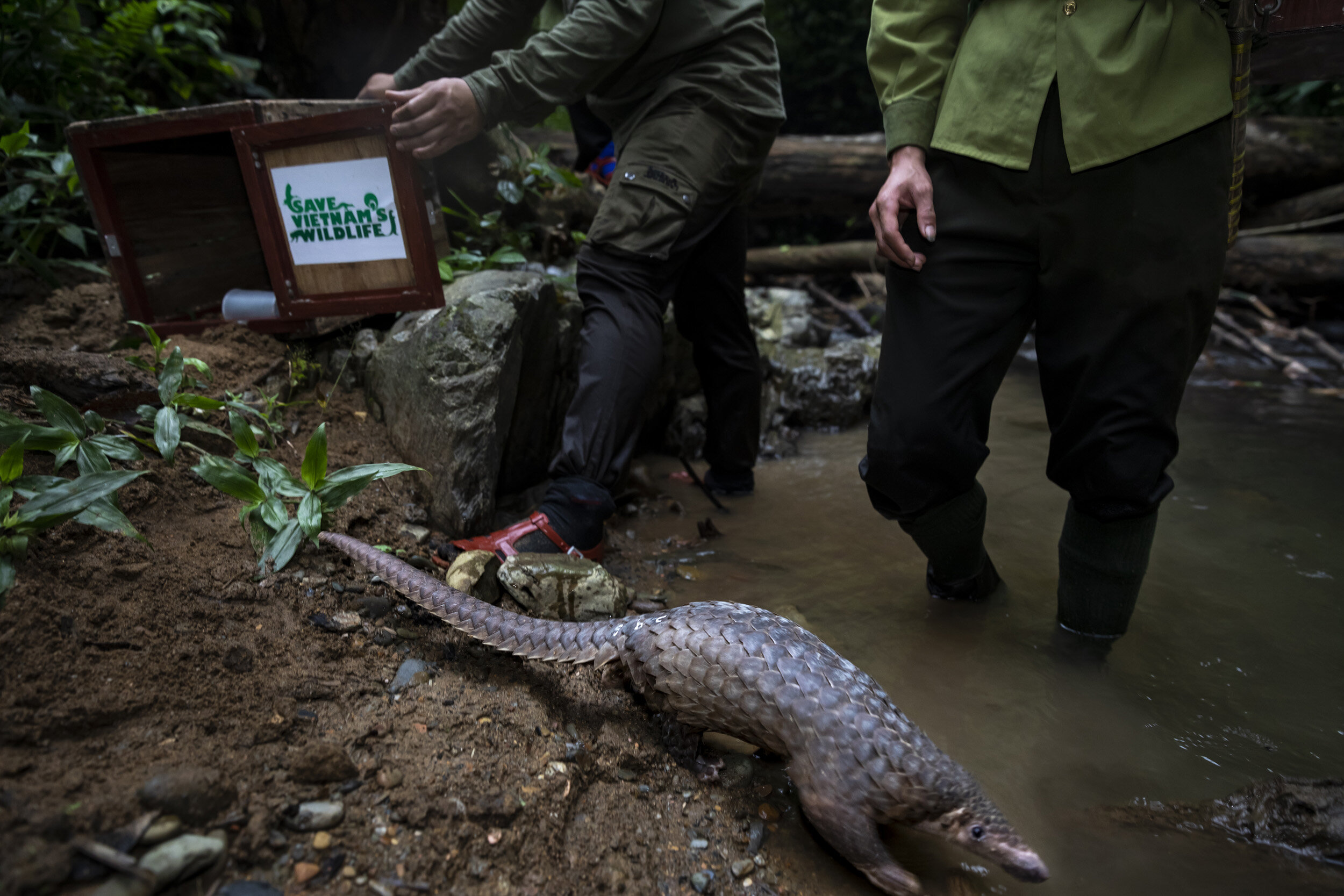
PU MAT NATIONAL PARK, VIETNAM, 11 NOVEMBER 2018: Members of Vietnam’s first Anti-poaching team and NGO Saving Vietnam’s Wildlife walk upriver and release 25 rescued pangolins into this remote National Park. They first feed the pangolin with ant eggs and make sure they are hydrated. They then gently carry the pangolins into a secure zone and release them back into the wild. In 2018 SVW released 417 Pangolins and in 2018 it will be more. (Photo by Brent Stirton/Getty Images for National Geographic magazine.)
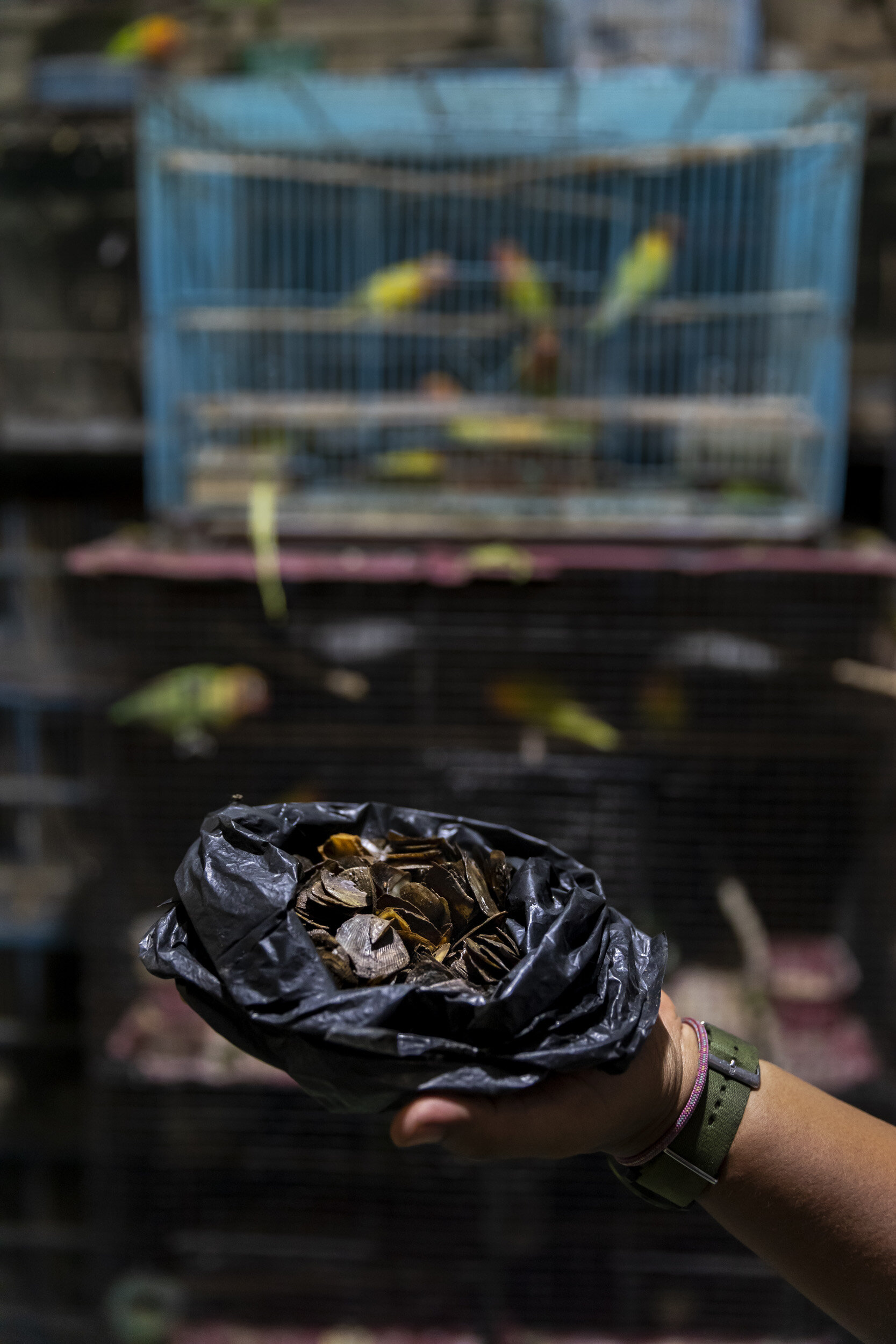
SURABAYA, BORNEO, 15 NOVEMBER 2018: A wildlife trader pangolin scales to the photographer at a bird market in Surabaya. He said he could get live pangolin for around $60 and usually had 2 or three every week. Borneo is a source country for Pangolins which are then trafficked to Vietnam, Laos and China. This trader said he did not have pangolin or pangolin scales at this time but it was not hard to get them. (Photo by Brent Stirton/Getty Images for National Geographic Magazine.)
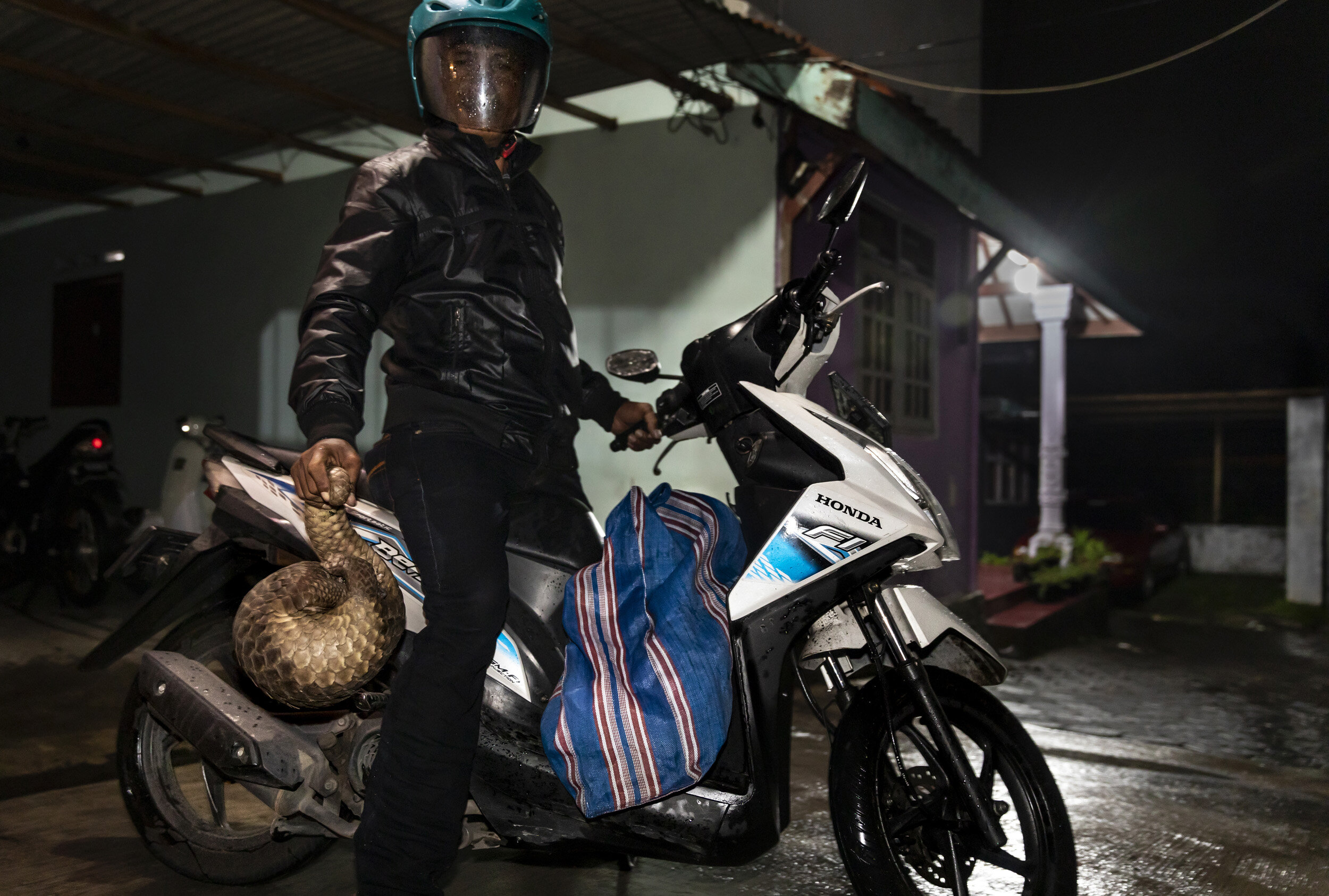
LUMAJAN, BORNEO, 31 DECEMBER 2018: Bawr, a hunter from the Sentul Village region, approximately 3 hours east of the city of Surabaya, holds a pangolin he has brought to the city to sell to a middleman. The pangolin will either be cosumed in Surabaya and its scales used for traditional medicine or it will be trafficked into Vietnam, Laos or China where it will be worth far more. Bawr says he will bring in pangolin at least twice a week. This is illegal and pangolins are listed as Appendix 1 endangered by CITES. (Photo by Brent Stirton/Getty Images for National Geographic Magazine.)
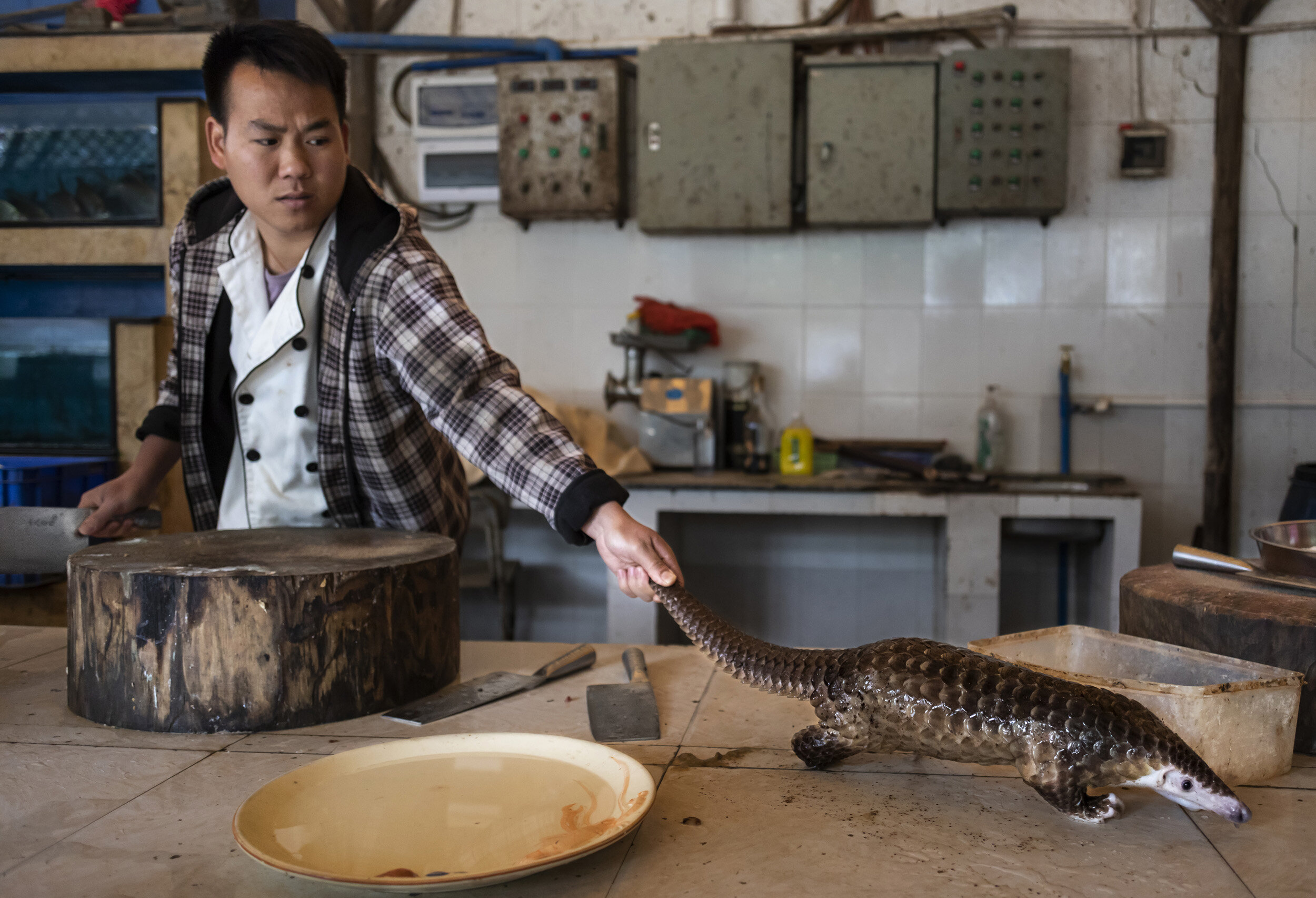
GUANGZHOU, CHINA: A Pangolin is slaughtered and prepared for a meal in a restaurant on the outskirts of Guangzhou. The price for the meal was 1200 RMB per pound of the animals weight. This pangolin was 6 pounds and was forcefed liquids before being weighed to drive the price higher. The price of the meal was 8000 RMB in total, around $1142. We were led to this restaurant by the second taxi driver we asked, the first one also said it was no problem but the owner was not able to provide a private room. It appears that it is not difficult to access these animals in this part of china. The taxi driver who broght the photographer to this restaurant says he used to be a truck driver and has brought these animals into Guangzhou from the Vietnam/China border area before. Law enforcement is apparently more lax in border regions. He said he used to buy them for around 1800 RMB and sell them for 2800 to restaurants. The restaurant owner said she only sells them live, people don’t want to buy them frozen.
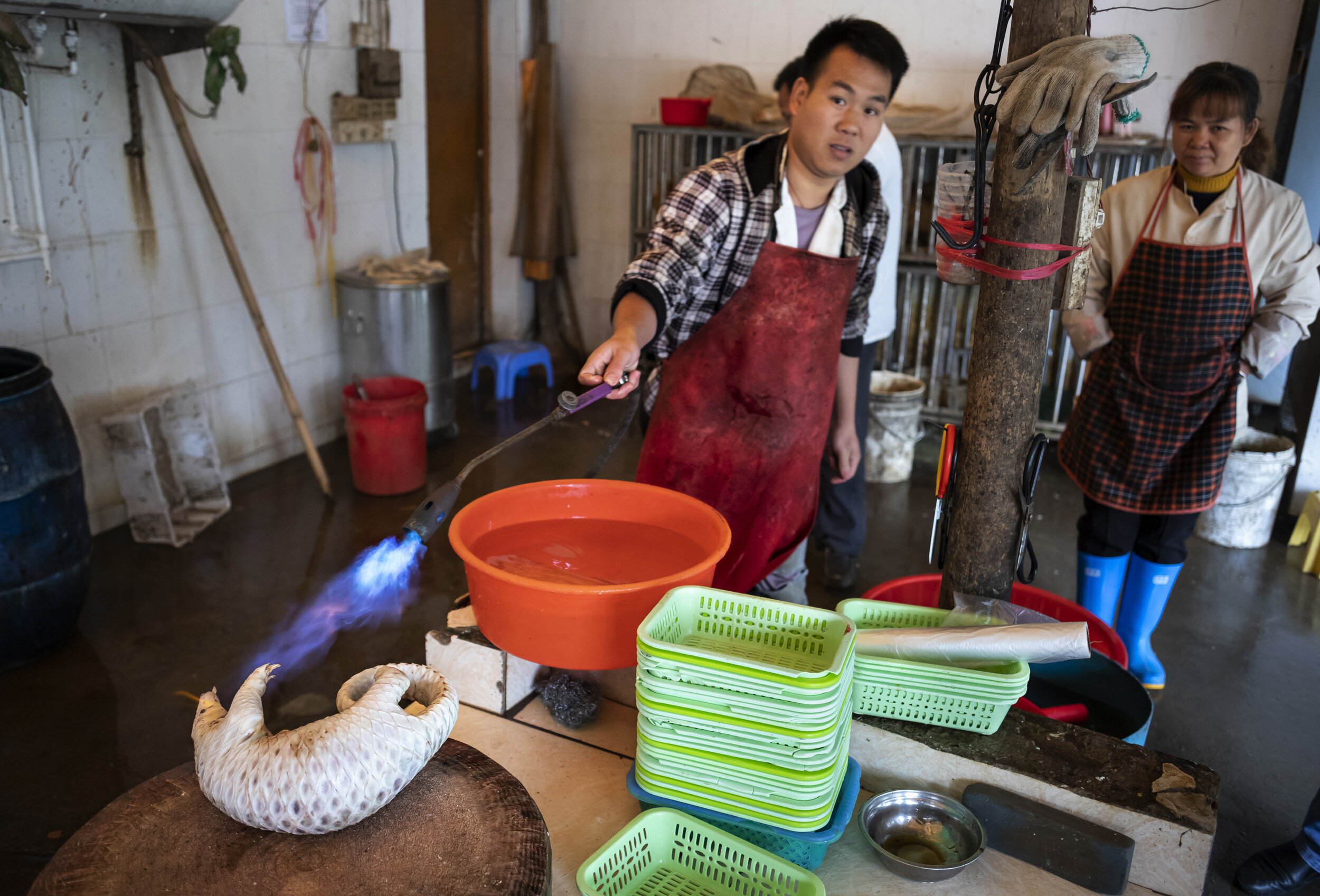
GUANGZHOU, CHINA: A Pangolin is slaughtered and prepared for a meal in a restaurant on the outskirts of Guangzhou. The price for the meal was 1200 RMB per pound of the animals weight. This pangolin was 6 pounds and was forcefed liquids before being weighed to drive the price higher. The price of the meal was 8000 RMB in total, around $1142. We were led to this restaurant by the second taxi driver we asked, the first one also said it was no problem but the owner was not able to provide a private room. It appears that it is not difficult to access these animals in this part of china. The taxi driver who broght the photographer to this restaurant says he used to be a truck driver and has brought these animals into Guangzhou from the Vietnam/China border area before. Law enforcement is apparently more lax in border regions. He said he used to buy them for around 1800 RMB and sell them for 2800 to restaurants. The restaurant owner said she only sells them live, people don’t want to buy them frozen.
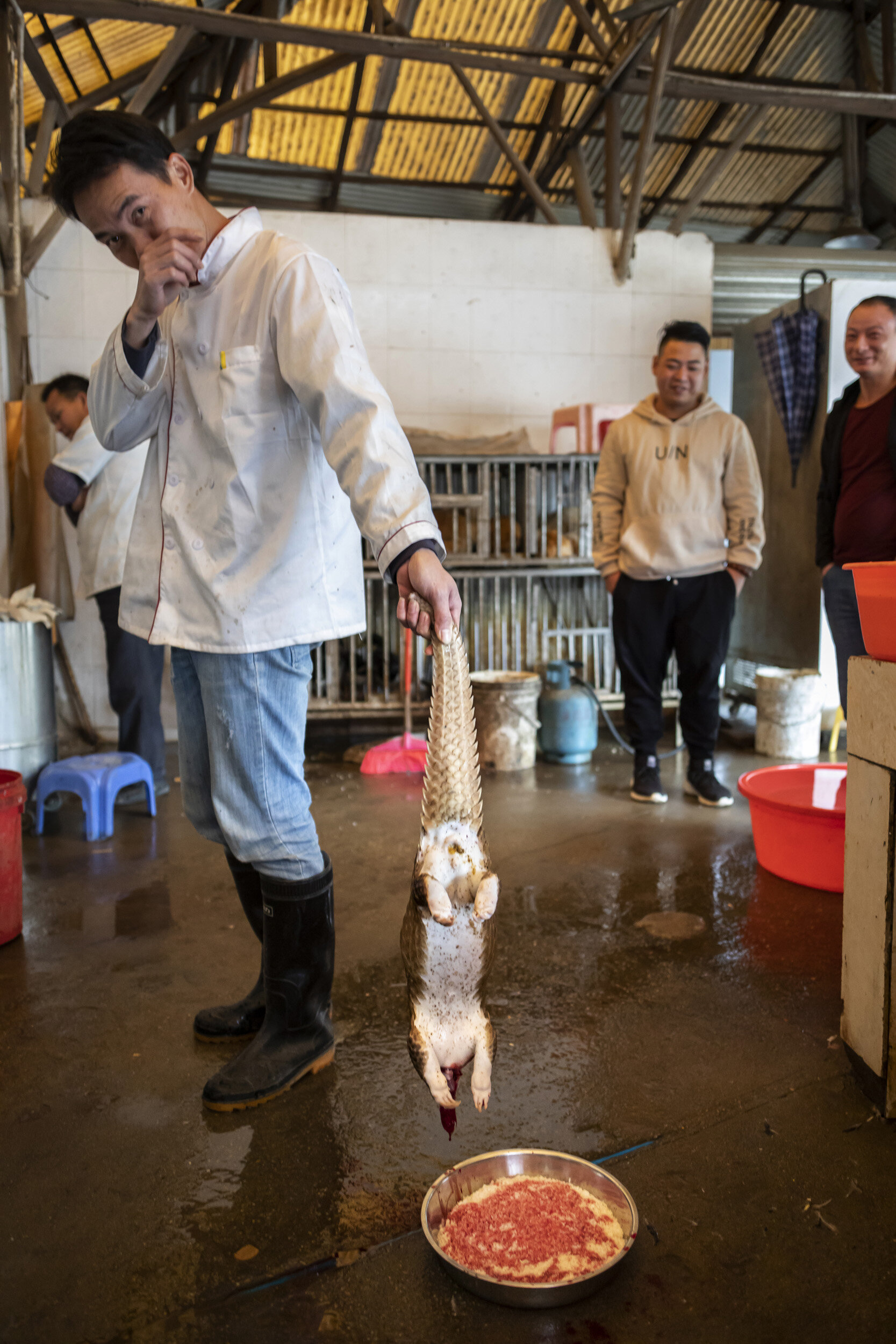
GUANGZHOU, CHINA: A Pangolin is slaughtered and prepared for a meal in a restaurant on the outskirts of Guangzhou. The price for the meal was 1200 RMB per pound of the animals weight. This pangolin was 6 pounds and was forcefed liquids before being weighed to drive the price higher. The price of the meal was 8000 RMB in total, around $1142. We were led to this restaurant by the second taxi driver we asked, the first one also said it was no problem but the owner was not able to provide a private room. It appears that it is not difficult to access these animals in this part of china. The taxi driver who broght the photographer to this restaurant says he used to be a truck driver and has brought these animals into Guangzhou from the Vietnam/China border area before. Law enforcement is apparently more lax in border regions. He said he used to buy them for around 1800 RMB and sell them for 2800 to restaurants. The restaurant owner said she only sells them live, people don’t want to buy them frozen.
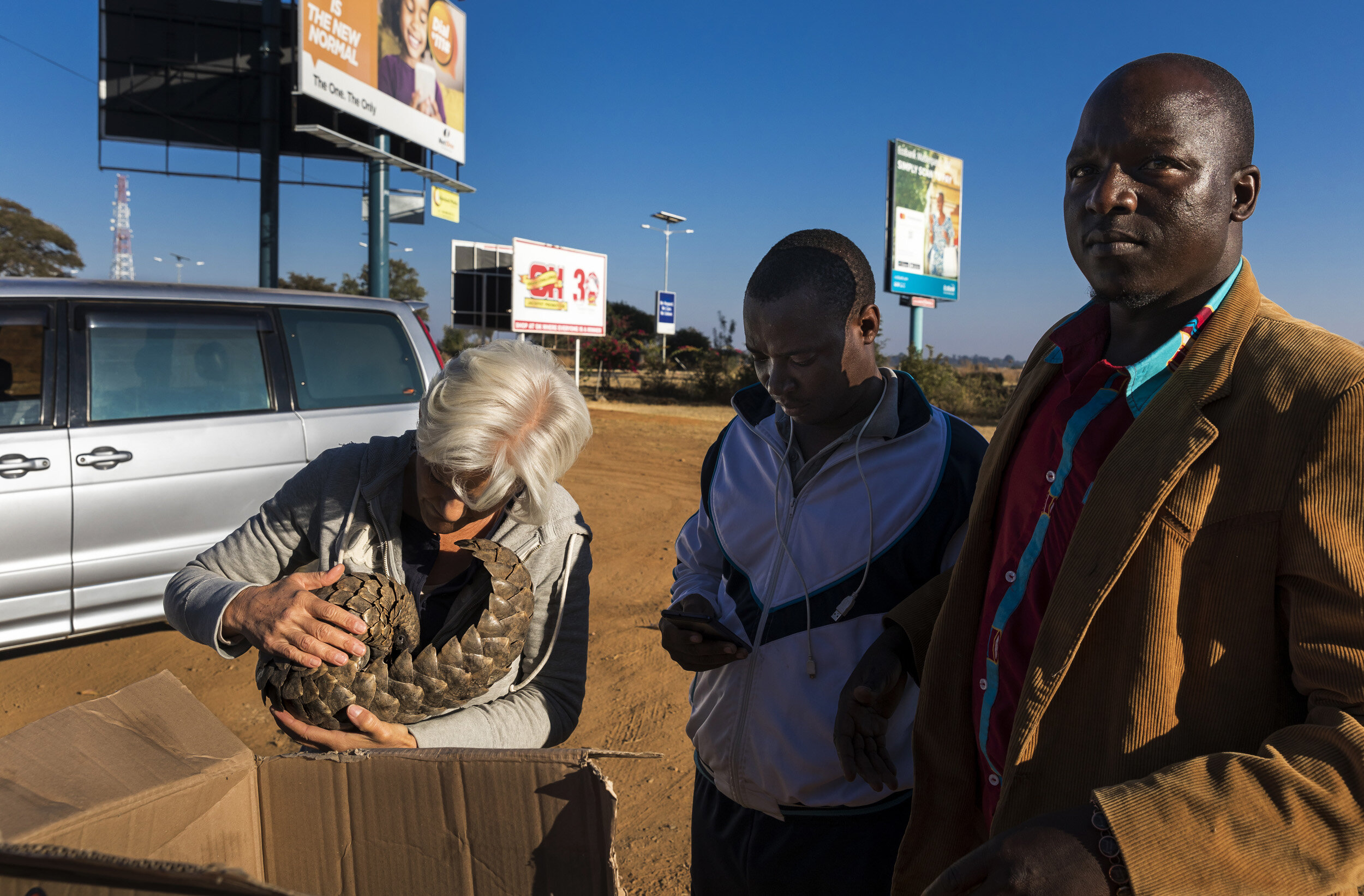
HARARE, ZIMBABWE, 24 JUNE 2018: Lisa Hywood of the Tiki Hywood trust receives a confiscated pangolin from police officers from the Minerals and Border Control division. A Mozambican man was seen sneaking over the border by a Zimbabwean soldier. The man dropped his bag and ran, inside the bag was this juvenile pangolin. These police officers drove 4 hours into Harare from the border in their own vehicle to give the pangolin to Lisa who they know as the resident Pangolin expert. The Trust undertakes public awareness campaigns on Pangolins, trains law enforcement and judiciary personnel, conducts research, and rehabilitates pangolins that have been confiscated from the illegal trade. They are based in Zimbabwe but operate with partners across Africa and advise in Asia. Founder Lisa Hywood is seen as a global expert on how to care for Pangolins in captivity. The trust also engages with other organisations and governments throughout Africa to highlight the plight of pangolins, raising awareness of their conservation status and educating them as to the need for conserving pangolins, as well as implementing conservation actions. Many of their activities are not covered by research grants and they rely on sponsors and donations to continue their work. Donations are used to train law enforcement and judiciary personnel, rehabilitate confiscated pangolins, raise public awareness and further engage with African role-players to increase the conservation status of pangolins across Africa.The Pangolin is a solitary, primarily nocturnal animal, they are easily recognized by their full armour of large, plate-like scales. A startled pangolin will cover its head with its front legs, exposing its scales to any potential predator. If touched or grabbed it will roll up completely into a ball, while the sharp scales on the tail can be used to lash out.Pangolins are also mammals just like humans, giving birth to live offspring and feeding them milk. The Pangolin uses its powerful front c
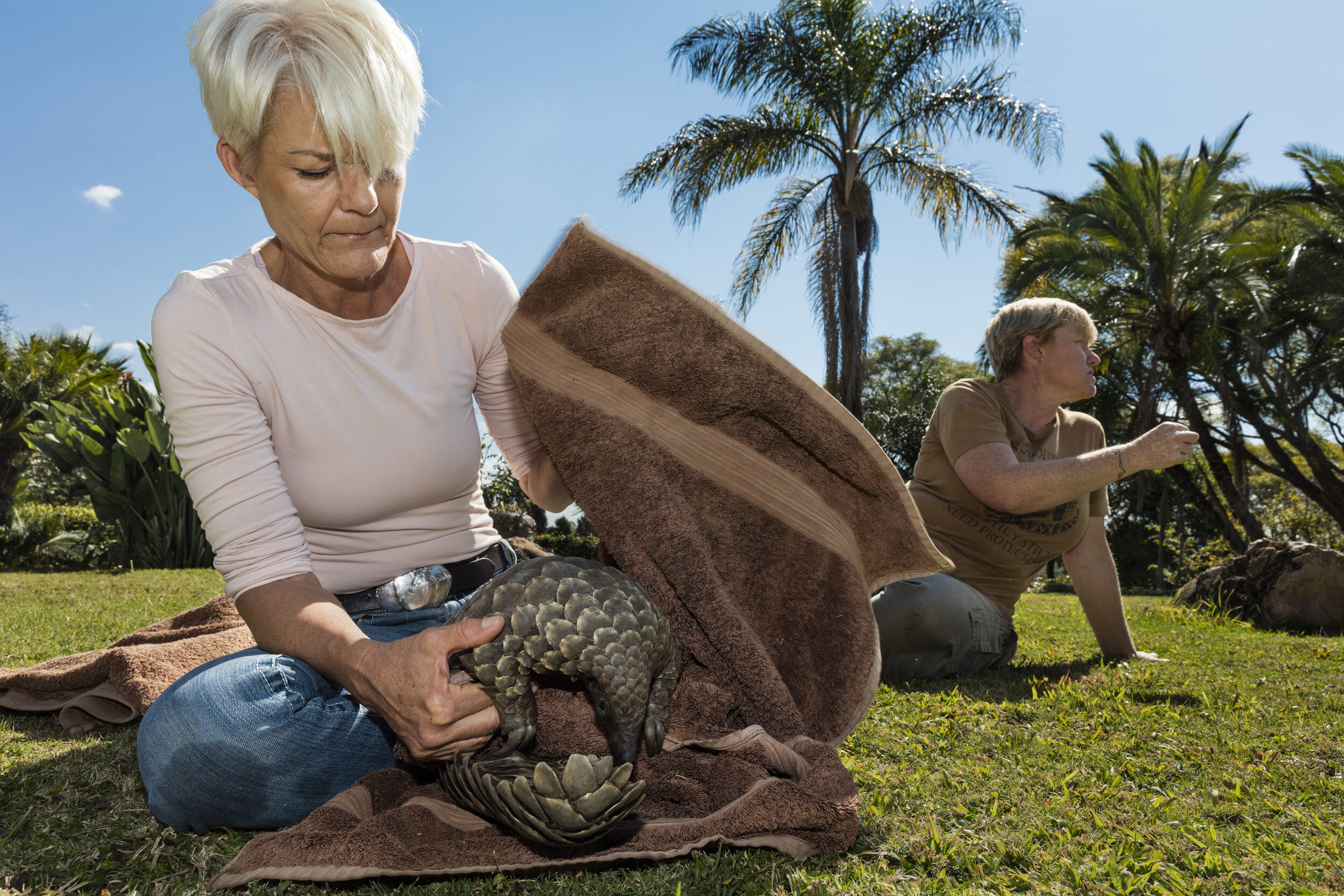
HARARE, ZIMBABWE, 24 JUNE 2018: Lisa Hywood and her Zoologist partner Ellen Connelly, care for a confiscated juvenile pangolin border police just handed over to their care.The Tiki Hywood trust undertakes public awareness campaigns on Pangolins, trains law enforcement and judiciary personnel, conducts research, and rehabilitates pangolins that have been confiscated from the illegal trade. They are based in Zimbabwe but operate with partners across Africa and advise in Asia. Founder Lisa Hywood is seen as a global expert on how to care for Pangolins in captivity. The trust also engages with other organisations and governments throughout Africa to highlight the plight of pangolins, raising awareness of their conservation status and educating them as to the need for conserving pangolins, as well as implementing conservation actions. Many of their activities are not covered by research grants and they rely on sponsors and donations to continue their work. Donations are used to train law enforcement and judiciary personnel, rehabilitate confiscated pangolins, raise public awareness and further engage with African role-players to increase the conservation status of pangolins across Africa.The Pangolin is a solitary, primarily nocturnal animal, they are easily recognized by their full armour of large, plate-like scales. A startled pangolin will cover its head with its front legs, exposing its scales to any potential predator. If touched or grabbed it will roll up completely into a ball, while the sharp scales on the tail can be used to lash out.Pangolins are also mammals just like humans, giving birth to live offspring and feeding them milk. The Pangolin uses its powerful front claws to dig open termite mounds and uses its long sticky tong to catch ants and termites which it feeds on, although they supplement this diet with other invertebrates. There are eight species of pangolins in the world, four of these are found on the African continent, namely the Black-bellied pan
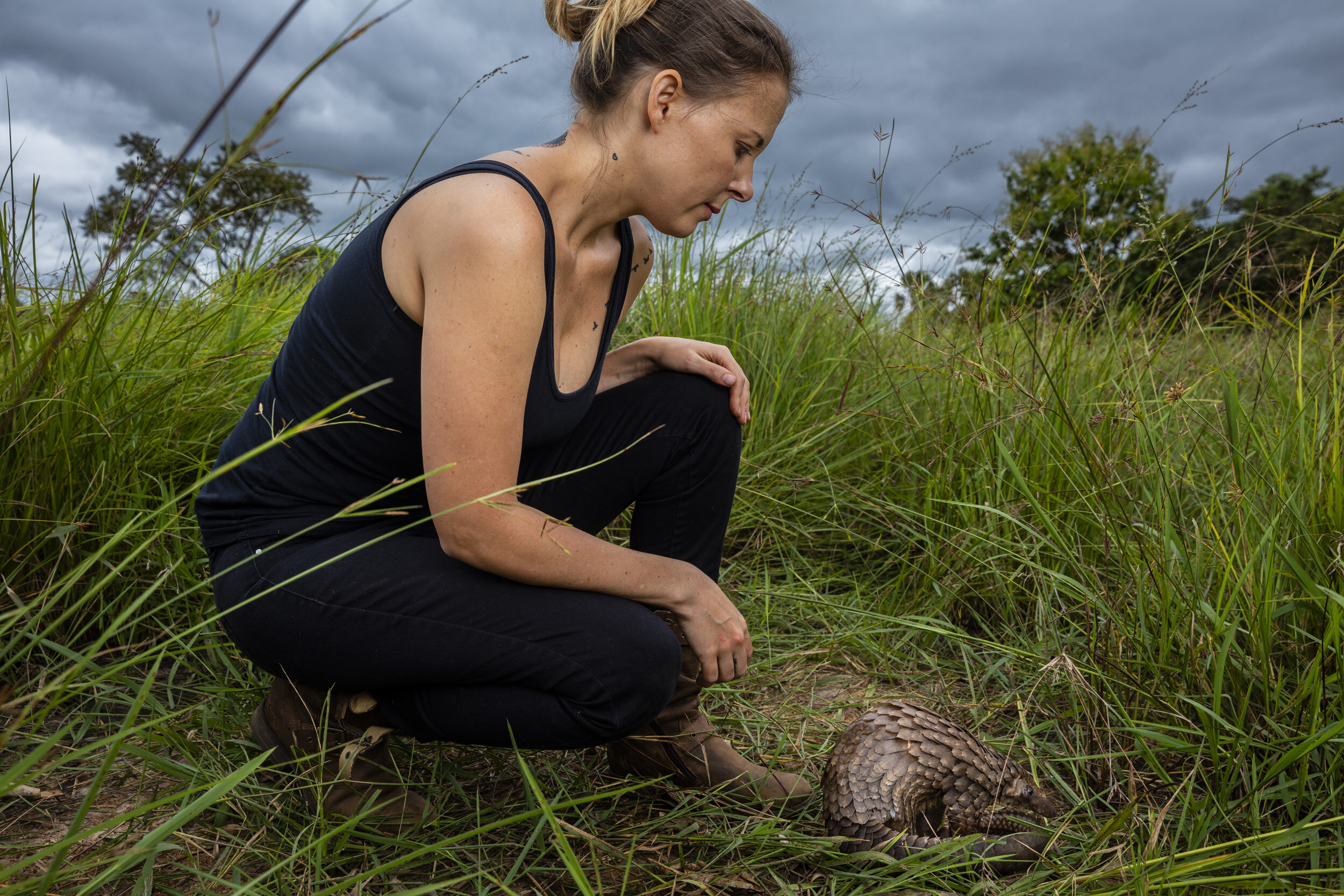
UNDISCLOSED LOCATION, CAMEROON, 14 AUGUST 2018: Angelia of the Tikki Hywood Trust releases one of three pangolins into a wild area on a farm in Cameroon. Each of these Pangolins was destined for the bushmeat market until Angelia rescued them with the help of the Cameroonian Depart of Forests. She has rescued over 60 pangolins so far and is looking to partner with Mefou, the Great Apes sanctuary in Cameroon to expand the Tikki Hywood operation. Pangolins have long been on the bushmeat menu in Cameroon and have only recently been banned by Presidential edict and recognized as CITES appendix one animals. Enforcement is lacking and scales are collected for Chinese buyers, it will not be an easy road to secure Pangolins for the future in Cameroon, one of the greatest repositories for this rare creature in the world. (Photo by Brent Stirton/Getty Images for National Geographic magazine.)
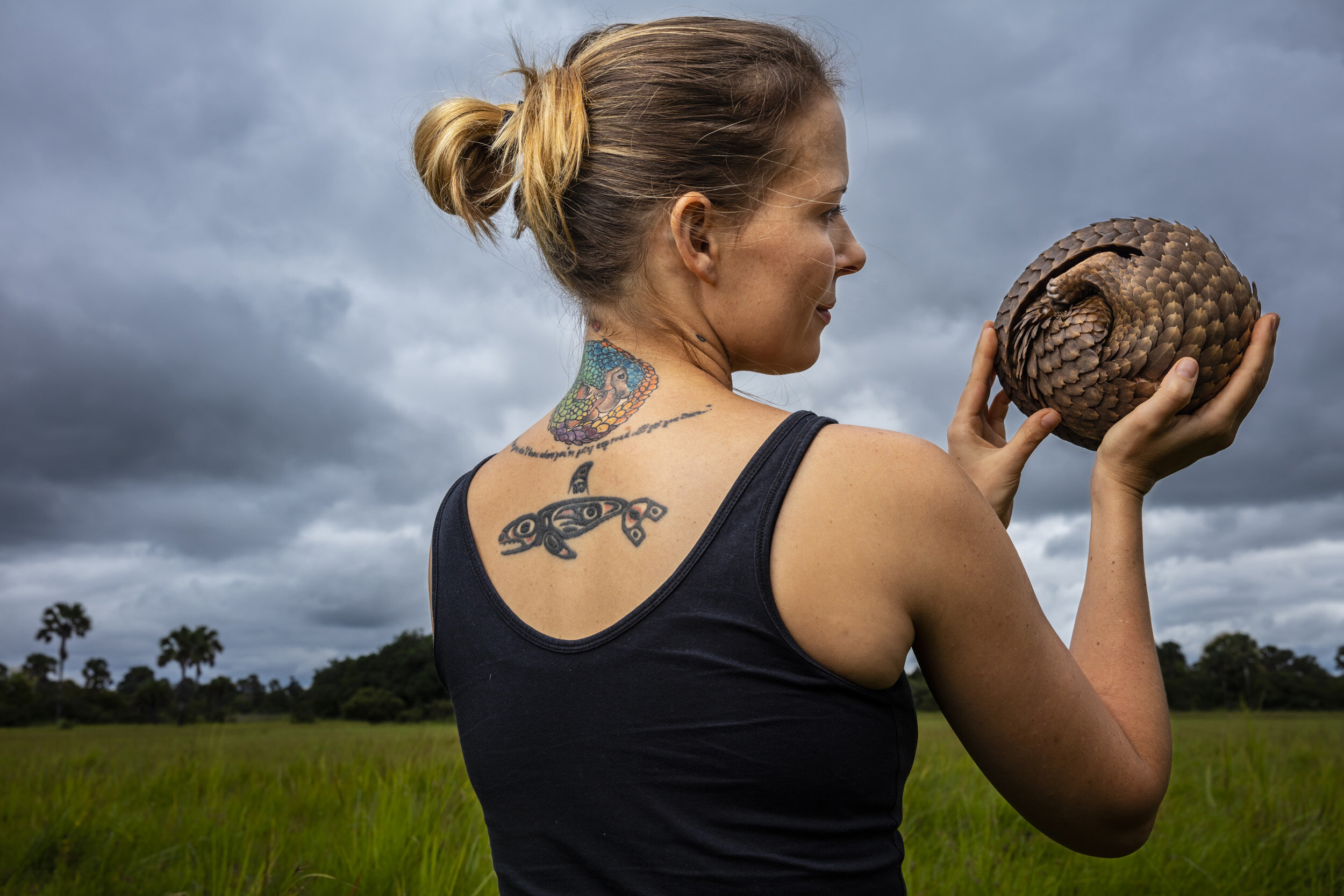
UNDISCLOSED LOCATION, CAMEROON, 14 AUGUST 2018: Angelia of the Tikki Hywood Trust releases one of three pangolins into a wild area on a farm in Cameroon. Each of these Pangolins was destined for the bushmeat market until Angelia rescued them with the help of the Cameroonian Depart of Forests. She has rescued over 60 pangolins so far and is looking to partner with Mefou, the Great Apes sanctuary in Cameroon to expand the Tikki Hywood operation. Pangolins have long been on the bushmeat menu in Cameroon and have only recently been banned by Presidential edict and recognized as CITES appendix one animals. Enforcement is lacking and scales are collected for Chinese buyers, it will not be an easy road to secure Pangolins for the future in Cameroon, one of the greatest repositories for this rare creature in the world. (Photo by Brent Stirton/Getty Images for National Geographic magazine.)
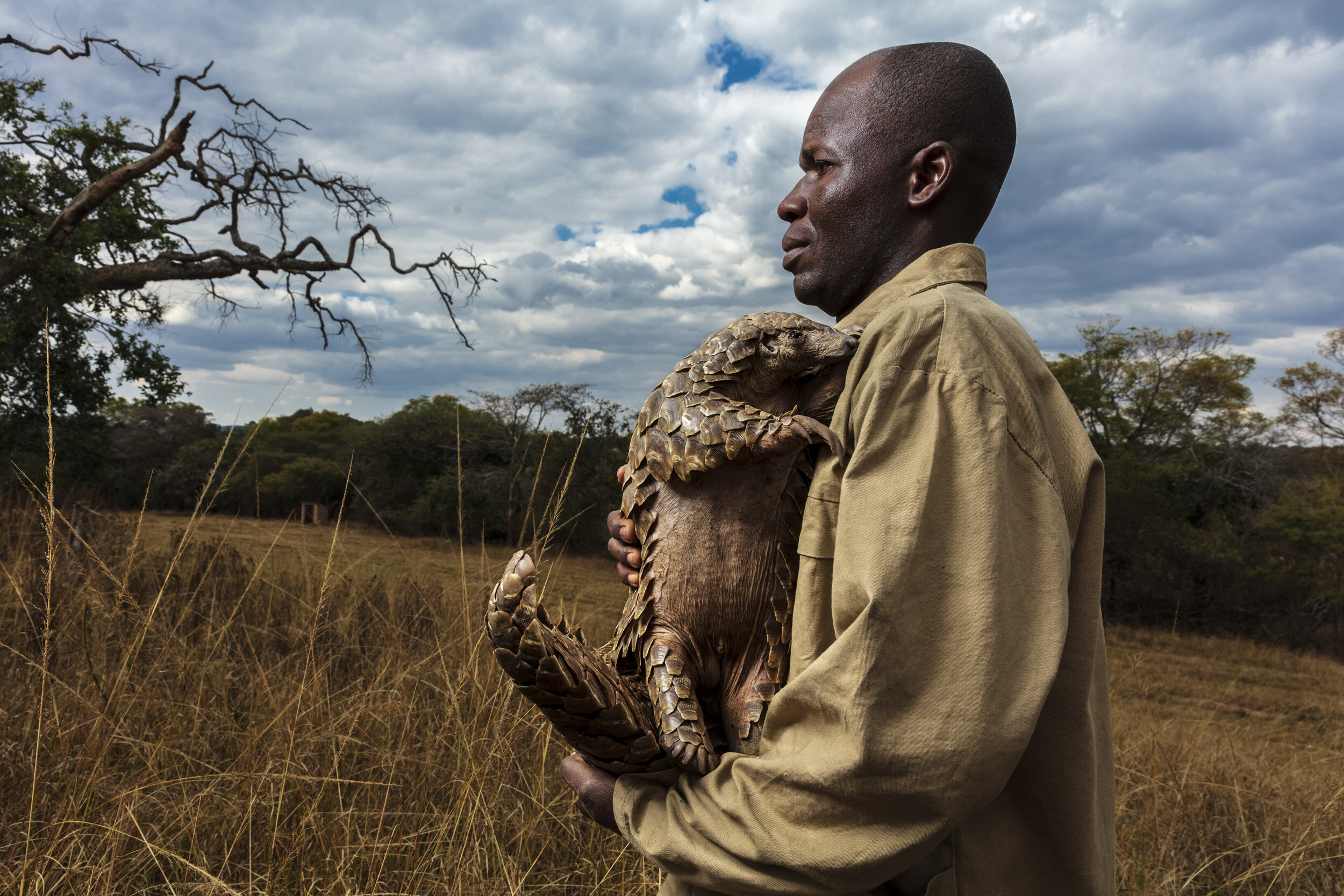
HARARE, ZIMBABWE, 24 JUNE 2018: Pangolin caregivers at an anonymous farm care for rescued pangolins, helping them to find ants and termites to eat and keeping them safe from predators and poachers. The Tiki Hywood trust undertakes public awareness campaigns on Pangolins, trains law enforcement and judiciary personnel, conducts research, and rehabilitates pangolins that have been confiscated from the illegal trade. They are based in Zimbabwe but operate with partners across Africa and advise in Asia. Founder Lisa Hywood is seen as a global expert on how to care for Pangolins in captivity. The trust also engages with other organisations and governments throughout Africa to highlight the plight of pangolins, raising awareness of their conservation status and educating them as to the need for conserving pangolins, as well as implementing conservation actions. Many of their activities are not covered by research grants and they rely on sponsors and donations to continue their work. Donations are used to train law enforcement and judiciary personnel, rehabilitate confiscated pangolins, raise public awareness and further engage with African role-players to increase the conservation status of pangolins across Africa.The Pangolin is a solitary, primarily nocturnal animal, they are easily recognized by their full armour of large, plate-like scales. A startled pangolin will cover its head with its front legs, exposing its scales to any potential predator. If touched or grabbed it will roll up completely into a ball, while the sharp scales on the tail can be used to lash out.Pangolins are also mammals just like humans, giving birth to live offspring and feeding them milk. The Pangolin uses its powerful front claws to dig open termite mounds and uses its long sticky tong to catch ants and termites which it feeds on, although they supplement this diet with other invertebrates. There are eight species of pangolins in the world, four of these are found on the African continent, na
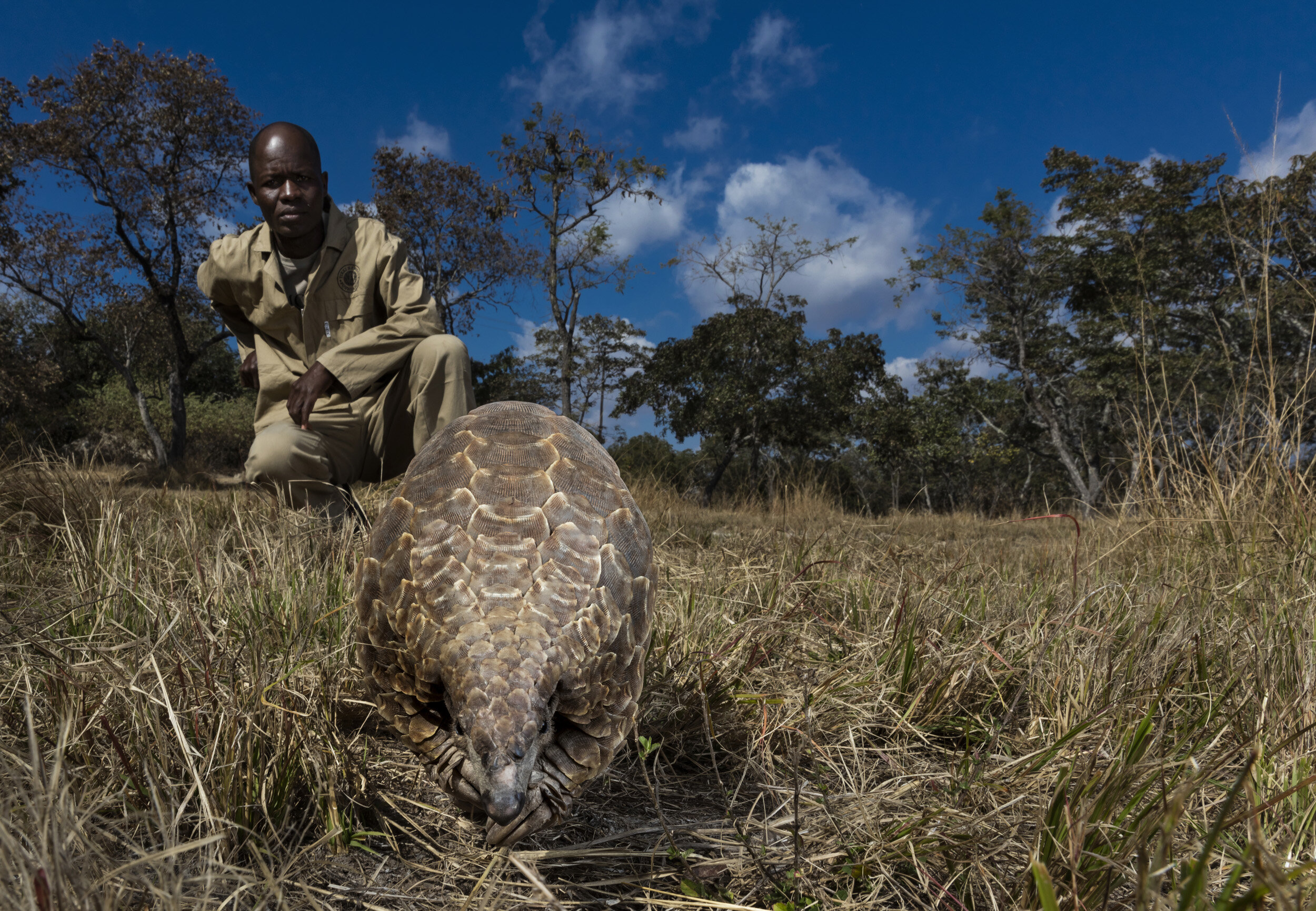
HARARE, ZIMBABWE, 24 JUNE 2018: Pangolin caregivers at an anonymous farm care for rescued pangolins, helping them to find ants and termites to eat and keeping them safe from predators and poachers. The Tiki Hywood trust undertakes public awareness campaigns on Pangolins, trains law enforcement and judiciary personnel, conducts research, and rehabilitates pangolins that have been confiscated from the illegal trade. They are based in Zimbabwe but operate with partners across Africa and advise in Asia. Founder Lisa Hywood is seen as a global expert on how to care for Pangolins in captivity. The trust also engages with other organisations and governments throughout Africa to highlight the plight of pangolins, raising awareness of their conservation status and educating them as to the need for conserving pangolins, as well as implementing conservation actions. Many of their activities are not covered by research grants and they rely on sponsors and donations to continue their work. Donations are used to train law enforcement and judiciary personnel, rehabilitate confiscated pangolins, raise public awareness and further engage with African role-players to increase the conservation status of pangolins across Africa.The Pangolin is a solitary, primarily nocturnal animal, they are easily recognized by their full armour of large, plate-like scales. A startled pangolin will cover its head with its front legs, exposing its scales to any potential predator. If touched or grabbed it will roll up completely into a ball, while the sharp scales on the tail can be used to lash out.Pangolins are also mammals just like humans, giving birth to live offspring and feeding them milk. The Pangolin uses its powerful front claws to dig open termite mounds and uses its long sticky tong to catch ants and termites which it feeds on, although they supplement this diet with other invertebrates. There are eight species of pangolins in the world, four of these are found on the African continent, na

HARARE, ZIMBABWE, 24 JUNE 2018: Pangolin caregivers at an anonymous farm care for rescued pangolins, helping them to find ants and termites to eat and keeping them safe from predators and poachers. The Tiki Hywood trust undertakes public awareness campaigns on Pangolins, trains law enforcement and judiciary personnel, conducts research, and rehabilitates pangolins that have been confiscated from the illegal trade. They are based in Zimbabwe but operate with partners across Africa and advise in Asia. Founder Lisa Hywood is seen as a global expert on how to care for Pangolins in captivity. The trust also engages with other organisations and governments throughout Africa to highlight the plight of pangolins, raising awareness of their conservation status and educating them as to the need for conserving pangolins, as well as implementing conservation actions. Many of their activities are not covered by research grants and they rely on sponsors and donations to continue their work. Donations are used to train law enforcement and judiciary personnel, rehabilitate confiscated pangolins, raise public awareness and further engage with African role-players to increase the conservation status of pangolins across Africa.The Pangolin is a solitary, primarily nocturnal animal, they are easily recognized by their full armour of large, plate-like scales. A startled pangolin will cover its head with its front legs, exposing its scales to any potential predator. If touched or grabbed it will roll up completely into a ball, while the sharp scales on the tail can be used to lash out.Pangolins are also mammals just like humans, giving birth to live offspring and feeding them milk. The Pangolin uses its powerful front claws to dig open termite mounds and uses its long sticky tong to catch ants and termites which it feeds on, although they supplement this diet with other invertebrates. There are eight species of pangolins in the world, four of these are found on the African continent, na
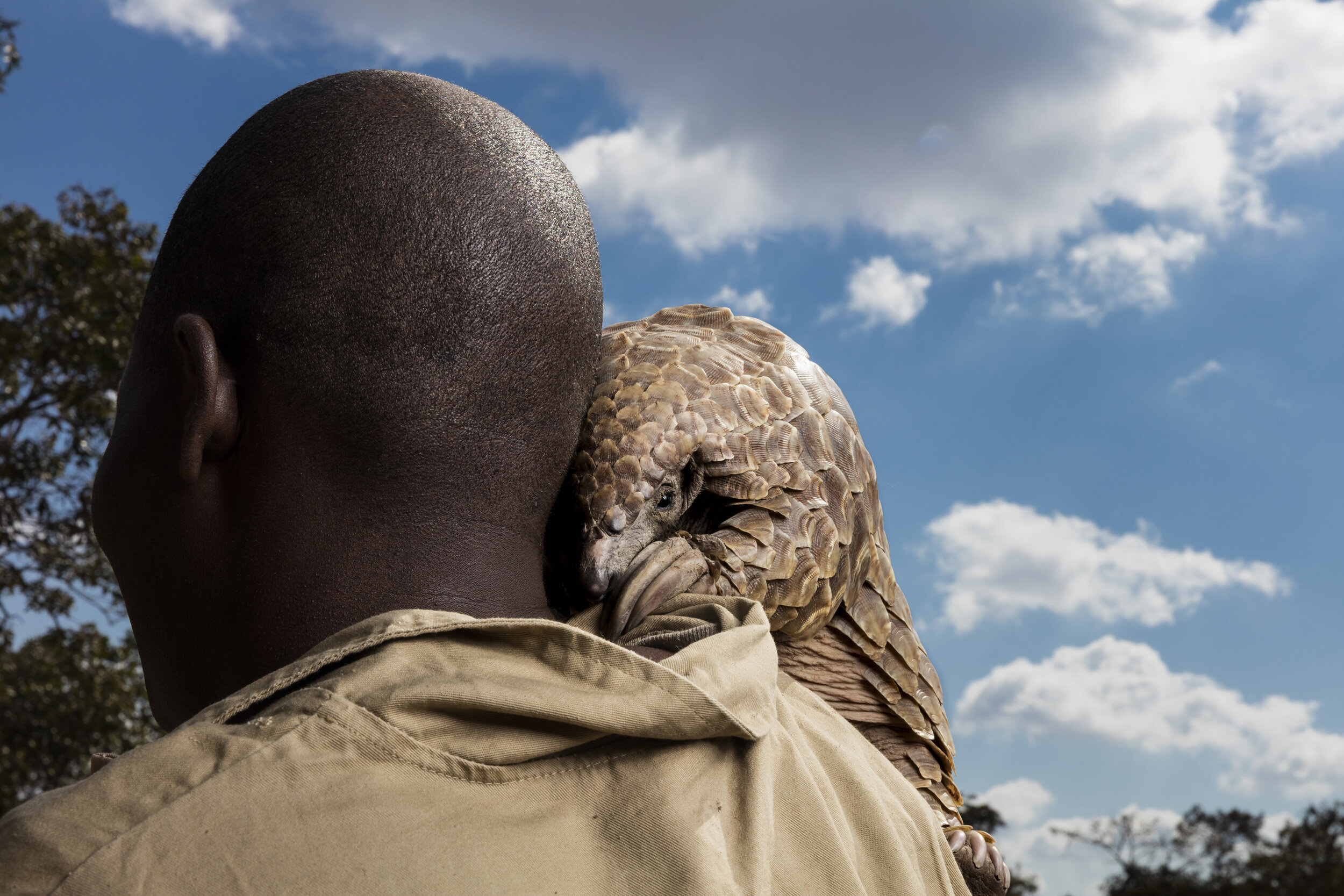
HARARE, ZIMBABWE, 24 JUNE 2018: Pangolin caregivers at an anonymous farm care for rescued pangolins, helping them to find ants and termites to eat and keeping them safe from predators and poachers. The Tiki Hywood trust undertakes public awareness campaigns on Pangolins, trains law enforcement and judiciary personnel, conducts research, and rehabilitates pangolins that have been confiscated from the illegal trade. They are based in Zimbabwe but operate with partners across Africa and advise in Asia. Founder Lisa Hywood is seen as a global expert on how to care for Pangolins in captivity. The trust also engages with other organisations and governments throughout Africa to highlight the plight of pangolins, raising awareness of their conservation status and educating them as to the need for conserving pangolins, as well as implementing conservation actions. Many of their activities are not covered by research grants and they rely on sponsors and donations to continue their work. Donations are used to train law enforcement and judiciary personnel, rehabilitate confiscated pangolins, raise public awareness and further engage with African role-players to increase the conservation status of pangolins across Africa.The Pangolin is a solitary, primarily nocturnal animal, they are easily recognized by their full armour of large, plate-like scales. A startled pangolin will cover its head with its front legs, exposing its scales to any potential predator. If touched or grabbed it will roll up completely into a ball, while the sharp scales on the tail can be used to lash out.Pangolins are also mammals just like humans, giving birth to live offspring and feeding them milk. The Pangolin uses its powerful front claws to dig open termite mounds and uses its long sticky tong to catch ants and termites which it feeds on, although they supplement this diet with other invertebrates. There are eight species of pangolins in the world, four of these are found on the African continent, na

































































HARARE, ZIMBABWE, 24 JUNE 2018: Pangolin caregivers at an anonymous farm care for rescued pangolins, helping them to find ants and termites to eat and keeping them safe from predators and poachers. The Tiki Hywood trust undertakes public awareness campaigns on Pangolins, trains law enforcement and judiciary personnel, conducts research, and rehabilitates pangolins that have been confiscated from the illegal trade. They are based in Zimbabwe but operate with partners across Africa and advise in Asia. Founder Lisa Hywood is seen as a global expert on how to care for Pangolins in captivity. The trust also engages with other organisations and governments throughout Africa to highlight the plight of pangolins, raising awareness of their conservation status and educating them as to the need for conserving pangolins, as well as implementing conservation actions. Many of their activities are not covered by research grants and they rely on sponsors and donations to continue their work. Donations are used to train law enforcement and judiciary personnel, rehabilitate confiscated pangolins, raise public awareness and further engage with African role-players to increase the conservation status of pangolins across Africa.The Pangolin is a solitary, primarily nocturnal animal, they are easily recognized by their full armour of large, plate-like scales. A startled pangolin will cover its head with its front legs, exposing its scales to any potential predator. If touched or grabbed it will roll up completely into a ball, while the sharp scales on the tail can be used to lash out.Pangolins are also mammals just like humans, giving birth to live offspring and feeding them milk. The Pangolin uses its powerful front claws to dig open termite mounds and uses its long sticky tong to catch ants and termites which it feeds on, although they supplement this diet with other invertebrates. There are eight species of pangolins in the world, four of these are found on the African continent, na
HARARE, ZIMBABWE, 24 JUNE 2018: Pangolin caregivers at an anonymous farm care for rescued pangolins, helping them to find ants and termites to eat and keeping them safe from predators and poachers. The Tiki Hywood trust undertakes public awareness campaigns on Pangolins, trains law enforcement and judiciary personnel, conducts research, and rehabilitates pangolins that have been confiscated from the illegal trade. They are based in Zimbabwe but operate with partners across Africa and advise in Asia. Founder Lisa Hywood is seen as a global expert on how to care for Pangolins in captivity. The trust also engages with other organisations and governments throughout Africa to highlight the plight of pangolins, raising awareness of their conservation status and educating them as to the need for conserving pangolins, as well as implementing conservation actions. Many of their activities are not covered by research grants and they rely on sponsors and donations to continue their work. Donations are used to train law enforcement and judiciary personnel, rehabilitate confiscated pangolins, raise public awareness and further engage with African role-players to increase the conservation status of pangolins across Africa.The Pangolin is a solitary, primarily nocturnal animal, they are easily recognized by their full armour of large, plate-like scales. A startled pangolin will cover its head with its front legs, exposing its scales to any potential predator. If touched or grabbed it will roll up completely into a ball, while the sharp scales on the tail can be used to lash out.Pangolins are also mammals just like humans, giving birth to live offspring and feeding them milk. The Pangolin uses its powerful front claws to dig open termite mounds and uses its long sticky tong to catch ants and termites which it feeds on, although they supplement this diet with other invertebrates. There are eight species of pangolins in the world, four of these are found on the African continent, na
HARARE, ZIMBABWE, 24 JUNE 2018: Pangolin caregivers at an anonymous farm care for rescued pangolins, helping them to find ants and termites to eat and keeping them safe from predators and poachers. The Tiki Hywood trust undertakes public awareness campaigns on Pangolins, trains law enforcement and judiciary personnel, conducts research, and rehabilitates pangolins that have been confiscated from the illegal trade. They are based in Zimbabwe but operate with partners across Africa and advise in Asia. Founder Lisa Hywood is seen as a global expert on how to care for Pangolins in captivity. The trust also engages with other organisations and governments throughout Africa to highlight the plight of pangolins, raising awareness of their conservation status and educating them as to the need for conserving pangolins, as well as implementing conservation actions. Many of their activities are not covered by research grants and they rely on sponsors and donations to continue their work. Donations are used to train law enforcement and judiciary personnel, rehabilitate confiscated pangolins, raise public awareness and further engage with African role-players to increase the conservation status of pangolins across Africa.The Pangolin is a solitary, primarily nocturnal animal, they are easily recognized by their full armour of large, plate-like scales. A startled pangolin will cover its head with its front legs, exposing its scales to any potential predator. If touched or grabbed it will roll up completely into a ball, while the sharp scales on the tail can be used to lash out.Pangolins are also mammals just like humans, giving birth to live offspring and feeding them milk. The Pangolin uses its powerful front claws to dig open termite mounds and uses its long sticky tong to catch ants and termites which it feeds on, although they supplement this diet with other invertebrates. There are eight species of pangolins in the world, four of these are found on the African continent, na
HARARE, ZIMBABWE, 24 JUNE 2018: Pangolin caregivers at an anonymous farm care for rescued pangolins, helping them to find ants and termites to eat and keeping them safe from predators and poachers. The Tiki Hywood trust undertakes public awareness campaigns on Pangolins, trains law enforcement and judiciary personnel, conducts research, and rehabilitates pangolins that have been confiscated from the illegal trade. They are based in Zimbabwe but operate with partners across Africa and advise in Asia. Founder Lisa Hywood is seen as a global expert on how to care for Pangolins in captivity. The trust also engages with other organisations and governments throughout Africa to highlight the plight of pangolins, raising awareness of their conservation status and educating them as to the need for conserving pangolins, as well as implementing conservation actions. Many of their activities are not covered by research grants and they rely on sponsors and donations to continue their work. Donations are used to train law enforcement and judiciary personnel, rehabilitate confiscated pangolins, raise public awareness and further engage with African role-players to increase the conservation status of pangolins across Africa.The Pangolin is a solitary, primarily nocturnal animal, they are easily recognized by their full armour of large, plate-like scales. A startled pangolin will cover its head with its front legs, exposing its scales to any potential predator. If touched or grabbed it will roll up completely into a ball, while the sharp scales on the tail can be used to lash out.Pangolins are also mammals just like humans, giving birth to live offspring and feeding them milk. The Pangolin uses its powerful front claws to dig open termite mounds and uses its long sticky tong to catch ants and termites which it feeds on, although they supplement this diet with other invertebrates. There are eight species of pangolins in the world, four of these are found on the African continent, na
Cameroon, June 4 2010: A young Baka pygmy boy and a women stand by the roadside selling a pangolin and duiker antelope for bushmeat. Pangolin is a common bushmeat species in Cameroon and is the most traded animal in the illegal wildlife trade space. (Photo by Brent Stirton/Getty Images for National Geographic Magazine.)
DJA NATIONAL PARK, SALOMA, CAMEROON, 11 AUGUST 2018: A Baka pygmy woman shows pangolin scales she has collected to sell to a Bantu middleman who comes regularly to her village to purchase the scales. She received a sum of $10 for 1kg of scales but has not idea what they are used for. The Baka living inside National Parks in Cameroon have a sustainability allowance which lets them hunt within the park boundaries. They are allowed to hunt Pangolin even thought CITES has listed them as appendix one endangered. The Cameroon government has pending legislation to ban all pangolin hunting but this has not yet passed the house. Bantu middlemen are taking advantage of this loophole for Baka pangolin hunting to buy scales cheaply for Chinese partners in Cameroon, an illegal practise. They will attempt to fly the scales out of Cameroon for traditional Asian medicine. (Photo by Brent Stirton/Getty Images for National Geographic Magazine.)
YAONDE, CAMEROON, 8 AUGUST 2018: Four juvenile pangolins for sale in a bushmeat market in Yaonde, Cameroon. Although officially listed as endangered, pangolins are still heavily traded on the bushmeat market in Cameroon, one of the very few countries in the world where they are still relatively easy to find. The scales, highly prized in Asia for traditional medicine, are often kept after consumption and Cameroonian middlemen purchase those for Chinese clients who most often fly them out of the country via corrupt officials and eco guards. (Photo by Brent Stirton/Getty Images for National Geographic Magazine.)
CAMEROON, 12 AUGUST 2018: A young woman who works as a street food trader in a small town 60 miles from Yaonde is seen with a juvenile pangolin which she has purchased from a middleman for $14 who got the pangolin from bushmeat hunters. She is seen with the pangolin at her stall shortly after acquiring the live animal. She then took the animal home and slaughtered it, removing the scales and disecting the body. She says she has been selling scaels for about a year but has been selling pangolin meat for at least 10 years. She adds that it is becoming rarer to find and more expensive. At this time, this is still a legal practise in Cameroon. (Photo by Brent Stirton/Getty Images for National Geographic Magazine.)
CAMEROON, 12 AUGUST 2018: A young woman who works as a street food trader in a small town 60 miles from Yaonde is seen with a juvenile pangolin which she has purchased from a middleman for $14 who got the pangolin from bushmeat hunters. She is seen with the pangolin at her stall shortly after acquiring the live animal. She then took the animal home and slaughtered it, removing the scales and disecting the body. She says she has been selling scaels for about a year but has been selling pangolin meat for at least 10 years. She adds that it is becoming rarer to find and more expensive. At this time, this is still a legal practise in Cameroon. (Photo by Brent Stirton/Getty Images for National Geographic Magazine.)
CAMEROON, 12 AUGUST 2018: A young woman who works as a street food trader in a small town 60 miles from Yaonde is seen with a juvenile pangolin which she has purchased from a middleman for $14 who got the pangolin from bushmeat hunters. She is seen with the pangolin at her stall shortly after acquiring the live animal. She then took the animal home and slaughtered it, removing the scales and disecting the body. She says she has been selling scaels for about a year but has been selling pangolin meat for at least 10 years. She adds that it is becoming rarer to find and more expensive. At this time, this is still a legal practise in Cameroon. (Photo by Brent Stirton/Getty Images for National Geographic Magazine.)
CAMEROON, 12 AUGUST 2018: A young woman who works as a street food trader in a small town 60 miles from Yaonde is seen with a juvenile pangolin which she has purchased from a middleman for $14 who got the pangolin from bushmeat hunters. She is seen with the pangolin at her stall shortly after acquiring the live animal. She then took the animal home and slaughtered it, removing the scales and disecting the body. She says she has been selling scaels for about a year but has been selling pangolin meat for at least 10 years. She adds that it is becoming rarer to find and more expensive. At this time, this is still a legal practise in Cameroon. (Photo by Brent Stirton/Getty Images for National Geographic Magazine.)
CAMEROON, 12 AUGUST 2018: A young woman who works as a street food trader in a small town 60 miles from Yaonde is seen with a juvenile pangolin which she has purchased from a middleman for $14 who got the pangolin from bushmeat hunters. She is seen with the pangolin at her stall shortly after acquiring the live animal. She then took the animal home and slaughtered it, removing the scales and disecting the body. She says she has been selling scaels for about a year but has been selling pangolin meat for at least 10 years. She adds that it is becoming rarer to find and more expensive. At this time, this is still a legal practise in Cameroon. (Photo by Brent Stirton/Getty Images for National Geographic Magazine.)
CAMEROON, 12 AUGUST 2018: A young woman who works as a street food trader in a small town 60 miles from Yaonde is seen with a juvenile pangolin which she has purchased from a middleman for $14 who got the pangolin from bushmeat hunters. She is seen with the pangolin at her stall shortly after acquiring the live animal. She then took the animal home and slaughtered it, removing the scales and disecting the body. She says she has been selling scaels for about a year but has been selling pangolin meat for at least 10 years. She adds that it is becoming rarer to find and more expensive. At this time, this is still a legal practise in Cameroon. (Photo by Brent Stirton/Getty Images for National Geographic Magazine.)
DOUALA, CAMEROON, 18 AUGUST 2018: Members of the Ministry of Wildlife, undercover Police and undercover members of LAGA, a wildlife law enforcement agency capture a group of 5 men who tried to sell one thousand kilograms of giant pangolin scales to an undercover agent of LAGA. These are some of the most endangered Pangolins in the world. A price of $100,000.00 was negotiated for the scales before the bust. The traffickers include men from both Cameroon and Central African Republic and another Nigerian remains at large. (Photo by Brent Stirton/Getty Images for National Geographic Magazine.)
DOUALA, CAMEROON, 18 AUGUST 2018: Members of the Ministry of Wildlife, undercover Police and undercover members of LAGA, a wildlife law enforcement agency capture a group of 5 men who tried to sell one thousand kilograms of giant pangolin scales to an undercover agent of LAGA. These are some of the most endangered Pangolins in the world. A price of $100,000.00 was negotiated for the scales before the bust. The traffickers include men from both Cameroon and Central African Republic and another Nigerian remains at large. (Photo by Brent Stirton/Getty Images for National Geographic Magazine.)
DOUALA, CAMEROON, 18 AUGUST 2018: Members of the Ministry of Wildlife, undercover Police and undercover members of LAGA, a wildlife law enforcement agency capture a group of 5 men who tried to sell one thousand kilograms of giant pangolin scales to an undercover agent of LAGA. These are some of the most endangered Pangolins in the world. A price of $100,000.00 was negotiated for the scales before the bust. The traffickers include men from both Cameroon and Central African Republic and another Nigerian remains at large. (Photo by Brent Stirton/Getty Images for National Geographic Magazine.)
DOUALA, CAMEROON, 18 AUGUST 2018: Members of the Ministry of Wildlife, undercover Police and undercover members of LAGA, a wildlife law enforcement agency capture a group of 5 men who tried to sell one thousand kilograms of giant pangolin scales to an undercover agent of LAGA. These are some of the most endangered Pangolins in the world. A price of $100,000.00 was negotiated for the scales before the bust. The traffickers include men from both Cameroon and Central African Republic and another Nigerian remains at large. (Photo by Brent Stirton/Getty Images for National Geographic Magazine.)
DOUALA, CAMEROON, 18 AUGUST 2018: Members of the Ministry of Wildlife, undercover Police and undercover members of LAGA, a wildlife law enforcement agency capture a group of 5 men who tried to sell one thousand kilograms of giant pangolin scales to an undercover agent of LAGA. These are some of the most endangered Pangolins in the world. A price of $100,000.00 was negotiated for the scales before the bust. The traffickers include men from both Cameroon and Central African Republic and another Nigerian remains at large. (Photo by Brent Stirton/Getty Images for National Geographic Magazine.)
DOUALA, CAMEROON, 18 AUGUST 2018: Members of the Ministry of Wildlife, undercover Police and undercover members of LAGA, a wildlife law enforcement agency capture a group of 5 men who tried to sell one thousand kilograms of giant pangolin scales to an undercover agent of LAGA. These are some of the most endangered Pangolins in the world. A price of $100,000.00 was negotiated for the scales before the bust. The traffickers include men from both Cameroon and Central African Republic and another Nigerian remains at large. (Photo by Brent Stirton/Getty Images for National Geographic Magazine.)
DOUALA, CAMEROON, 18 AUGUST 2018: Members of the Ministry of Wildlife, undercover Police and undercover members of LAGA, a wildlife law enforcement agency capture a group of 5 men who tried to sell one thousand kilograms of giant pangolin scales to an undercover agent of LAGA. These are some of the most endangered Pangolins in the world. A price of $100,000.00 was negotiated for the scales before the bust. The traffickers include men from both Cameroon and Central African Republic and another Nigerian remains at large. (Photo by Brent Stirton/Getty Images for National Geographic Magazine.)
COTE D’IVOIRE, 28 AUGUST 2018: 3,600kgs of Pangolin scales in the car park of the offices of the Ivorian Unit for Trans National crime. The wildlife NGO Eagle worked in co-operation with this new unit to capture an Ivorian Trafficker and his 3 accomplices in a 3 ton sale of pangolin scales. They recently also arrested a Vietnamese trafficker who was caught with 23 ivory tusks from rare Forest Elephant as well as 600 kgs of Pangolin scales. Together this seizure represents a conservative estimate of over 11,000 pangolins. The Ivorian trafficker received one year of jail time and is out again as of the 1st of August, the Vietnamese man is still inside. He speaks very little French and his phone was full of illegal wildlife trade items. He says he is only in Ivory coast for this trade. Abidjan has a substantial Vietnamese population. The house where he was arrested also contained weapons and drugs belonging to a Chinese man, he was also implicated in human trafficking of Ivorian women to China. (Photo by Brent Stirton/Getty Images for National Geographic Magazine.)
COTE D’IVOIRE, 28 AUGUST 2018: 3,600kgs of Pangolin scales in the car park of the offices of the Ivorian Unit for Trans National crime. The wildlife NGO Eagle worked in co-operation with this new unit to capture an Ivorian Trafficker and his 3 accomplices in a 3 ton sale of pangolin scales. They recently also arrested a Vietnamese trafficker who was caught with 23 ivory tusks from rare Forest Elephant as well as 600 kgs of Pangolin scales. Together this seizure represents a conservative estimate of over 11,000 pangolins. The Ivorian trafficker received one year of jail time and is out again as of the 1st of August, the Vietnamese man is still inside. He speaks very little French and his phone was full of illegal wildlife trade items. He says he is only in Ivory coast for this trade. Abidjan has a substantial Vietnamese population. The house where he was arrested also contained weapons and drugs belonging to a Chinese man, he was also implicated in human trafficking of Ivorian women to China. (Photo by Brent Stirton/Getty Images for National Geographic Magazine.)
ABIDJAN, COTE D’IVOIRE, 28 AUGUST 2018: An undercover officer from a unit dedicated to Trans-national crime holds a giant pangolin exoskeleton discovered in a raid on a house in Abidjan. The raid netted two Vietnamese traffickers with 600 kgs of Pangolin scales as well as 23 ivory tusks from Forest Elephant. A Chinese man in the house was arrested for guns, drugs and is suspected of human trafficking based on document and photographs of 14 Ivorian women. The giant pangolin is a very highly endangered animal, on the red list for CITES appendix one. This exoskeleton and the tail of another larger giant pangolin were discovered in the locked room of the Chinese owner of the house, a traditonal Chinese doctor. (Photo by Brent Stirton/Getty Images for National Geographic Magazine.)
GARAMBA NATIONAL PARK, DEMOCRATIC REPUBLIC OF CONGO, APRIL 18TH 2019: ICCN conservation ranger Dog handlers receiving training on tracking and detection for ivory and pangolin scales. This pointer has just located a single pangolin scale hidden in the wall.
HANOI, VIETNAM, 3 NOVEMBER 2018: A public awareness campaign against the illegal consumption of Pangolins with Chinese star Jackie Chang is seen at Hanoi airport. There are two schools of thought with regards to these campaigns. Some Asian animal rights groups believe they can have the opposite effect and stimulate intersest in the endangered animal. (Photo by Brent Stirton/Getty Images for National Geographic Magazine)
HO CHI MINH CITY, VIETNAM, OCTOBER 4, 2011: A white bellied pangolin is seen amongst other wildlife in “wine” form in a Vietnamese Traditional Medicine shop. Vietnamese and Chinese traditional medicine has long believed that this “tonic” will be good for the person who drinks it. (Photo by Brent Stirton/National Geographic Magazine.)
HANOI, VIETNAM, 5 NOVEMBER 2018: A Vietnamese woman consults with a traditional medicine specialist over pangolin scales. The highest percentage use for the scales in TM is for help for lactating women. Pangolins are now listed as Appendix one critically endangered by CITES since the beginning of 2018 but scales are still available all over Vietnam. It is known that they are an illegal commodity but law enforcement is lax. (Photo by Brent Stirton/Getty Images for National Geographic Magazine)
DUONGLAM, VIETNAM, 6 NOVEMBER 2018: Do Doan Quat, 71, a 6th generation traditional medicine doctor, is seen with his wife Tran Thi Thanh in their home. They grind pangolin scales and mix them with other herbs to create a medicine he believes is good for tumors. He says that he has never really been sure about the efficacy of the use of Pangolin scales but that people believe in them so he uses them. He states that a lot of this kind of medicine is a testament to the power of belief. He states that the use of pangolin parts in Vietnam was so common in the past that it was like using chickens. He say the use has declined and is not so common anymore, the recent ban has moved the trade more underground. He thinks this is due to the fact that there are far less pangolin these days. He states that much of Vietnam’s traditional medicine is imported from China. The Vietnamese tend to prioritize traditional medicine but in an emergency will go for Western Medicine first. (Photo by Brent Stirton/Getty Images for National Geographic Magazine.)
GUANGZHOU, CHINA, DECEMBER 2018: Pangolin scales purchased legally from Chinese traditional medicine outlets. These scales come in whole and crushed form. The crushed version is sold in packages that look like sugar sachets. Two of the outlets that sold these scales speculated that these scales nowadays come from confiscations, they have noticed that there are fewer and fewer pangolins and that is has become harder to get the scales. These scales are used for various treatments but the biggest use remains for women who are having problems with lactation. (Photo by Brent Stirton/Getty Images.)
HIGHLANDS, LAOS, FEB 9TH, 2014: An Akha tribal woman breastfeeds her baby son. The highest percentage use of pangolin scales in traditional medicine is to aid in lactation for breastfeeding women. There is no scientific basis to this but statisically this is the most popular use of the the keratin based scales. (Photo by Brent Stirton/Getty Images for National Geographic Magazine.)
HO CHI MINH CITY, VIETNAM, 4 NOVEMBER 2018: A National Parks Veterinarian and a Veternarian from Save Vietnam’s Wildlife rescue three juvenile pangolins that were left in a box in a wasteland area in Ho Chi Minh city. SVW received an anonymous phone call saying that a man had rescued the pangolins from a trader but did not want to reveal himself. It is believed the pangolins were abandoned because they are juveniles and too small to sell to the lucrative restaurant trade and too difficult to raise to maturity. (Photo by Brent Stirton/National Geographic Magazine.)
HO CHI MINH CITY, VIETNAM, 4 NOVEMBER 2018: A National Parks Veterinarian Nguyen Van Cuong and a Veternarian from Save Vietnam’s Wildlife, Ngoc Duyen Huong, rescue three juvenile pangolins that were left in a box in a wasteland area in Ho Chi Minh city. SVW received an anonymous phone call saying that a man had rescued the pangolins from a trader but did not want to reveal himself. It is believed the pangolins were abandoned because they are juveniles and too small to sell to the lucrative restaurant trade and too difficult to raise to maturity. (Photo by Brent Stirton/National Geographic Magazine.)
HO CHI MINH CITY, VIETNAM, 4 NOVEMBER 2018: A National Parks Veterinarian Nguyen Van Cuong and a Veternarian from Save Vietnam’s Wildlife, Ngoc Duyen Huong, rescue three juvenile pangolins that were left in a box in a wasteland area in Ho Chi Minh city. SVW received an anonymous phone call saying that a man had rescued the pangolins from a trader but did not want to reveal himself. It is believed the pangolins were abandoned because they are juveniles and too small to sell to the lucrative restaurant trade and too difficult to raise to maturity. (Photo by Brent Stirton/National Geographic Magazine.)
CUC PHUONG, VIETNAM, November 2, 2018: A nervous recently rescued Pangolin that has been rescued from the illegal trade awaits release after rehab at Save Vietnam’s Wildlife headquarters in Cuc Phuong, Vietnam. SVW was founded in 2014 by Thai Van Nguyen to expand the conservation activities of the CPCP. Since then it was evolved into a organization that advocates globally and nationally for pangolins, small carnivore and all threatened species in Vietnam. It has opened Vietnam’s first pangolin and small carnivore education center and has successfully lobbied to have pangolins scales removed from the National health schemes and works with other rescues centers to raise staff capacity and animal welfare standards across Vietnam. Today SVW focuses on the rescue, rehabilitation and release of carnivores and pangolins confiscated from the illegal wildlife trade; and the development of global conservation breeding program for threatened carnivores and pangolins. (Photo by Brent Stirton/Getty Images for National Geographic Magazine.)
CUC PHUONG, VIETNAM, 8 NOVEMBER 2018: Save Vietnam’s Wildlife veterinary manager Jessica Jimerson bathes a recently arrived pangolin that has been rescued from the trafficking industry.. Most of the Pangolins that are rescued by SVW come from Indonesia and Borneo. They are often caught in snares and badly injured, then they are subjected to weeks of trafficking to Vietnam where they are highly desireably in high end restaurants or go on to the northern border with China where they are more lucrative. SVW was founded in 2014 by Thai Van Nguyen to expand the conservation activities of the CPCP. Since then it was evolved into a organization that advocates globally and nationally for pangolins, small carnivore and all threatened species in Vietnam. It has opened Vietnam’s first pangolin and small carnivore education center and has successfully lobbied to have pangolins scales removed from the National health schemes and works with other rescues centers to raise staff capacity and animal welfare standards across Vietnam. Today SVW focuses on the rescue, rehabilitation and release of carnivores and pangolins confiscated from the illegal wildlife trade; and the development of global conservation breeding program for threatened carnivores and pangolins. (Photo by Brent Stirton/Getty Images for National Geographic Magazine.)
CUC PHUONG, VIETNAM, 2 NOVEMBER 2018: Save Vietnam’s Wildlife veterinarian Lam Kim Hai rehydrates rescued, traumatized pangolins in SVW’s rehabilitation center. SVW was founded in 2014 by Thai Van Nguyen to expand the conservation activities of the CPCP. Since then it was evolved into a organization that advocates globally and nationally for pangolins, small carnivore and all threatened species in Vietnam. It has opened Vietnam’s first pangolin and small carnivore education center and has successfully lobbied to have pangolins scales removed from the National health schemes and works with other rescues centers to raise staff capacity and animal welfare standards across Vietnam. Today SVW focuses on the rescue, rehabilitation and release of carnivores and pangolins confiscated from the illegal wildlife trade; and the development of global conservation breeding program for threatened carnivores and pangolins. (Photo by Brent Stirton/Getty Images for National Geographic Magazine.)
CUC PHUONG, VIETNAM, 9 NOVEMBER 2018: Save Vietnam’s Wildlife veterinary manager Jessica Jimerson works on rehydrating a trafficked pangolin in SVW’s rehabilitation center. Most of the Pangolins that are rescued by SVW come from Indonesia and Borneo. They are often caught in snares and badly injured, then they are subjected to weeks of trafficking to Vietnam where they are highly desireably in high end restaurants or go on to the northern border with China where they are more lucrative. SVW was founded in 2014 by Thai Van Nguyen to expand the conservation activities of the CPCP. Since then it was evolved into a organization that advocates globally and nationally for pangolins, small carnivore and all threatened species in Vietnam. It has opened Vietnam’s first pangolin and small carnivore education center and has successfully lobbied to have pangolins scales removed from the National health schemes and works with other rescues centers to raise staff capacity and animal welfare standards across Vietnam. Today SVW focuses on the rescue, rehabilitation and release of carnivores and pangolins confiscated from the illegal wildlife trade; and the development of global conservation breeding program for threatened carnivores and pangolins. (Photo by Brent Stirton/Getty Images for National Geographic Magazine.)
CUC PHUONG, VIETNAM, 2 NOVEMBER 2018: Save Vietnam’s Wildlife veterinarian Lam Kim Hai works on a rescued trafficked pangolin that had it’s hind leg severely damaged in a poachers snare. He had to amputate the leg as a result. SVW was founded in 2014 by Thai Van Nguyen to expand the conservation activities of the CPCP. Since then it was evolved into a organization that advocates globally and nationally for pangolins, small carnivore and all threatened species in Vietnam. It has opened Vietnam’s first pangolin and small carnivore education center and has successfully lobbied to have pangolins scales removed from the National health schemes and works with other rescues centers to raise staff capacity and animal welfare standards across Vietnam. Today SVW focuses on the rescue, rehabilitation and release of carnivores and pangolins confiscated from the illegal wildlife trade; and the development of global conservation breeding program for threatened carnivores and pangolins. (Photo by Brent Stirton/Getty Images for National Geographic Magazine.)
CUC PHUONG, VIETNAM, 2 NOVEMBER 2018: Save Vietnam’s Wildlife veterinarian Lam Kim Hai works on a rescued trafficked pangolin that had it’s hind leg severely damaged in a poachers snare. He had to amputate the leg as a result. SVW was founded in 2014 by Thai Van Nguyen to expand the conservation activities of the CPCP. Since then it was evolved into a organization that advocates globally and nationally for pangolins, small carnivore and all threatened species in Vietnam. It has opened Vietnam’s first pangolin and small carnivore education center and has successfully lobbied to have pangolins scales removed from the National health schemes and works with other rescues centers to raise staff capacity and animal welfare standards across Vietnam. Today SVW focuses on the rescue, rehabilitation and release of carnivores and pangolins confiscated from the illegal wildlife trade; and the development of global conservation breeding program for threatened carnivores and pangolins. (Photo by Brent Stirton/Getty Images for National Geographic Magazine.)
CUC PHUONG, VIETNAM, 2 NOVEMBER 2018: Save Vietnam’s Wildlife veterinarian Lam Kim Hai works on a rescued trafficked pangolin that had it’s hind leg severely damaged in a poachers snare. He had to amputate the leg as a result. SVW was founded in 2014 by Thai Van Nguyen to expand the conservation activities of the CPCP. Since then it was evolved into a organization that advocates globally and nationally for pangolins, small carnivore and all threatened species in Vietnam. It has opened Vietnam’s first pangolin and small carnivore education center and has successfully lobbied to have pangolins scales removed from the National health schemes and works with other rescues centers to raise staff capacity and animal welfare standards across Vietnam. Today SVW focuses on the rescue, rehabilitation and release of carnivores and pangolins confiscated from the illegal wildlife trade; and the development of global conservation breeding program for threatened carnivores and pangolins. (Photo by Brent Stirton/Getty Images for National Geographic Magazine.)
CUC PHUONG, VIETNAM, 8 NOVEMBER 2018: Save Vietnam’s Wildlife veterinary manager Jessica Jimerson works on a badly injured snared pangolin in SVW’s rehabilitation center. Most of the Pangolins that are rescued by SVW come from Indonesia and Borneo. They are often caught in snares and badly injured, then they are subjected to weeks of trafficking to Vietnam where they are highly desireably in high end restaurants or go on to the northern border with China where they are more lucrative. SVW was founded in 2014 by Thai Van Nguyen to expand the conservation activities of the CPCP. Since then it was evolved into a organization that advocates globally and nationally for pangolins, small carnivore and all threatened species in Vietnam. It has opened Vietnam’s first pangolin and small carnivore education center and has successfully lobbied to have pangolins scales removed from the National health schemes and works with other rescues centers to raise staff capacity and animal welfare standards across Vietnam. Today SVW focuses on the rescue, rehabilitation and release of carnivores and pangolins confiscated from the illegal wildlife trade; and the development of global conservation breeding program for threatened carnivores and pangolins. (Photo by Brent Stirton/Getty Images for National Geographic Magazine.)
CUC PHUONG, VIETNAM, 8 NOVEMBER 2018: Save Vietnam’s Wildlife veterinary manager Jessica Jimerson works on a badly injured snared pangolin in SVW’s rehabilitation center. Most of the Pangolins that are rescued by SVW come from Indonesia and Borneo. They are often caught in snares and badly injured, then they are subjected to weeks of trafficking to Vietnam where they are highly desireably in high end restaurants or go on to the northern border with China where they are more lucrative. SVW was founded in 2014 by Thai Van Nguyen to expand the conservation activities of the CPCP. Since then it was evolved into a organization that advocates globally and nationally for pangolins, small carnivore and all threatened species in Vietnam. It has opened Vietnam’s first pangolin and small carnivore education center and has successfully lobbied to have pangolins scales removed from the National health schemes and works with other rescues centers to raise staff capacity and animal welfare standards across Vietnam. Today SVW focuses on the rescue, rehabilitation and release of carnivores and pangolins confiscated from the illegal wildlife trade; and the development of global conservation breeding program for threatened carnivores and pangolins. (Photo by Brent Stirton/Getty Images for National Geographic Magazine.)
CUC PHUONG, VIETNAM, 9 NOVEMBER 2018: Save Vietnam’s Wildlife welcomes a 2 day old pangolin baby in SVW’s rehabilitation center. Blood was seen in the enclosure so the baby was quickly inspected and placed back with the mother. This is a trafficked pangolin female and sometimes the stress causes premature birth or misscarriage. Most of the Pangolins that are rescued by SVW come from Indonesia and Borneo. They are often caught in snares and badly injured, then they are subjected to weeks of trafficking to Vietnam where they are highly desireably in high end restaurants or go on to the northern border with China where they are more lucrative. SVW was founded in 2014 by Thai Van Nguyen to expand the conservation activities of the CPCP. Since then it was evolved into a organization that advocates globally and nationally for pangolins, small carnivore and all threatened species in Vietnam. It has opened Vietnam’s first pangolin and small carnivore education center and has successfully lobbied to have pangolins scales removed from the National health schemes and works with other rescues centers to raise staff capacity and animal welfare standards across Vietnam. Today SVW focuses on the rescue, rehabilitation and release of carnivores and pangolins confiscated from the illegal wildlife trade; and the development of global conservation breeding program for threatened carnivores and pangolins. (Photo by Brent Stirton/Getty Images for National Geographic Magazine.)
CUC PHUONG, VIETNAM, 11 NOVEMBER 2018: Save Vietnam’s Wildlife founder Thai Van Nguyen readies rescued pangolins for transport in SVW’s rehabilitation center. On this occasion 25 trafficked pangolins were rescued and rehabilitated by SVW and will be releases in remote Pu Mat National Park. SVW released over 420 rescued pangolins in 2017 and will likely release more than that in 2018. Most of the Pangolins that are rescued by SVW come from Indonesia and Borneo. They are often caught in snares and badly injured, then they are subjected to weeks of trafficking to Vietnam where they are highly desireably in high end restaurants or go on to the northern border with China where they are more lucrative. SVW was founded in 2014 by Thai Van Nguyen to expand the conservation activities of the CPCP. Since then it was evolved into a organization that advocates globally and nationally for pangolins, small carnivore and all threatened species in Vietnam. It has opened Vietnam’s first pangolin and small carnivore education center and has successfully lobbied to have pangolins scales removed from the National health schemes and works with other rescues centers to raise staff capacity and animal welfare standards across Vietnam. Today SVW focuses on the rescue, rehabilitation and release of carnivores and pangolins confiscated from the illegal wildlife trade; and the development of global conservation breeding program for threatened carnivores and pangolins. (Photo by Brent Stirton/Getty Images for National Geographic Magazine.)
CUC PHUONG, VIETNAM, 11 NOVEMBER 2018: Save Vietnam’s Wildlife personel ready rescued pangolins for transport in SVW’s rehabilitation center. On this occasion 25 trafficked pangolins rescued and rehabilitated by SVW will be released in remote Pu Mat National Park. SVW released over 420 rescued pangolins in 2017 and will likely release more than that in 2018. Most of the Pangolins that are rescued by SVW come from Indonesia and Borneo. They are often caught in snares and badly injured, then they are subjected to weeks of trafficking to Vietnam where they are highly desireably in high end restaurants or go on to the northern border with China where they are more lucrative. SVW was founded in 2014 by Thai Van Nguyen to expand the conservation activities of the CPCP. Since then it was evolved into a organization that advocates globally and nationally for pangolins, small carnivore and all threatened species in Vietnam. It has opened Vietnam’s first pangolin and small carnivore education center and has successfully lobbied to have pangolins scales removed from the National health schemes and works with other rescues centers to raise staff capacity and animal welfare standards across Vietnam. Today SVW focuses on the rescue, rehabilitation and release of carnivores and pangolins confiscated from the illegal wildlife trade; and the development of global conservation breeding program for threatened carnivores and pangolins. (Photo by Brent Stirton/Getty Images for National Geographic Magazine.)
PU MAT NATIONAL PARK, VIETNAM, 11 NOVEMBER 2018: Members of Vietnam’s first Anti-poaching team and NGO Saving Vietnam’s Wildlife prepare for an evening release of 25 rescued pangolins into this remote National Park. They first feed the pangolin with ant eggs and make sure they are hydrated. They then gently carry the pangolin in boxes far upriver away from the road and release them into the bush. Save Vietnam’s Wildlife says the following about the new unit. “In 2018, we set up an Anti-Poaching Unit in Pu Mat National Park. This is being co-managed by the government and Save Vietnam’s Wildlife. This is the first ever example of a co-managed ranger unit in the country. We are now busy training this unit and making sure they have the skills needed to patrol Pu Mat National Park. This unit will also work with our community outreach team, to ensure that our awareness and education activities on illegal hunting are targeted at the right groups of people. “ The 25 trafficked pangolins were rescued and rehabilitated by n.g.o Save Vietnam’s Wildlife. SVW released over 420 rescued pangolins in 2017 and will likely release more than that in 2018. Most of the Pangolins that are rescued by SVW come from Indonesia and Borneo. They are often caught in snares and badly injured, then they are subjected to weeks of trafficking to Vietnam where they are highly desireably in high end restaurants or go on to the northern border with China where they are more lucrative. SVW was founded in 2014 by Thai Van Nguyen to expand the conservation activities of the CPCP. Since then it was evolved into a organization that advocates globally and nationally for pangolins, small carnivore and all threatened species in Vietnam. It has opened Vietnam’s first pangolin and small carnivore education center and has successfully lobbied to have pangolins scales removed from the National health schemes and works with other rescues centers to raise staff capacity and animal welfare standar
PU MAT NATIONAL PARK, VIETNAM, 11 NOVEMBER 2018: Members of Vietnam’s first Anti-poaching team and NGO Saving Vietnam’s Wildlife prepare for an evening release of 25 rescued pangolins into this remote National Park. They first feed the pangolin with ant eggs and make sure they are hydrated. They then gently carry the pangolin in boxes far upriver away from the road and release them into the bush. Save Vietnam’s Wildlife says the following about the new unit. “In 2018, we set up an Anti-Poaching Unit in Pu Mat National Park. This is being co-managed by the government and Save Vietnam’s Wildlife. This is the first ever example of a co-managed ranger unit in the country. We are now busy training this unit and making sure they have the skills needed to patrol Pu Mat National Park. This unit will also work with our community outreach team, to ensure that our awareness and education activities on illegal hunting are targeted at the right groups of people. “ The 25 trafficked pangolins were rescued and rehabilitated by n.g.o Save Vietnam’s Wildlife. SVW released over 420 rescued pangolins in 2017 and will likely release more than that in 2018. Most of the Pangolins that are rescued by SVW come from Indonesia and Borneo. They are often caught in snares and badly injured, then they are subjected to weeks of trafficking to Vietnam where they are highly desireably in high end restaurants or go on to the northern border with China where they are more lucrative. SVW was founded in 2014 by Thai Van Nguyen to expand the conservation activities of the CPCP. Since then it was evolved into a organization that advocates globally and nationally for pangolins, small carnivore and all threatened species in Vietnam. It has opened Vietnam’s first pangolin and small carnivore education center and has successfully lobbied to have pangolins scales removed from the National health schemes and works with other rescues centers to raise staff capacity and animal welfare standar
PU MAT NATIONAL PARK, VIETNAM, 11 NOVEMBER 2018: Members of Vietnam’s first Anti-poaching team and NGO Saving Vietnam’s Wildlife prepare for an evening release of 25 rescued pangolins into this remote National Park. They first feed the pangolin with ant eggs and make sure they are hydrated. They then gently carry the pangolin in boxes far upriver away from the road and release them into the bush. Save Vietnam’s Wildlife says the following about the new unit. “In 2018, we set up an Anti-Poaching Unit in Pu Mat National Park. This is being co-managed by the government and Save Vietnam’s Wildlife. This is the first ever example of a co-managed ranger unit in the country. We are now busy training this unit and making sure they have the skills needed to patrol Pu Mat National Park. This unit will also work with our community outreach team, to ensure that our awareness and education activities on illegal hunting are targeted at the right groups of people. “ The 25 trafficked pangolins were rescued and rehabilitated by n.g.o Save Vietnam’s Wildlife. SVW released over 420 rescued pangolins in 2017 and will likely release more than that in 2018. Most of the Pangolins that are rescued by SVW come from Indonesia and Borneo. They are often caught in snares and badly injured, then they are subjected to weeks of trafficking to Vietnam where they are highly desireably in high end restaurants or go on to the northern border with China where they are more lucrative. SVW was founded in 2014 by Thai Van Nguyen to expand the conservation activities of the CPCP. Since then it was evolved into a organization that advocates globally and nationally for pangolins, small carnivore and all threatened species in Vietnam. It has opened Vietnam’s first pangolin and small carnivore education center and has successfully lobbied to have pangolins scales removed from the National health schemes and works with other rescues centers to raise staff capacity and animal welfare standar
PU MAT NATIONAL PARK, VIETNAM, 11 NOVEMBER 2018: Members of Vietnam’s first Anti-poaching team and NGO Saving Vietnam’s Wildlife walk upriver and release 25 rescued pangolins into this remote National Park. They first feed the pangolin with ant eggs and make sure they are hydrated. They then gently carry the pangolins into a secure zone and release them back into the wild. In 2018 SVW released 417 Pangolins and in 2018 it will be more. (Photo by Brent Stirton/Getty Images for National Geographic magazine.)
PU MAT NATIONAL PARK, VIETNAM, 11 NOVEMBER 2018: Members of Vietnam’s first Anti-poaching team and NGO Saving Vietnam’s Wildlife walk upriver and release 25 rescued pangolins into this remote National Park. They first feed the pangolin with ant eggs and make sure they are hydrated. They then gently carry the pangolins into a secure zone and release them back into the wild. In 2018 SVW released 417 Pangolins and in 2018 it will be more. (Photo by Brent Stirton/Getty Images for National Geographic magazine.)
PU MAT NATIONAL PARK, VIETNAM, 11 NOVEMBER 2018: Members of Vietnam’s first Anti-poaching team and NGO Saving Vietnam’s Wildlife walk upriver and release 25 rescued pangolins into this remote National Park. They first feed the pangolin with ant eggs and make sure they are hydrated. They then gently carry the pangolins into a secure zone and release them back into the wild. In 2018 SVW released 417 Pangolins and in 2018 it will be more. (Photo by Brent Stirton/Getty Images for National Geographic magazine.)
PU MAT NATIONAL PARK, VIETNAM, 11 NOVEMBER 2018: Members of Vietnam’s first Anti-poaching team and NGO Saving Vietnam’s Wildlife walk upriver and release 25 rescued pangolins into this remote National Park. They first feed the pangolin with ant eggs and make sure they are hydrated. They then gently carry the pangolins into a secure zone and release them back into the wild. In 2018 SVW released 417 Pangolins and in 2018 it will be more. (Photo by Brent Stirton/Getty Images for National Geographic magazine.)
SURABAYA, BORNEO, 15 NOVEMBER 2018: A wildlife trader pangolin scales to the photographer at a bird market in Surabaya. He said he could get live pangolin for around $60 and usually had 2 or three every week. Borneo is a source country for Pangolins which are then trafficked to Vietnam, Laos and China. This trader said he did not have pangolin or pangolin scales at this time but it was not hard to get them. (Photo by Brent Stirton/Getty Images for National Geographic Magazine.)
LUMAJAN, BORNEO, 31 DECEMBER 2018: Bawr, a hunter from the Sentul Village region, approximately 3 hours east of the city of Surabaya, holds a pangolin he has brought to the city to sell to a middleman. The pangolin will either be cosumed in Surabaya and its scales used for traditional medicine or it will be trafficked into Vietnam, Laos or China where it will be worth far more. Bawr says he will bring in pangolin at least twice a week. This is illegal and pangolins are listed as Appendix 1 endangered by CITES. (Photo by Brent Stirton/Getty Images for National Geographic Magazine.)
GUANGZHOU, CHINA: A Pangolin is slaughtered and prepared for a meal in a restaurant on the outskirts of Guangzhou. The price for the meal was 1200 RMB per pound of the animals weight. This pangolin was 6 pounds and was forcefed liquids before being weighed to drive the price higher. The price of the meal was 8000 RMB in total, around $1142. We were led to this restaurant by the second taxi driver we asked, the first one also said it was no problem but the owner was not able to provide a private room. It appears that it is not difficult to access these animals in this part of china. The taxi driver who broght the photographer to this restaurant says he used to be a truck driver and has brought these animals into Guangzhou from the Vietnam/China border area before. Law enforcement is apparently more lax in border regions. He said he used to buy them for around 1800 RMB and sell them for 2800 to restaurants. The restaurant owner said she only sells them live, people don’t want to buy them frozen.
GUANGZHOU, CHINA: A Pangolin is slaughtered and prepared for a meal in a restaurant on the outskirts of Guangzhou. The price for the meal was 1200 RMB per pound of the animals weight. This pangolin was 6 pounds and was forcefed liquids before being weighed to drive the price higher. The price of the meal was 8000 RMB in total, around $1142. We were led to this restaurant by the second taxi driver we asked, the first one also said it was no problem but the owner was not able to provide a private room. It appears that it is not difficult to access these animals in this part of china. The taxi driver who broght the photographer to this restaurant says he used to be a truck driver and has brought these animals into Guangzhou from the Vietnam/China border area before. Law enforcement is apparently more lax in border regions. He said he used to buy them for around 1800 RMB and sell them for 2800 to restaurants. The restaurant owner said she only sells them live, people don’t want to buy them frozen.
GUANGZHOU, CHINA: A Pangolin is slaughtered and prepared for a meal in a restaurant on the outskirts of Guangzhou. The price for the meal was 1200 RMB per pound of the animals weight. This pangolin was 6 pounds and was forcefed liquids before being weighed to drive the price higher. The price of the meal was 8000 RMB in total, around $1142. We were led to this restaurant by the second taxi driver we asked, the first one also said it was no problem but the owner was not able to provide a private room. It appears that it is not difficult to access these animals in this part of china. The taxi driver who broght the photographer to this restaurant says he used to be a truck driver and has brought these animals into Guangzhou from the Vietnam/China border area before. Law enforcement is apparently more lax in border regions. He said he used to buy them for around 1800 RMB and sell them for 2800 to restaurants. The restaurant owner said she only sells them live, people don’t want to buy them frozen.
HARARE, ZIMBABWE, 24 JUNE 2018: Lisa Hywood of the Tiki Hywood trust receives a confiscated pangolin from police officers from the Minerals and Border Control division. A Mozambican man was seen sneaking over the border by a Zimbabwean soldier. The man dropped his bag and ran, inside the bag was this juvenile pangolin. These police officers drove 4 hours into Harare from the border in their own vehicle to give the pangolin to Lisa who they know as the resident Pangolin expert. The Trust undertakes public awareness campaigns on Pangolins, trains law enforcement and judiciary personnel, conducts research, and rehabilitates pangolins that have been confiscated from the illegal trade. They are based in Zimbabwe but operate with partners across Africa and advise in Asia. Founder Lisa Hywood is seen as a global expert on how to care for Pangolins in captivity. The trust also engages with other organisations and governments throughout Africa to highlight the plight of pangolins, raising awareness of their conservation status and educating them as to the need for conserving pangolins, as well as implementing conservation actions. Many of their activities are not covered by research grants and they rely on sponsors and donations to continue their work. Donations are used to train law enforcement and judiciary personnel, rehabilitate confiscated pangolins, raise public awareness and further engage with African role-players to increase the conservation status of pangolins across Africa.The Pangolin is a solitary, primarily nocturnal animal, they are easily recognized by their full armour of large, plate-like scales. A startled pangolin will cover its head with its front legs, exposing its scales to any potential predator. If touched or grabbed it will roll up completely into a ball, while the sharp scales on the tail can be used to lash out.Pangolins are also mammals just like humans, giving birth to live offspring and feeding them milk. The Pangolin uses its powerful front c
HARARE, ZIMBABWE, 24 JUNE 2018: Lisa Hywood and her Zoologist partner Ellen Connelly, care for a confiscated juvenile pangolin border police just handed over to their care.The Tiki Hywood trust undertakes public awareness campaigns on Pangolins, trains law enforcement and judiciary personnel, conducts research, and rehabilitates pangolins that have been confiscated from the illegal trade. They are based in Zimbabwe but operate with partners across Africa and advise in Asia. Founder Lisa Hywood is seen as a global expert on how to care for Pangolins in captivity. The trust also engages with other organisations and governments throughout Africa to highlight the plight of pangolins, raising awareness of their conservation status and educating them as to the need for conserving pangolins, as well as implementing conservation actions. Many of their activities are not covered by research grants and they rely on sponsors and donations to continue their work. Donations are used to train law enforcement and judiciary personnel, rehabilitate confiscated pangolins, raise public awareness and further engage with African role-players to increase the conservation status of pangolins across Africa.The Pangolin is a solitary, primarily nocturnal animal, they are easily recognized by their full armour of large, plate-like scales. A startled pangolin will cover its head with its front legs, exposing its scales to any potential predator. If touched or grabbed it will roll up completely into a ball, while the sharp scales on the tail can be used to lash out.Pangolins are also mammals just like humans, giving birth to live offspring and feeding them milk. The Pangolin uses its powerful front claws to dig open termite mounds and uses its long sticky tong to catch ants and termites which it feeds on, although they supplement this diet with other invertebrates. There are eight species of pangolins in the world, four of these are found on the African continent, namely the Black-bellied pan
UNDISCLOSED LOCATION, CAMEROON, 14 AUGUST 2018: Angelia of the Tikki Hywood Trust releases one of three pangolins into a wild area on a farm in Cameroon. Each of these Pangolins was destined for the bushmeat market until Angelia rescued them with the help of the Cameroonian Depart of Forests. She has rescued over 60 pangolins so far and is looking to partner with Mefou, the Great Apes sanctuary in Cameroon to expand the Tikki Hywood operation. Pangolins have long been on the bushmeat menu in Cameroon and have only recently been banned by Presidential edict and recognized as CITES appendix one animals. Enforcement is lacking and scales are collected for Chinese buyers, it will not be an easy road to secure Pangolins for the future in Cameroon, one of the greatest repositories for this rare creature in the world. (Photo by Brent Stirton/Getty Images for National Geographic magazine.)
UNDISCLOSED LOCATION, CAMEROON, 14 AUGUST 2018: Angelia of the Tikki Hywood Trust releases one of three pangolins into a wild area on a farm in Cameroon. Each of these Pangolins was destined for the bushmeat market until Angelia rescued them with the help of the Cameroonian Depart of Forests. She has rescued over 60 pangolins so far and is looking to partner with Mefou, the Great Apes sanctuary in Cameroon to expand the Tikki Hywood operation. Pangolins have long been on the bushmeat menu in Cameroon and have only recently been banned by Presidential edict and recognized as CITES appendix one animals. Enforcement is lacking and scales are collected for Chinese buyers, it will not be an easy road to secure Pangolins for the future in Cameroon, one of the greatest repositories for this rare creature in the world. (Photo by Brent Stirton/Getty Images for National Geographic magazine.)
HARARE, ZIMBABWE, 24 JUNE 2018: Pangolin caregivers at an anonymous farm care for rescued pangolins, helping them to find ants and termites to eat and keeping them safe from predators and poachers. The Tiki Hywood trust undertakes public awareness campaigns on Pangolins, trains law enforcement and judiciary personnel, conducts research, and rehabilitates pangolins that have been confiscated from the illegal trade. They are based in Zimbabwe but operate with partners across Africa and advise in Asia. Founder Lisa Hywood is seen as a global expert on how to care for Pangolins in captivity. The trust also engages with other organisations and governments throughout Africa to highlight the plight of pangolins, raising awareness of their conservation status and educating them as to the need for conserving pangolins, as well as implementing conservation actions. Many of their activities are not covered by research grants and they rely on sponsors and donations to continue their work. Donations are used to train law enforcement and judiciary personnel, rehabilitate confiscated pangolins, raise public awareness and further engage with African role-players to increase the conservation status of pangolins across Africa.The Pangolin is a solitary, primarily nocturnal animal, they are easily recognized by their full armour of large, plate-like scales. A startled pangolin will cover its head with its front legs, exposing its scales to any potential predator. If touched or grabbed it will roll up completely into a ball, while the sharp scales on the tail can be used to lash out.Pangolins are also mammals just like humans, giving birth to live offspring and feeding them milk. The Pangolin uses its powerful front claws to dig open termite mounds and uses its long sticky tong to catch ants and termites which it feeds on, although they supplement this diet with other invertebrates. There are eight species of pangolins in the world, four of these are found on the African continent, na
HARARE, ZIMBABWE, 24 JUNE 2018: Pangolin caregivers at an anonymous farm care for rescued pangolins, helping them to find ants and termites to eat and keeping them safe from predators and poachers. The Tiki Hywood trust undertakes public awareness campaigns on Pangolins, trains law enforcement and judiciary personnel, conducts research, and rehabilitates pangolins that have been confiscated from the illegal trade. They are based in Zimbabwe but operate with partners across Africa and advise in Asia. Founder Lisa Hywood is seen as a global expert on how to care for Pangolins in captivity. The trust also engages with other organisations and governments throughout Africa to highlight the plight of pangolins, raising awareness of their conservation status and educating them as to the need for conserving pangolins, as well as implementing conservation actions. Many of their activities are not covered by research grants and they rely on sponsors and donations to continue their work. Donations are used to train law enforcement and judiciary personnel, rehabilitate confiscated pangolins, raise public awareness and further engage with African role-players to increase the conservation status of pangolins across Africa.The Pangolin is a solitary, primarily nocturnal animal, they are easily recognized by their full armour of large, plate-like scales. A startled pangolin will cover its head with its front legs, exposing its scales to any potential predator. If touched or grabbed it will roll up completely into a ball, while the sharp scales on the tail can be used to lash out.Pangolins are also mammals just like humans, giving birth to live offspring and feeding them milk. The Pangolin uses its powerful front claws to dig open termite mounds and uses its long sticky tong to catch ants and termites which it feeds on, although they supplement this diet with other invertebrates. There are eight species of pangolins in the world, four of these are found on the African continent, na
HARARE, ZIMBABWE, 24 JUNE 2018: Pangolin caregivers at an anonymous farm care for rescued pangolins, helping them to find ants and termites to eat and keeping them safe from predators and poachers. The Tiki Hywood trust undertakes public awareness campaigns on Pangolins, trains law enforcement and judiciary personnel, conducts research, and rehabilitates pangolins that have been confiscated from the illegal trade. They are based in Zimbabwe but operate with partners across Africa and advise in Asia. Founder Lisa Hywood is seen as a global expert on how to care for Pangolins in captivity. The trust also engages with other organisations and governments throughout Africa to highlight the plight of pangolins, raising awareness of their conservation status and educating them as to the need for conserving pangolins, as well as implementing conservation actions. Many of their activities are not covered by research grants and they rely on sponsors and donations to continue their work. Donations are used to train law enforcement and judiciary personnel, rehabilitate confiscated pangolins, raise public awareness and further engage with African role-players to increase the conservation status of pangolins across Africa.The Pangolin is a solitary, primarily nocturnal animal, they are easily recognized by their full armour of large, plate-like scales. A startled pangolin will cover its head with its front legs, exposing its scales to any potential predator. If touched or grabbed it will roll up completely into a ball, while the sharp scales on the tail can be used to lash out.Pangolins are also mammals just like humans, giving birth to live offspring and feeding them milk. The Pangolin uses its powerful front claws to dig open termite mounds and uses its long sticky tong to catch ants and termites which it feeds on, although they supplement this diet with other invertebrates. There are eight species of pangolins in the world, four of these are found on the African continent, na
HARARE, ZIMBABWE, 24 JUNE 2018: Pangolin caregivers at an anonymous farm care for rescued pangolins, helping them to find ants and termites to eat and keeping them safe from predators and poachers. The Tiki Hywood trust undertakes public awareness campaigns on Pangolins, trains law enforcement and judiciary personnel, conducts research, and rehabilitates pangolins that have been confiscated from the illegal trade. They are based in Zimbabwe but operate with partners across Africa and advise in Asia. Founder Lisa Hywood is seen as a global expert on how to care for Pangolins in captivity. The trust also engages with other organisations and governments throughout Africa to highlight the plight of pangolins, raising awareness of their conservation status and educating them as to the need for conserving pangolins, as well as implementing conservation actions. Many of their activities are not covered by research grants and they rely on sponsors and donations to continue their work. Donations are used to train law enforcement and judiciary personnel, rehabilitate confiscated pangolins, raise public awareness and further engage with African role-players to increase the conservation status of pangolins across Africa.The Pangolin is a solitary, primarily nocturnal animal, they are easily recognized by their full armour of large, plate-like scales. A startled pangolin will cover its head with its front legs, exposing its scales to any potential predator. If touched or grabbed it will roll up completely into a ball, while the sharp scales on the tail can be used to lash out.Pangolins are also mammals just like humans, giving birth to live offspring and feeding them milk. The Pangolin uses its powerful front claws to dig open termite mounds and uses its long sticky tong to catch ants and termites which it feeds on, although they supplement this diet with other invertebrates. There are eight species of pangolins in the world, four of these are found on the African continent, na
